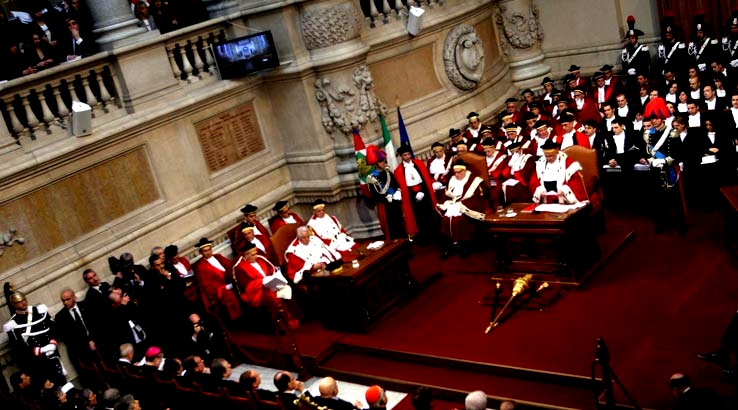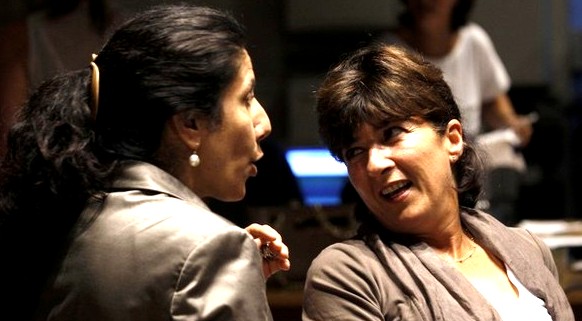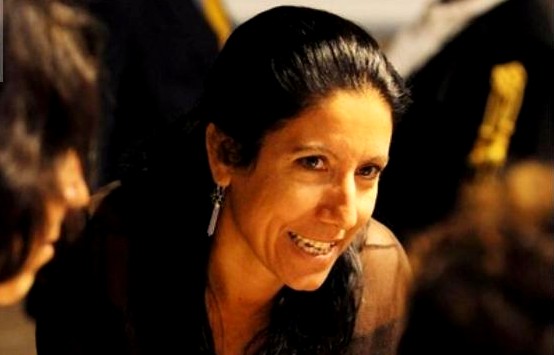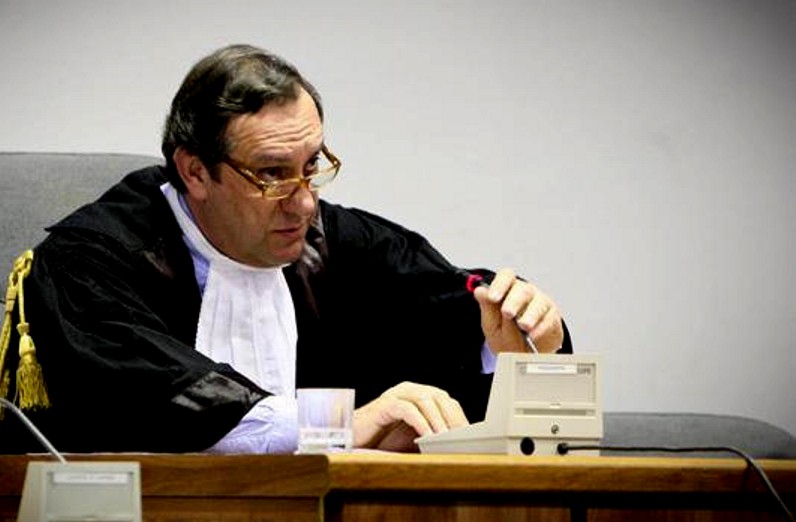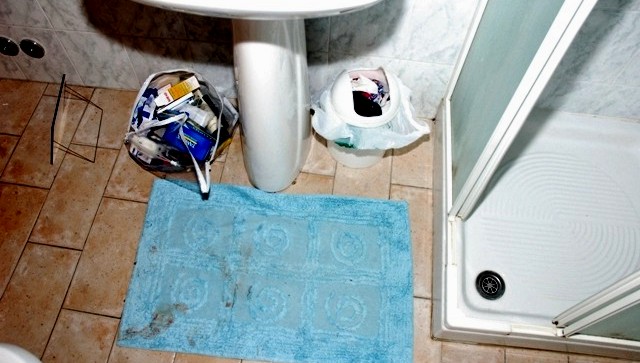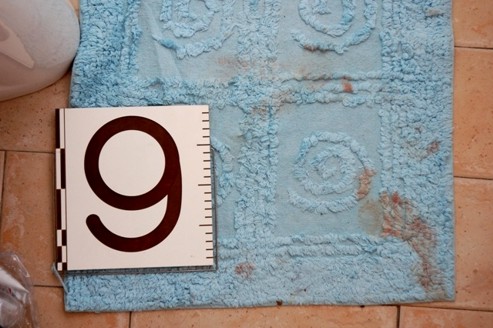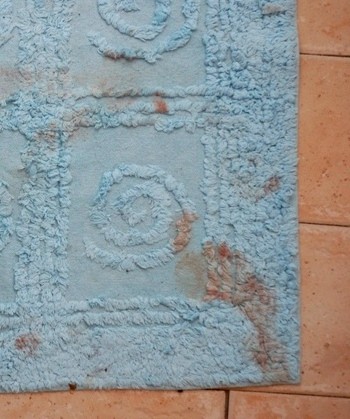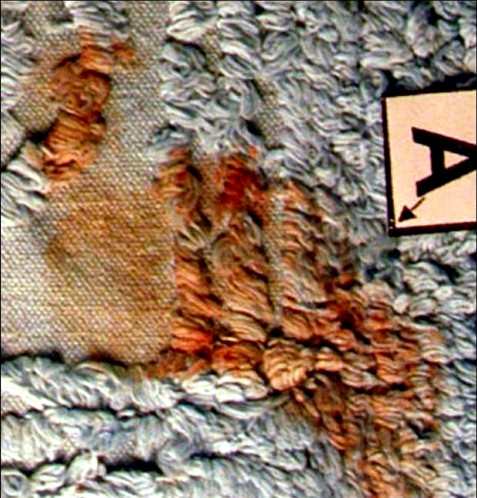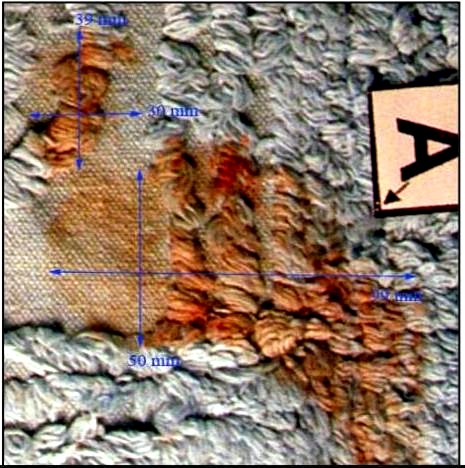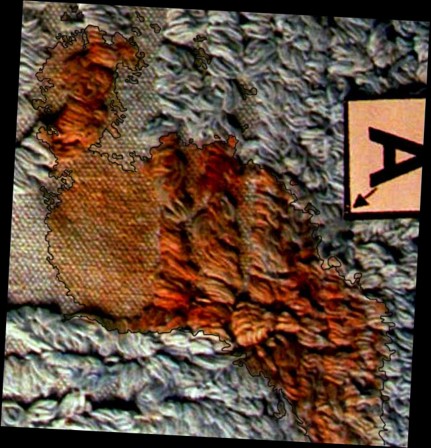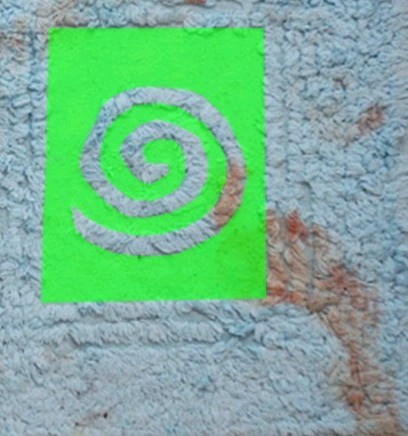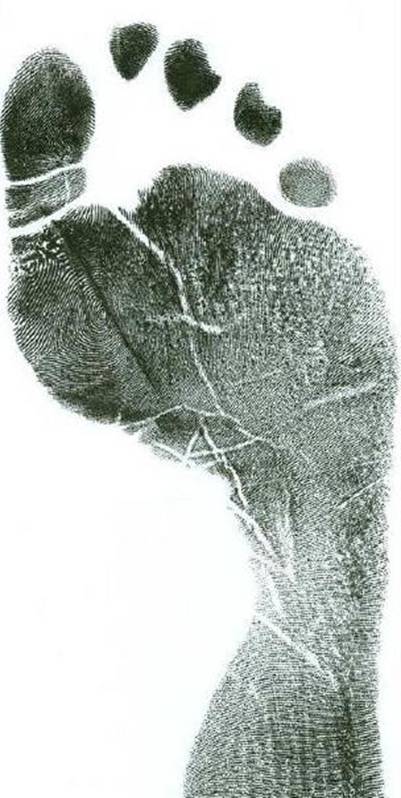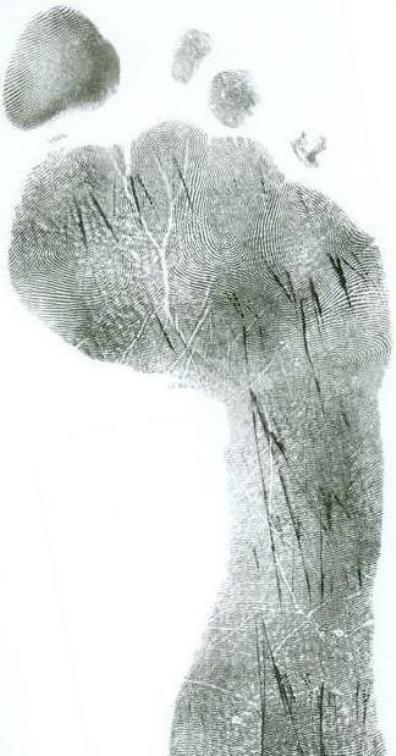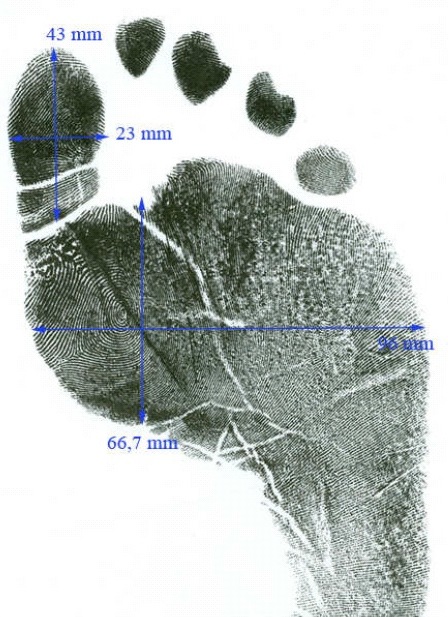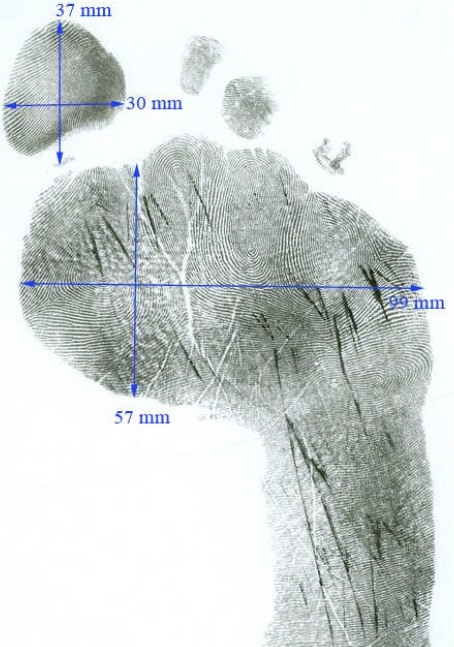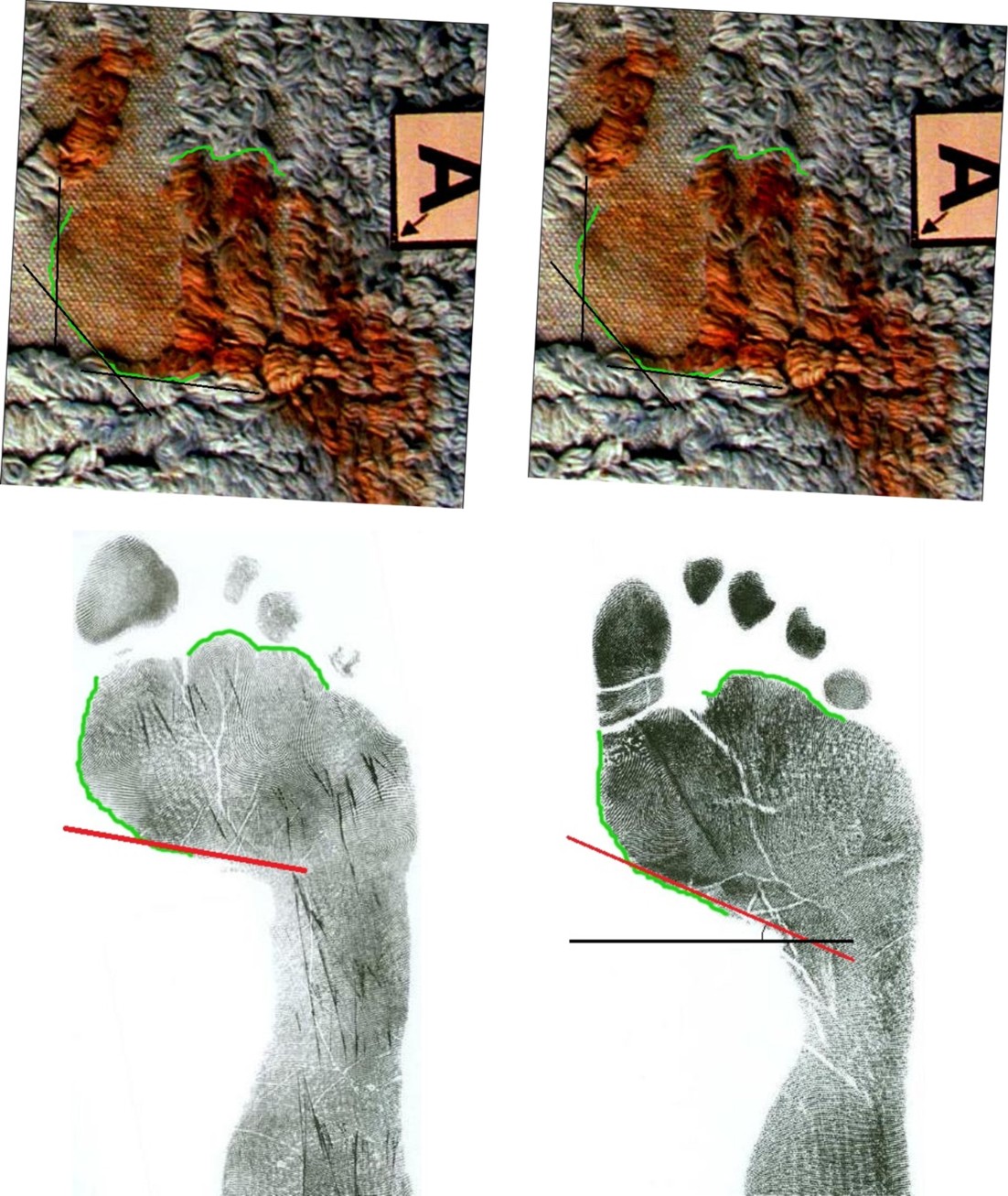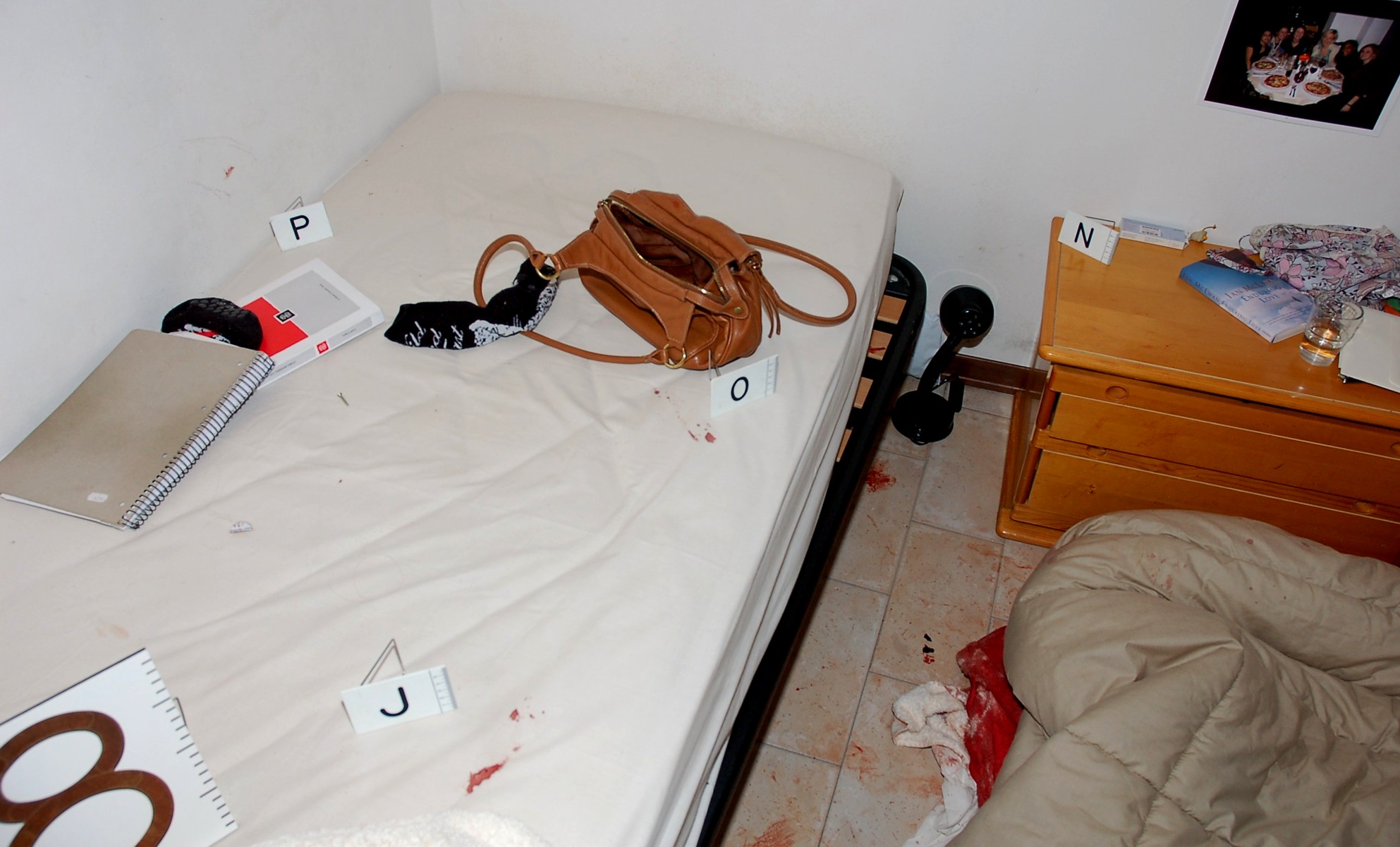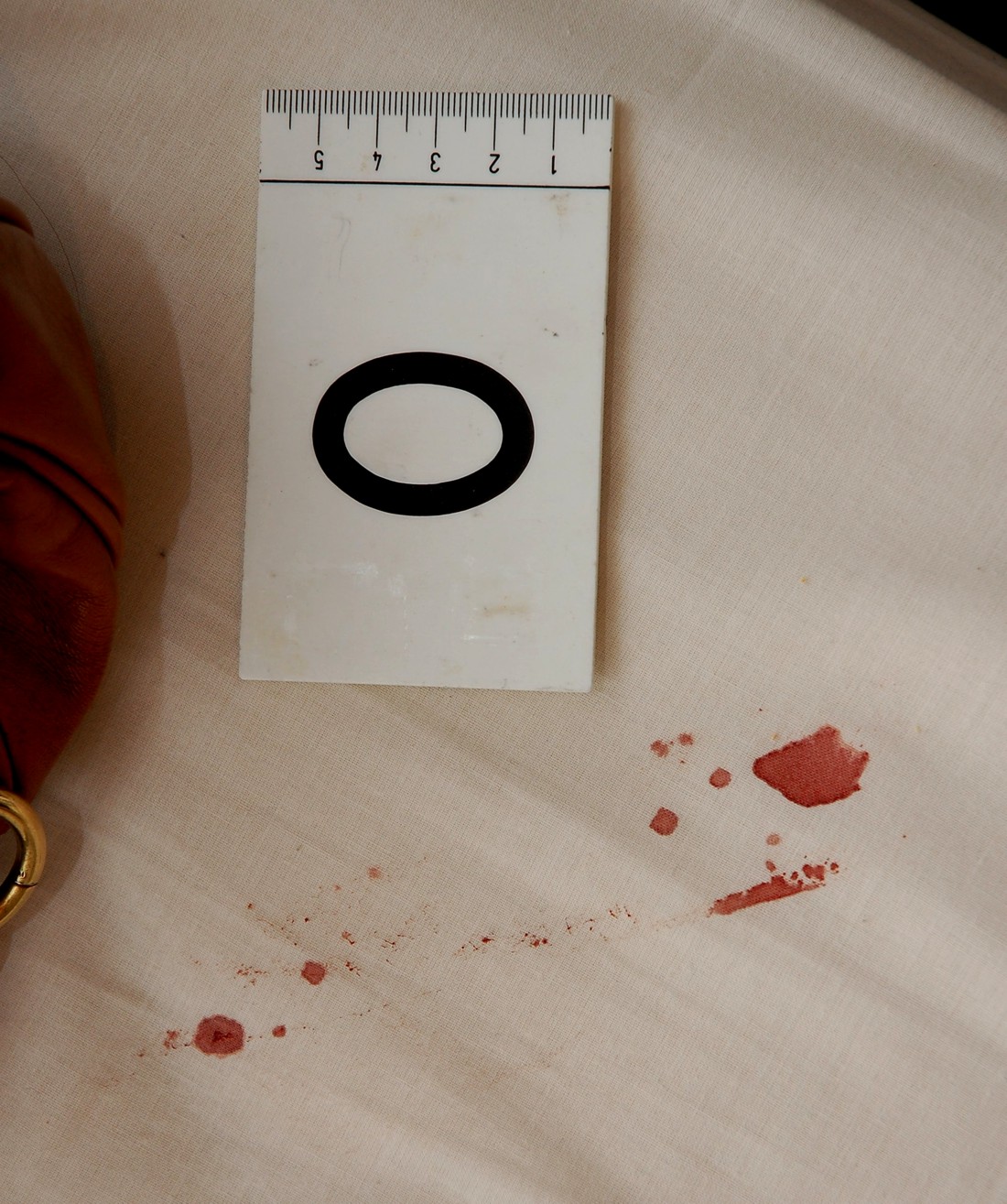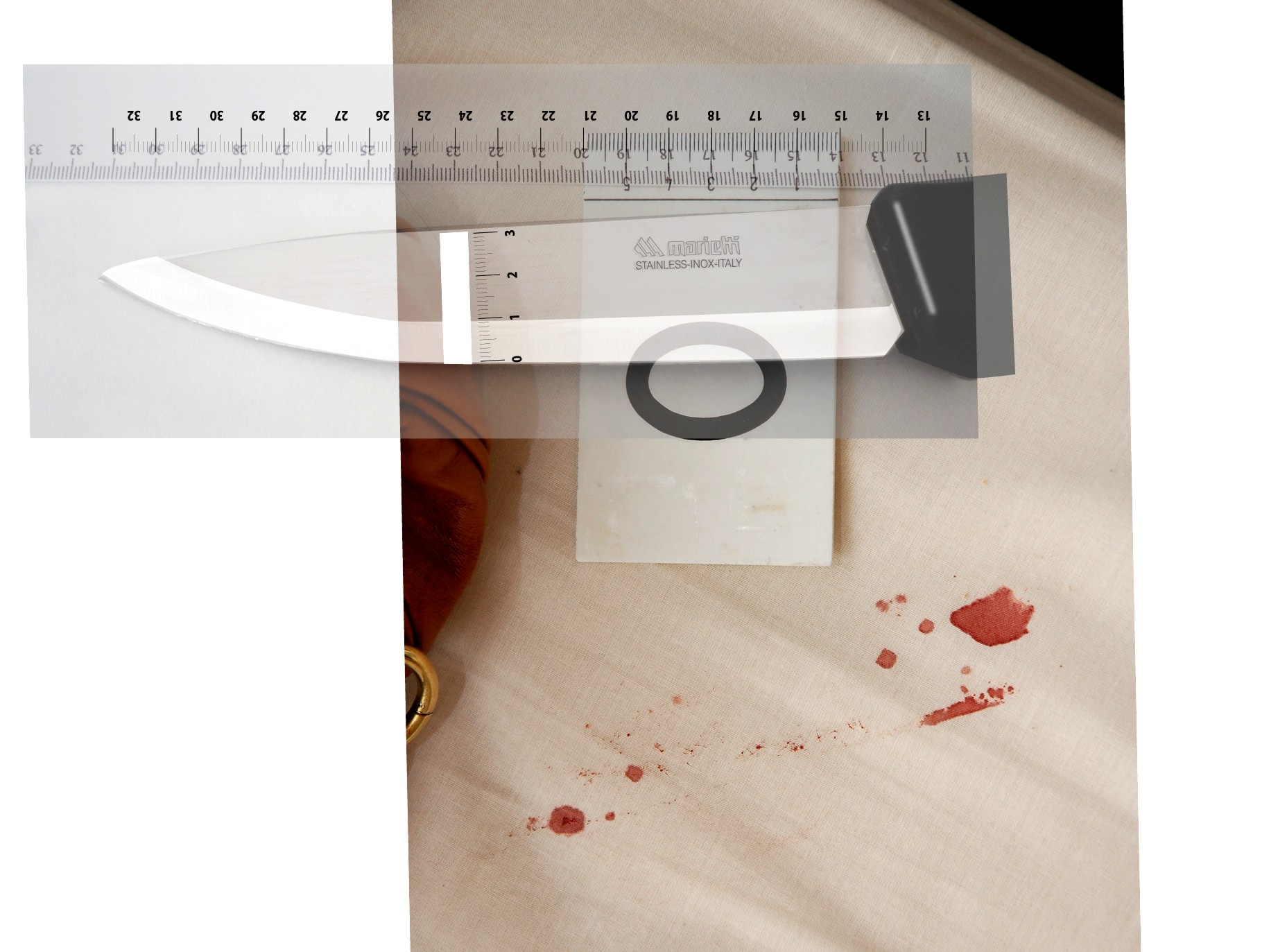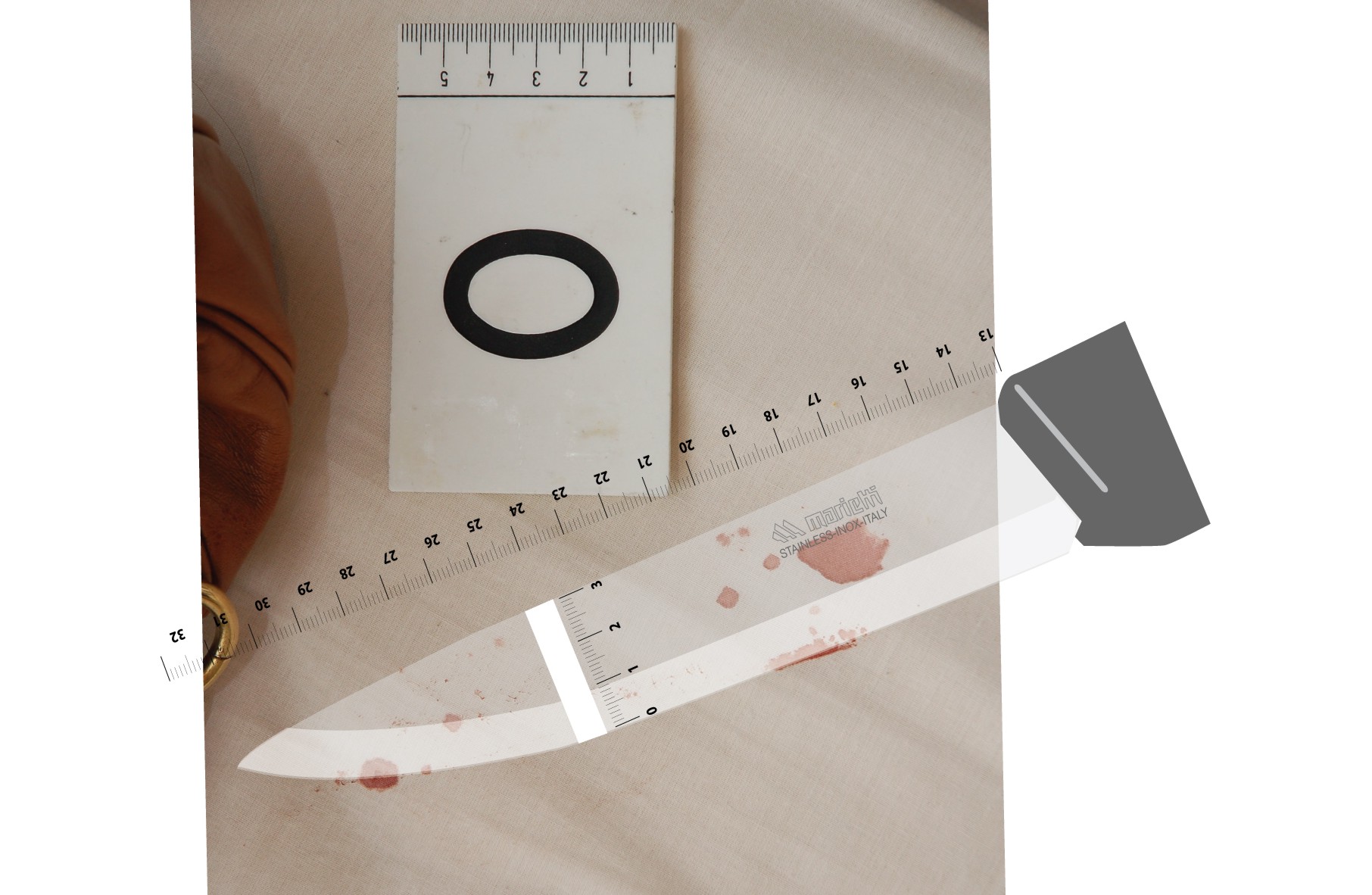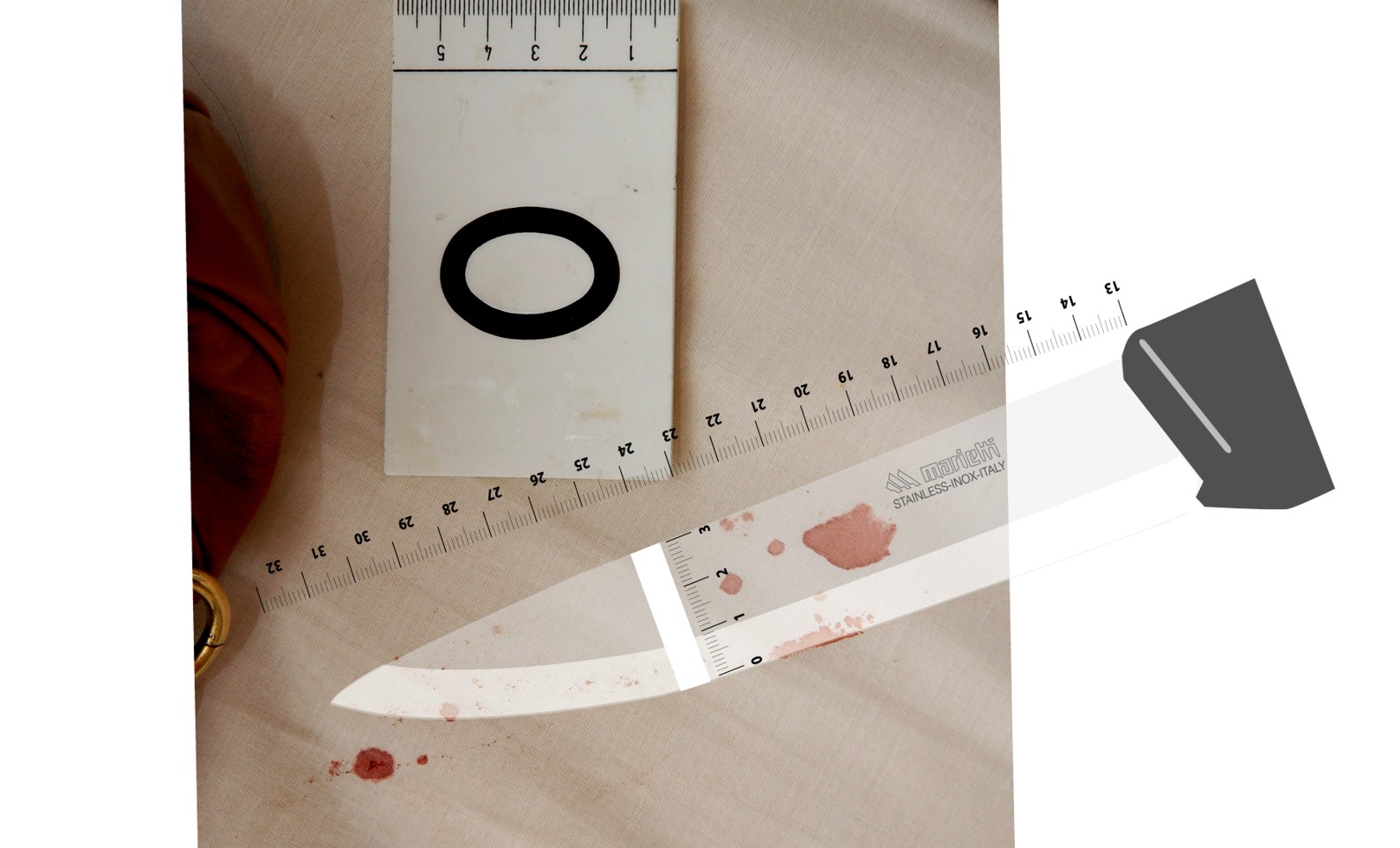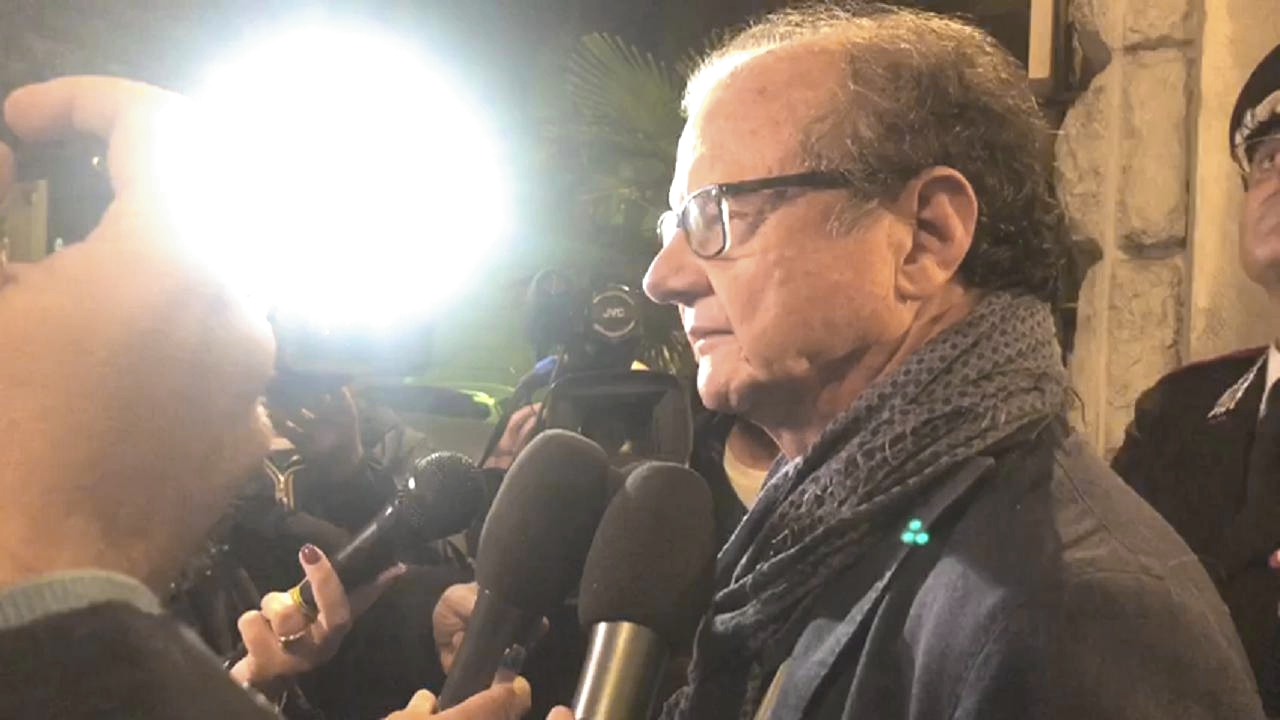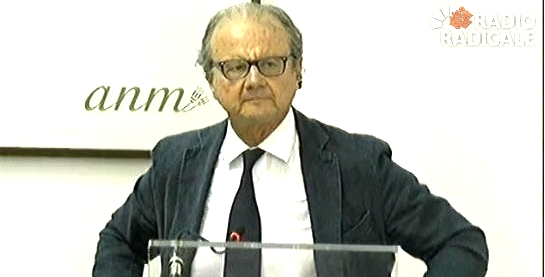
Political & economic headsup: US is demonstrating unsorted systems problems in spades. Do watch your investments. As Washington DC policy gets more & more off-target, big New York investors are betting very heavily that stocks will soon crash. Gross systems mismanagement 2017-20 tanked stocks several times.
Category: 4 No firm DNA hoax
Thursday, April 27, 2017
Multiple Attackers and the Compatibility of the Double DNA Knife (Exhibit 36)
Posted by James Raper
Our YouTube whiz DelPergola’s video of November 2010
Ed note: This evidence area is enormously compelling - but also emotionally difficult. It is why initially we did not publish our translation of the Micheli Report. And why a quarter of the trial was behind closed doors with the media excluded. That well-meaning decision has bedeviled the case ever since, because only the jury and others in court then - including the white-faced and tongue-tied accused pair - were exposed to the full power of the prosecution testimony.
Material from some of my previous posts on TJMK (link at bottom here) was incorporated into my Justice on Trial book. From Chapter 15, this is the second of several posts setting out further material.
Before looking at the forensic evidence, which is the final theme I identified earlier, it will be helpful to take into account the wounds suffered by Meredith, and whether these suggest anything as to the dynamics of the murder, and whether any of them were compatible with the knife recovered from Sollecito’s kitchen, Exhibit 36, called the Double DNA knife because the DNA of Meredith was found on the blade and the DNA of Knox on the handle.
As mentioned earlier the autopsy was carried out by Dr Lalli.
It was observed that there were no significant injuries to the chest, abdomen or lower limbs.
The significant elements in the examination were described as follows :
A fine pattern of petechiae on the internal eyelid conjunctive.
The presence of tiny areas of contusion at the level of the nose, localised around the nostrils and at the limen nasi [threshold of the nose].
Inside the mucous membranes of the lips, there were injuries compatible with a traumatic action localised in the inner surface of the lower lip and the inner surface of the upper lip, reaching up to the gum ridge.
Also found on the lower side of the jaw were some bruising injuries, and in the posterior region of the cheek as well, in proximity to the ear.
Three bruising injuries were present on the level of the lower edge of the right jaw with a roughly round shape. In the region under the jaw an area with a deep abrasion was observed, localised in the lower region of the middle part at the left of the jaw.
Once the neck had been cleaned it was possible to observe wounds that Dr Lalli attributed to the action of the point of a cutting instrument.
The main wound was located in the left lateral region of the neck. A knife would be compatible provided it had one cutting edge only which was not serrated. The wound was 8 cms in length and 8 cms deep. The width could not be measured because the edges had separated due to the elasticity of the tissues both in relation to the region and to the position of the head, which could have modified the width. The wound had a small “tail” at the posterior end. The wound penetrated into the interior structure of the neck in a slightly oblique direction, upwards and also to the right.
Underneath this large wound, another wound was visible, rather small and superficial, with not particularly clear edges, “becoming increasingly superficial until they disappeared”, in a reddish area of abrasions. The knife had penetrated both Meredith’s larynx and the cartilage of the epiglottis, and had broken her hyoid bone. A consequence of that damage is that Meredith would be unable to vocalise, let alone scream.
There was also a wound in the right lateral region of the neck, also attributed to a pointed cutting instrument. This was 4 cms deep and 1.5 cms wide (or long). It had not caused significant structural damage.
The presence of two relatively slight areas of bruising, with scarce colouring and barely noticeable, were detected in the region of the elbows.
On Meredith’s hands were small wounds showing a very slight defensive response. A small, very slight patch of colour was noticed on the “anterior inner surface of the left thigh”. Another bruise was noticed on the anterior surface, in the middle third of the right leg.
The results of the toxicological analyses revealed the absence of psychotropic drugs and a blood alcohol level of 0.43 grams per litre.
Tests of histological preparations of fragments of the organs taken during the autopsy were also performed. They revealed the presence of “pools of blood” in the lungs.
The cause of death was attributed to asphixiation and loss of blood, the former being caused by the latter.
There was nothing in the pathology which confirmed that Meredith had been raped, though we should recall that Guede’s DNA was found on the vaginal swab, though not of a spermatic nature. For Massei this was confirmation that she had been subjected to a sexual assault.
—————————————
There was argument in court as to whether Exhibit 36 was compatible with the main wound. There was no dispute amongst the experts that it could not have been responsible for the wound on the right. The knife had an overall length of 31 cms and the length of the blade from the point to the handle was 17.5 cms. The width of the blade, 4cms from the point, exceeded the width of the right hand wound. The wound on the right was more akin to a pocket knife, or perhaps a flick-knife.
I shall look at the arguments advanced by the defence as to why the knife would not be compatible in a moment, but before that there is a simple logical point as to incompatibility based on measurements.
A knife would only be incompatible if the length of the wound was greater than the length of the blade of the knife, or if the width of the wound was less than the width of the blade. Exhibit 36 was therefore a priori compatible.
On this basis I would also have to concede that a pocket or flick-knife is not a priori incompatible with the main wound, unless (though we would not know) the length of it”˜s blade did not exceed 8 cms.
It should however be recalled that the width of the left side wound was also 8 cms. That is over 5 times the width of the wound on the other side of the neck. The width of the blade on Exhibit 36, 8 cms from it’s tip - and being approximately 3.5 cms wide- was over twice the width of the blade on the “pocket knife”. This fact, and the robustness of the larger weapon, particularly with regard to the observed butchering at the base of the left-sided cut, makes Exhibit 36 a far more likely candidate, in my submission, than a “pocket knife”, and that’s without taking into account Meredith’s DNA on the blade.
We can also enter into a numbers game as regards the experts (8 of them) who opined on compatibility. Massei tells us that Dr Liviero concluded “definite compatibility”, Dr Lalli and Professors Bacci and Norelli “compatibility” whilst “non- incompatibility” came from the 3 GIP experts nominated at a preliminary hearing. The latter were Professors Aprile, Cingolani and Ronchi.
As far as I am concerned “non-incompatability” is not hard to understand. It simply means compatible.
Professors Introna, Torre, and Dr Patumi, for the defence, opined that Exhibit 36 could be ruled out. Their argument was twofold. First, the length of the blade was incompatible with the depth of the wound had the knife truly been used with homicidal intent. Indeed, if it had been thrust in up to the hilt then the point would have exited on the other side of the neck. Secondly, they said that the smaller wound or the abrasions beneath the main wound, mentioned earlier, were in fact caused by the hilt of a knife striking the surface of the neck. Obviously if that were so then the main wound was not caused by Exhibit 36.
Their argument does not consider, because we do not know, what may have been the actual dynamics of the knife strike. We cannot know what was the cause of the underlying wound or the reddish area of abrasions. As to that wound it may have been the result of the knife edge being run across the surface of the skin and the abrasions may have had a different cause in the prior struggle for which there is ample evidence. Hence their argument seems very weak.
We cannot leave the topic without considering that there may have been more than two knives involved. This possibility arises from the evidence of Professor Vinci, for the defence. He considered blood stains that were on the bed sheet in Meredith’s room. These stains very much resembled the outline of a knife, or knives, laid to rest on the bed sheet.
It was Professor Vinci’s contention that the bloody outlines (a dual outline from the same knife he said) was left by a knife with a blade 11.3 cms long, or a knife with a blade 9.6 cms long with a congruent blooded section of handle 1.7 cms long (9.6 + 1.7 = 11.3), and having a blade width of 1.3 to 1.4 cms.
Taking these measurements as read they may seem incompatible with a pocket knife (such as Sollecito had a proclivity to carry) and they certainly are as regards Exhibit 36. It follows, he argued, that one has to infer the presence of a third knife in any hypothesis and if a pocket knife and Exhibit 36 are already accounted for by Knox and Sollecito then a reasonable inference is that the third knife would have to be Guede’s. Professor Vinci’s blade is not incompatible a priori with either of the two wounds.
The problem, and without going into detail on the matter, is that Professor Vinci’s contention and measurements are somewhat speculative depending on what one thinks one sees in the stains. It is rather like reading tea leaves. One could just as well superimpose Exhibit 36 over the stains and conclude that it was responsible for them.
Massei only briefly commented about the bloody outlines on the bed sheet. He opined that the blood stains were certainly “suggestive” but insufficient to establish any clear outlines from which reliable measurements could be established. Clearly then he did not accord any reliability to Professor Vinci’s measurements.
—————————————————-
We can now turn to the issue of whether Meredith’s injuries tell us anything about whether her attacker was a “lone wolf” or not.
Massei believed that Meredith’s injuries lay at the heart of the matter. It seemed inconceivable to him that she would first be stabbed twice and that she would then be strangled. The amount of blood, being very slippery, would make maintaining pressure on her throat difficult. So Meredith was forcibly restrained and throttled first. The hypothesis of a single attacker requires that he continually modify his actions, first by exercising a strong restraining pressure on her, producing significant bruising, and then for some reason switching to life threatening actions with a knife, thereby changing the very nature of the attack from that of subjugation to that of intimidation with a deadly weapon, and finally to extreme violence, striking with the knife to one side of the neck and then to the other side of the neck.
Massei described the first knife blow, landing on the right side of her neck, as being halted by the jawbone, preventing it from going any deeper than the 4 cms penetration. The court considered that this was an action to force Meredith to submit to actions against her will. The same hypothesis could also, of course, in view of the injuries to the jaw, apply as to the lack of penetration with Exhibit 36 on the other side
What surprised Massei about Meredith’s wounds was that in spite of all the changes in approach during the attack she somehow remained in the same vulnerable position, leaving her neck exposed to attack.
Massei paid particular attention to the paucity and lack of what can be regarded as defensive wounds on her hands by comparison with the number, distribution and diversity of the impressive wounds to her face and neck. He found this disproportion to be significant, particularly with regard to what was known about Meredith’s physicality and personality.
Meredith was slim and strong, possessing a physicality that would have allowed her to move around with agility. She liked sports, and practiced boxing and karate. In fact she had a medium belt in karate. She would, had she been able to, have fought with all her strength. How then would a single attacker have been able to change hands with a knife to strike to both sides of her neck, let alone switch from one knife to another? He would have had to release his grip on the victim to do that, unless she had wriggled free and changed position, in which case he would have to subdue her all over again, but this time, if not before, she would be ready.
Since the attack was also sexual in nature, at least initially, how could a single attacker have removed the clothes she was wearing (a sweater, jeans, knickers and shoes) and inflicted the sexual violence revealed by the vaginal swab, without, again releasing his grip? It might be suggested, as the defence did, that Meredith was already undressed when the attack began, but for this to be the case one of three possible alternative hypotheses has to be accepted.
The first is that Guede was already in the flat, uninvited, and un-noticed by Meredith, which can only mean that the break -in was genuine but un-noticed by her. The second is that Guede was there by invitation and that their relationship had proceeded by agreement to the contemplation of sexual intercourse when Meredith suddenly changed her mind, unleashing a violent reaction from Guede. The third is that, having been invited in Meredith then thought that he had left, although he had not.
Having looked at the staging we can surely rule out the first hypothesis. As to the second, it does not fit with what is known about Meredith’s personality and the relationship she had been developing with Giacomo. As to the third it is difficult to imagine that in a small flat Meredith would not have checked before securing the front door and preparing for bed.
Massei found it was highly unlikely that one person could have caused all the resulting bruises and wounds by doing the above, including cutting off and bending the hooks on the bra clasp. The actions on the bra clasp alone would necessitate someone standing behind her and using a knife to cut the straps, requiring the attention of both hands from her attacker, during which time Meredith would have had the opportunity to apply some self-defence. It has to be conceded though that this could have happened when she was concussed, though there is no persuasive physical evidence of a concussive blow, or during or after she had been mortally wounded.
Massei concluded that there was little evidence of defensive manoeuvers on Meredith’s part, which to him meant that several attackers were present, each with a distribution of tasks and roles: either holding her and preventing her from making any significant defensive reaction, or actually performing the violent actions. He concluded that the rest of the body of evidence, both circumstantial and forensic, came in full support of such a scenario. He concluded that two separate knives had been used and that one was from Sollecito”˜s bedsit.
Although, at the trial, the defence had attempted to explain a scenario whereby a single attacker might have been responsible for the injuries, that there had been multiple attackers was not a scenario with which any court, other than the first appeal court presided over by Hellmann, demurred.
Saturday, May 30, 2015
Court Filing Contends Fifth Chambers Encroached Illegally On First Chambers & Florence Court Powers
Posted by Our Main Posters
Overview
It is now 2 months since the oral verdict, and the written verdict is required soon.
We have devoted an entire series by lawyers to showing how unsound in law, in science, in media analysis, and in facts of the case the Marasca/Bruno oral explanations are.
This opinion representing the Perugia and Florence Prosecutions was drafted by several of the most experienced and respected lawyers in Italy.
It was drafted in light of the spoken Fifth Chambers verdict pro-defendant at the end of March. The panel’s written explanation was then overdue. The opinion was filed with the Florence court.
These passages quoted below raise issues of what the Fifth Chambers under the Penal Code legally can and can not do, with respect to prior rulings of (1) the Supreme Court itself, which mostly overturned Hellmann in 2013 for exceeding legal scope; and (2) the Florence (Nencini) appeal court.
According to this opinion, the Fifth Chambers has significantly overstepped its legal boundaries in brushing aside previous rulings and trying to fulfill the role of an appeal court, or a first-level trial court.
This was the same overstretch that the First Chambers concluded the 2011 Hellmann appeal court had wrongly done. Both courts are widely considered in Italy to have been illegally bent.
This is now uncharted territory. If this opinion goes forward the Judges of the First Chambers and Florence court and the Council of Magistrates all seem likely to side with what it claims. If so reactions might ripple on for years.
The Fifth Chambers judges might find themselves increasingly beleaguered. And their rulings on evidence items and the investigators and prosecutors and foreign media would all seem to be moot, if the perception grows that the Fifth Chambers should not even have gone there.
the judgment of the [Florence] court remitted to would have been impugnable only for reasons not regarding the points already decided by the Court of Cassation, according to the very clear disposition of Article 628, second paragraph, Criminal Procedure Code. From this it follows that the Fifth Chamber of the Supreme Court, called on to decide the merits of the appeals brought by the accused against the decision of the court remitted to, would have had to consider as inadmissible the appeals presented in violation of the second paragraph of Article 628 Criminal Procedure Code and, in any case, would have had to rigorously conform with the points already decided by the First Chamber and with all the questions of law decided by the same”¦
the Court of Cassation cannot, therefore, ever adopt decisions on the merits and issue orders of acquittal under Article 530, second paragraph, Criminal Procedure Code.
...two chambers of the same Court of Cassation, the First (the one competent for proceedings in homicide matters, whose decision of annulment is definitive and who had identified and decided questions of law in a definitive and un-retractable manner) and the Fifth (who would have had to decide the appeals presented only on grounds of legitimacy of the defendants’, constrained by what had already been definitively decided by the First) have handed down two absolutely divergent decisions and the second had annulled the Florentine decision, positively excluding any remitting to another court and acquitting the defendants pursuant to Article 530, second paragraph, Criminal Procedure Code.
the judgment of the [Florence] court remitted to would have been impugnable only for reasons not regarding the points already decided by the Court of Cassation, according to the very clear disposition of Article 628, second paragraph, Criminal Procedure Code. From this it follows that the Fifth Chamber of the Supreme Court, called on to decide the merits of the appeals brought by the accused against the decision of the court remitted to, would have had to consider as inadmissible the appeals presented in violation of the second paragraph of Article 628 Criminal Procedure Code and, in any case, would have had to rigorously conform with the points already decided by the First Chamber and with all the questions of law decided by the same”¦
the Court of Cassation cannot, therefore, ever adopt decisions on the merits and issue orders of acquittal under Article 530, second paragraph, Criminal Procedure Code.
...two chambers of the same Court of Cassation, the First (the one competent for proceedings in homicide matters, whose decision of annulment is definitive and who had identified and decided questions of law in a definitive and un-retractable manner) and the Fifth (who would have had to decide the appeals presented only on grounds of legitimacy of the defendants’, constrained by what had already been definitively decided by the First) have handed down two absolutely divergent decisions and the second had annulled the Florentine decision, positively excluding any remitting to another court and acquitting the defendants pursuant to Article 530, second paragraph, Criminal Procedure Code.
from these starting points in fact and in law which are absolutely undeniable, it emerges that the course of proceedings in this case have been absolutely linear and respectful of the substance of the procedural rules up to and including the Florentine decision.
the Court of Cassation, on the appeal of the Prosecutor-General of [the Perugia] district Court, had in a radical and definitive manner annulled the acquitting pronouncement and had remitted it to the Florentine district court because the same would adopt the consequent decisions of merit in the line of reasoning of the principles of law laid down by the First Chamber of the Supreme Court and of the points decided by it.
These principles of law are by now unmodifiable and unarguable: the [Fifth Chambers] , called on to decide the matter, as a “second opinion”, concerning the appeal of the defendants from the [Florence] judgment below, would have had to hand down a judgment fully within the “railway tracks” of the law, as fixed by the First Chamber, like the Florentine district court did, principles from among which we may cite:
[Umodifiable principle] the principle, in fact the unfailing legal prerequisite of a Supreme Court decision, namely the fact that the Court is precluded from “trespassing into a re-evaluation of the compendium of evidence” (see the judgment of the First Chamber at page 40);
[Unmodifiable principle] the principle of law of the total and holistic evaluation of the probative material, as opposed to the “parcelled-up and atomistic evaluation of the pieces of circumstantial evidence, taking them into consideration one at a time and discarded in terms of their demonstrative potentiality”, which characterised instead, in the negative, the decision of the Court presided by Pratillo Hellmann (see the decision of the same First Chamber at pp. 40 and 41”¦ ). The ancient brocard “Quae singula non probant, simul unita probant” [”˜Those which alone do not prove, together do prove’], quoted on p 41 of the First Chamber’s judgment, consecrates in a definitive and unmodifiable manner this requirement of a global and holistic approach in which each individual piece of the jigsaw puzzle of reconstruction of the facts is considered together with all the others in their demonstrative synergy;
[Unmodifiable principle] the principle by which the [Hellmann] court had run afoul of grave shortcomings and contradictory lines of reasoning and in glaring misrepresentations of the outcome, even in the attempted decoupling of the calunnia, by now definitively attributed to Ms Knox, with the result of masking from view the responsibility of the same in the homicide;
[Unmodifiable principle] the principle according to which the testimony of the homeless person Mr Curatolo ought to have been evaluated on the basis of corroboration between his statements and the objective and unarguable circumstances emerging from the trial (such as the fact that the witness had with absolute decisiveness anchored the fact of having seen the two accused in the precincts of the basketball courts of Piazza Grimana, nowadays Piazza Fortebraccio, the evening before the arrival, the following day, at the Via della Pergola house of the men from Forensics in their white coveralls), rather than on the basis of Mr Curatolo’s social conditions and lifestyle (see the cited judgment of the First Chamber at page 50);
[Unmodifiable principle] the principle according to which the definitive conviction of accomplice Rudy Hermann Guede ought to have been taken into account (no. 7195/11, published on 16.12.2010, it also from the First Criminal Chamber of Cassation), Guede having been held to have been extraneous to the simulation of burglary of a house. [A] habitation that, on the night of the murder, was solely at the availability of the victim and of Amanda Knox and from the statements made by the same Rudy before the Perugian district court, according to which Meredith was killed by the two co-accused (see the judgment at pages 55 and 56).
[Unmodifiable principle] The principle by which contamination of the evidence is to be proved by the party invoking it and which, on the facts of the case, no evidence in support had been offered and which the [Hellmann} Court had seriously confused the abstract possibility of the fact with the averment of the fact (see the judgment at page 69).Umodifiable principle] The principle according to which it was a matter of a homicide committed by multiple persons, in concourse amongst themselves (see page 73 of the cited judgment).
Here is a translation of Article 530:
Article 530:
1. If the act does not subsist [541 2, 542], if the defendant has not commited it [541 2, 542], if the act is not an offence or it is not envisaged by law as an offence, that is, if the offence has been committed by a non-indictable person [c.p. 85] or by a not punishable person for other reasons, the judge issues a judgement of acquittal, stating the reason.
2.The judge issues a judgement of acquittal also when there is lack of evidence or it is not sufficient, or there is contradictory evidence that the act subsists, that the defendant has comitted it, that the act constitutes an offence or that the offence has been committed by an indictable person.(1).
3. If there is evidence that the act has been committed in circumstances of a legal excuse or exemption from criminal liability, that is, there is doubt about them, the judge issues a judgement of acquittal pursuant to clause 1.
4. In the event of an acquittal the judge applies security measures, in the cases provided for by law.
And here is a translation of Article 628:
Impugnability of a ruling issued by a judge after remand
1. A verdict that had been issued by a court following a Cassation order of remand, may be impugned through a recourse at Supreme Court of Cassation if the ruling was issued on an appeal instance, and through the mean provided by law if was issued on a first instance level.
2. In any case a verdict issued by a court following a Cassation order of remand may be appealed only on the reasons that do not concern those that had already been decided by Cassation on the order of remand, or for not abiding to disposition of art. 627 paragraph 2.
Wednesday, October 22, 2014
The Hundreds Of DNA Samples Taken And Analyses Done, Shown In Table Form
Posted by Olleosnep
1. Even Excluding DNA, There’s Massive Evidence
The DNA Spreadsheet will open using Microsoft Excel or alternatives such as the free OpenOffice. Please note the table is very wide.
Contrary to foolish claims elsewhere, there’s a great deal of evidence implicating not only Guede but also Knox and Sollecito in the brutal murder of Meredith Kercher.
The bulk of the evidence is circumstantial, and encompasses different categories of evidence, such as: wounds sustained by Ms. Kercher; ear and eye witnesses; footprints; shoeprints; fingerprints and lack thereof; blood patterns; evidence that Ms. Kercher was moved after she died; misplaced items in her room and in the cottage; evidence of partial clean-up; cellphone records; computer evidence; evidence of staged break-in; lack of evidence of actual break-in; statements by all three defendants; lack of alibis; lies by Knox and Sollecito; etc.
A lot of the most critical evidence has been repeatedly reviewed by many different judges involved in the case, from Judge Micheli to Judge Nencini, and led to the unanimous verdict at trial now confirmed by Appeal Judge Nencini.
2. The Massive DNA Evidence Is Equally Conclusive
We have carried nearly five dozen DNA posts previously on the Scientific Labs work in 2007-09, the discredited judges’ consultants work in 2011, and the Carabinieri Labs work in 2013.
They go to prove that some of the most damning evidence comes from the DNA traces found on hundreds of samples tested by the Forensic Genetics department of the Italian Scientific Police squadron in Rome. The department was presided over by the biologist Dr. Stefanoni at the time [seen above left with Prosecutor Comodi] who acted as the department’s principal technical director.
The results of Dr. Stefanoni’s work were collected in several reports issued by her lab during the 2008-2009 investigation and trial phases. Of these reports, two reports in particular comprise a “˜survey’ of the work performed by her lab at the time: the “Genetic Tests” report (GT), and the “Stato Avanzamento Laboratorio” report (SAL). Both reports are available on the Meredith Kercher Wiki.
These two reports are notable for highlighting the large quantity of testing done and the significant number of objects and items sampled. In addition, the reports not only look at items with blood traces, but also traces of skin cells, feces, semen, and above all, hair traces, an aspect of the evidence that has been largely glossed over in the testimony and in the motivation reports.
3. For The First Time A Complete DNA Roadmap
In order to better understand the extent of the work and types of the tests performed, I have taken the data that can be gleaned from these two reports and placed them into a single spreadsheet, in order to create a kind of “˜database’ of the testing and analyses done.
This spreadsheet uses the GT report as a basis, followed by additional information obtainable from the SAL report.
The spreadsheet is basically a list of each sample, object and/or test done by Dr. Stefanoni’s team. These include tests done for DNA analysis, testing done for Y haplotype analysis and hair sample analysis. In the SAL report, it is shown that a few samples were tested multiple times. The list also includes some objects which were not analyzed at all, or were only analyzed up to a point.
It should be noted that there are a few difficulties with the reports. The GT report references an associated photographic report that has not been made available. The GT report is also missing a couple of pages and the descriptions of the results are at times inconsistent. Other times it can be tricky to follow exactly what tests were done. Because the report is a black and white scan of an original likely printed in color, some of the information in the tables is difficult or impossible to read. And some traces are missing result tables altogether.
The SAL report is also incomplete. The luminol samples at the cottage and all the samples taken at Guede’s apartment are missing, as are other samples. The scanned pages in the PDF are out of order, making cross-checking with the GT report tedious. The SAL report does not have all the test data indicated in the GT report. For instance, the human antibody tests noted in the GT report are not indicated in the SAL report. The data in the SAL report is often not as complete as one might think. As an example, all hair samples were logged and assigned a sample number. But those hairs that had no DNA extracted, do not have a date of when they were analyzed. Presumably they were all analyzed as a set for each item, given that the sample number is frequently numerically sequential (i.e. 47084, 47085, 47086, etc.). But it’s not possible to say with certainty when the hairs were reviewed from the report.
Nevertheless the GT and SAL reports do have significant information that is of interest to the case. Hence the spreadsheet.
4. Some Guidance For The Use Of The Spreadsheet
Spreadsheets can be useful for presenting various pieces of data together “˜at a glance’. But the real power of spreadsheets for this type of data is that rows can be sorted in order to group similar pieces of data together, allowing one to get a overview of subsets of data.
So, for instance, if one wanted to order all the rows by “˜sample number’ to see the sequence of how they were processed in the lab, one need only highlight all the rows (done by clicking on row number 5, holding down the “˜Shift key’ and paging down to the bottommost row), then go to menu option “˜Data’ and then “˜Sort’ and select the column or columns to sort by- “˜AF’ in the case.
Or perhaps one wants to sort by “˜DNA yielded’ and “˜building’ to see where someone’s DNA was found. Simply select all the rows again, select the menu option “˜Data’ and then “˜Sort’, and select the first column as “˜DNA yielded’ (or column AD), then select as the second column as “˜building (or column F).
To return to the original order, select all rows again and sort on column A.
Note that the first four rows in the spreadsheet are “˜locked’, in order to allow the column headers to be always visible. If one wants to unlock these rows, select the whole spreadsheet by clicking on the upper left corner of the window where the column header labels and row numbers meet. Once the whole spreadsheet is selected, go to “˜View’ option and select “˜Unfreeze panes’. For Excel version 2007 and higher, click on the little arrow to the right of “˜freeze panes’ button on the menu bar, and there will be the option to unfreeze panes.
If one is handy with Access, or any other database program, it should be possible to import the spreadsheet into that database program, allowing one to perform more powerful “˜queries’.
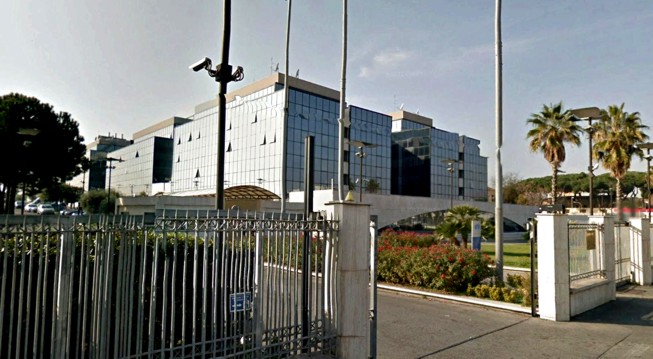
The Rome headquarters of the Scientific Police which work closely with the FBI
5. Explanations Of Some Of The DNA Data
The data in each column was obtained directly or indirectly obtainable from the two reports by Dr. Stefanoni’s team.
1) Column “˜A’ allows one to resort rows to their original order, which is based on the order of the “˜item number’ noted in the GT report.
2) “˜Item number’ refers to the actual piece of evidence, whether an object sampled onsite or an object that was bagged and taken to the lab, as noted in the GT report.
3) “˜Original item label’ is data provided in the first pages of the GT report, as a way to tie the evidence item back to evidence markers used at the crime scene, and visible in some of the crime scene photos.
4) “˜Page in attached photo report’ indicates that there is an adjunct “˜photo report’ Dr. Stefanoni provided that has not yet been released, and likely has photos of the evidence items “˜in situ’. This information is also noted in the beginning item lists in the GT report.
5) “˜Sample date’ is based on the dates noted in the beginning list in the GT report, indicating when the evidence item was sampled or taken from the crime scene. This is sometimes difficult to read, due to the fact that the report was apparently printed in color and the black and white scan hides or obscures some text and graphics.
6) Columns F-K are location and object data, obtainable from the descriptions in the GT report, especially the first pages that provide a list of where evidence samples were obtained. I broke this data down into various categories to allow different possibilities of grouping the data.
7) “˜Sample obtained’ indicates the type of biological substance that was assumed to contain DNA. This was first obtained from the GT report, and later corrected with the data from the SAL report, which has a more consistent description of what the sample was assumed to be.
8) Columns M through AC list data either directly reported in the GT and SAL reports, or interpretable from them. Column M notes if an item was analyzed or not. In the GT report, unanalyzed items are noted in the beginning list as “˜not analyzed’ though not consistently. In the SAL report, they are noted as having 0 samples.
9) “˜Trace number’ was obtained from GT report, though on a few occasions, the actual number is not clear. Note that the number “˜starts over’ for each evidence item. Sometimes the trace number is sequential, independent of whether it is blood or hair or skin cells. Items having the most traces are those that were “˜heavily’ sampled, including Sollecito’s sneakers, the duvet, Ms. Kercher’s sweat jacket, her jeans, the kitchen knife, the kitchen sponge, etc.
10) “˜Additional trace info’ is additional information noted from both reports about a specific sample.
11) Column P “˜revealed in luminol?’ indicates with a “˜yes’ those samples obtained during luminol analysis. What often gets overlooked is that luminol analysis was performed not only at the cottage, but in Sollecito’s car, Sollecito’s apartment and Guede’s apartment. Notable here is that 14 different samples were obtained from luminol analysis at Sollecito’s apartment. While the DNA data yielded was meager, what is important is not the actual data yielded, but the number and location of samples investigated, including samples from door handles, and different locations like the bathroom, bedroom and kitchen. There was certainly a suspicious amount of blood, bleach or turnip juice at Sollecito’s place!
12) “˜Date of extraction’ comes from the SAL report, though, as mentioned above, it is not consistently reported for every trace or sample analyzed. This indicates when DNA processing occurred on a sample. This column is important to look at when discussing the issue of lab contamination. If one performs a sort on this column and on the “˜sample number’ column, one can clearly see that samples were processed in batches, often a week or two weeks apart. So for instance, claims that the sample 36B happened due to contamination at the lab is really not possible, given that Ms. Kercher’s DNA was analyzed one week earlier (11/5/07 and 11/6/07) and sample 36B is the only sample to contain Ms. Kercher’s DNA from all the samples analyzed on 11/13/07. Similarly, Sollecito’s DNA and Guede’s DNA are only found once each of all the items analyzed on 12/29/07, yet the last time Sollecito’s DNA had been analyzed was on 12/17/07, 12 days earlier. So the likelihood of lab contamination seems extraordinarily small, just from the dates of when samples were analyzed.
13) “˜TMB test positive’ was originally obtained from the GT report. Again because that report is likely in color, a number of tables have either missing graphics or are missing tables altogether. Fortunately the SAL report has duplicated this data consistently.
14) “˜Human antibody test positive?’ is obtained from other tables in the GT report, almost always paired with the TMB table. In some cases where the table data is illegible, I’ve placed a “?” in front of an assumed result. Curiously, this test is not shown in the SAL report.
15) “˜Cat antibody positive?’ is from the GT report, shows that the basement apartment blood samples were all made a by cat, which Dr. Stefanoni comments on in her Massei testimony.
16) Apparently they also ran “˜dog antibody’ testing as well, as is noted in the GT report.
17) “˜DNA extraction done?’ indicates if a decision was made to extract DNA. This was inferred from the GT report. Notable here is that even with samples having cat antibodies, Dr. Stefanoni does the DNA extraction anyway to make sure no human DNA is in the sample.
18) “˜Quantity extracted’ comes from the SAL report. This refers not to the amount of DNA extracted, but specifically to the amount of liquid (50, 100 or 150 microliters) filtered through the Qiagen Bio Robot EZ1 machine. This machine actually filters or purifies the sample, removing all other biological materials like cells, bacteria, etc. leaving only actual DNA molecules which can then be processed. This extraction process is also the quantification process, where from a 50 microliter sample a certain amount of DNA is found and quantified.
19) “˜Human DNA found during quantification’ was inferred from the GT report. It should be noted that for Dr. Stefanoni’s team, DNA analysis involved finding DNA useful for comparison. This means that Dr. Stefanoni was not looking for a sample of any human DNA, but a sample sufficiently “˜complete’ to be able to compare it with others samples. So it was likely often the case that a trace might have snippets and pieces of DNA, but these pieces were either too small or too fragmented to be useful for any profile comparisons. So “˜No’ in this column means not so much that no DNA was found at all, but that no DNA was found that could be useful for comparison.
20) “˜Decision to amplify and analyze’ was obtained from the GT report. Sometimes it is explicitly mentioned in the description of the results in the GT report. Other times, it can be inferred from the lack of tables.
21) “˜Concentrate sample with Speed VAC 110’ means that where “no human DNA was found” (i.e. when no DNA was found sufficiently complete or in sufficient amounts useful for comparison), Dr. Stefanoni decided to process the sample further in an effort to “˜bring out’ whatever DNA there might be. This was done using a “˜concentrator’, which dries the samples and vacuums them, thereby reducing sample fluid to make any DNA present more easily found by the subsequent DNA processing equipment.
22) “˜STR amplification’ is the DNA copying process whereby any DNA found is copied millions of times to obtain samples that can be adequately rendered by capillary electrophoresis. The process Dr. Stefanoni used is described specifically in the GT report for evidence items 12 and 13.
23) In some cases “˜Y chromosome amplification’ is also done. While this may be done at the same time by the same machine, I took any Y chromosome amplification to be a separate test, since per the GT report, it sometimes yielded different results. In a few cases, it is not clear from the GT report if Y chromosome amplification was done on only one sample, or on all the samples of an evidence item. In those cases, I assumed all the samples.
24) “˜Capillary electrophoresis’ is where DNA is rendered through a chemical/electrical process that tags DNA particles with fluorescence. These fluoresced particles are then read by the software of the machine and mapped onto a graph that shows DNA particles as “˜peaks’, which are an indicator of quantity of DNA found. The software of the machine then produced graphs of the peaks obtained and it is these graphs that Dr. Stefanoni and her team used for profile comparison.
25) “˜DNA yielded’ is what is indicated in the GT report and is based on Dr. Stefanoni’s comparison of the DNA profile(s) shown by capillary electrophoresis to index DNA samples she had of Sollecito, Lumumba, Guede, Knox and Ms. Kercher.
26) “˜Egram number’ is taken from the GT report.
27) The “˜sample number’ was taken from the GT and further completed by the SAL report, which has the sample numbers for all samples, whether they were analyzed for DNA or not. The sample numbers are useful for indicating what was happening at the Dr. Stefanoni’s lab. As an example, if one does a sort on column Q (Date of extraction) and column AF (sample number) one can see that between 11/5/07 and 11/6/07, there is gap of 129 samples that were likely performed for another case. The last sample analyzed on 11/5/07 was 47082, and on 11/6/07, the next sample number is 47211. So presumably her lab ran 129 additional DNA tests on samples related to other cases between these two runs. Generally the sample numbers increase sequentially by date, but there are a few exceptions. One in particular is sample 47821, which appears as the last sample on 11/23/07, though samples starting on 11/26/07, three days later, start with sample number 47711. This implies that samples were probably numbered in batches (by sticking numbered labels on tubes or bags) and not necessarily right before extraction or other machine processing was done.
28) “˜Compatibility notes’ are extra comments noted by Dr. Stefanoni in the GT report.
29) “˜Likely substance containing DNA’ is interpretable from the GT and SAL report and the results of the testing done.
30) Finally there are columns related to hair analysis. “˜Type of hair’ comes from the SAL report, and it is sometimes, but not consistently or legibly, noted in the GT report.
31) “˜Hair color’ provides a description of the hair color. Notable is that the hair description is quite consistent, with black, blonde, chestnut, light chestnut, red chestnut being the more significant categories. This is available in both the GT and SAL report and both reports match.
32) “˜Hair length;’ is obviously the length of hair analyzed. I’m not sure how this was done since the machinery used is not indicated in either report. Again, this is in both reports, and again the data matches in both reports.
33) “˜Hair width’ is the diameter of the hair in micrometers, and is available in both reports.
34) “˜Hair marrow’ is found only in the SAL report, and presumably describes the condition of the very core of the hair.
35) “˜Hair end condition’ indicates whether the end of the hair is “˜cut’, a “˜point’, frayed or otherwise. This is found in both reports.
36) “˜Bulb phase’ relates to the particular phase of hair growth, with DNA apparently present in the hair bulb only during the initial growth phases of the hair. This too is found in both reports.
37) “˜Hair remarks’ are any comments related to hair samples.
38) Lastly, the “˜remarks’ column contains my notes on a particular sample or test, indicating discrepancies or explanations of what I was able to understand.
As noted above, the SAL report does not contain data for all the samples. Per Dr. Gino’s testimony in the Massei trial on 9/26/09, additional SAL sheets were apparently released that indicate that TMB tests were done on the luminol samples at the cottage and that these tests were negative. However it should be noted that TMB is less sensitive than luminol, so it is possible that a luminol sample could be in blood, which however is too diluted to be registered by a TMB test.
6. More Commentary On the DNA Extracted From Blood
1) DNA is only found in white blood cells, not red blood cells
2) The luminol reacts with the iron in red blood cells, not white blood cells
3) Red blood cells outnumber white blood cells by roughly 600 to 1
4) Even if DNA is found it may be not usable for comparison
So just because there is a positive luminol or TMB result does not mean that DNA can be found.
7. More Commentary On The Resulting Statistics
At the bottom of the spreadsheet are some interesting statistics, which I won’t reiterate here, except to note a few things.
a) 227 different objects or site objects were sampled/ obtained for analysis. 30 of these were not analyzed at all. From the remaining 197 objects and site objects sampled, 484 separate tests were set up for analysis, with 93 of these consisting of hair analysis. Of these 484 tests, 193 of them yield DNA data useful for comparison (40%).
b) Of the 193 tests that were “˜successful’, 100 tests yielded DNA compatible only with Ms. Kercher’s DNA (over 50%- again keep in mind their may have been other DNA but it may have been too small or too fragmented to be useful for comparison). Nine additional tests (comprising seven samples) yielded DNA compatible with Ms. Kercher’s DNA mixed with either Knox’s, Guede’s or Sollecito’s DNA. 27 tests had DNA compatible with Guede’s DNA; 18 tests had DNA compatible with Knox’s DNA; 11 more tests had DNA compatible with Sollecito’s DNA. Nine other tests yielded DNA compatible with a mixture of Knox’s and Sollecito’s DNA. 17 tests yielded DNA of unknown men and women (i.e. unmatchable by Dr. Stefanoni), and two tests were of samples obtained from Lumumba.
c) Of the nine tests yielding Ms. Kercher’s DNA mixed with others, five of these yielded DNA compatible with a mixture of Kercher’s and Knox’s DNA. They were all samples found in blood or potential blood- notably: three in the bathroom, one on the corridor floor in a luminol revealed bloody footprint, one in a luminol revealed blood stain in Romanelli’s room.
d) Returning to the discussions about contamination, it is notable that, whether the contamination occurred during site collection or in the lab, one might expect to find bits of contamination occurring here and there over 193 tests. Yet nearly all the arguments involve contamination about two samples, out of 193 tests. Over 50% of the tests that had useful DNA yielded Ms. Kercher’s DNA. If site collection, transport and/or lab procedures were so poor, one would expect to find Ms. Kercher’s DNA in other places as well. Yet very few samples have her DNA mixed with others, and conversely, very few other samples have other mixed DNA. Only nine samples have mixes of Sollecito and Knox’s DNA, eight of which were all obtained at Sollecito’s apartment or from Sollecito’s things (including a pocket knife), and one was obtained from a cigarette butt at the cottage. If contamination was so rampant, why does it occur on only two samples out of 193, (and curiously only on the two most damning samples)?
e) Continuing along the same lines, 118 samples were obtained from Sollecito’s apartment. Of these, 49 were not analyzed, (many were hairs not having bulbs in the right phase). Of the remaining 66 samples that were analyzed, only one, the one the blade of the kitchen knife, had Ms. Kercher’s DNA. And 41 yielded no usable DNA. So if there was contamination, or worse, direct framing of evidence by the lab, certainly there would be more of Ms. Kercher’s DNA amongst those 66 samples, in order to achieve an ironclad case. Yet there is only one sample out of 66 that had Ms. Kercher’s DNA.
f) Similarly, 224 tests were done on objects taken from the upper apartment. Of these 56 were not analyzed for DNA and an additional 61 that were analyzed, did not yield anything useful. Of the remaining 107 tests, only 3 had Sollecito’s DNA (a trace on the cigarette butt, and a trace on the bra clasp having Sollecito’s DNA as well as his Y chromosome.) Surely if there was rampant contamination or worse, direct framing of evidence, one would expect to find more of Sollecito’s DNA in Ms. Kercher’s room. Yet only one sample had his DNA and Y chromosome- the bra clasp.
g) Conversely, it is rather odd that Sollecito’s car was sampled in 16 locations (actually 19 samples were taken but only 16 analyzed), and none of those samples revealed his DNA. Did he ever drive his car?
8. And Finally More Commentary About The Hairs
Guede had black hair. From photos of Nov 2, 2007, Knox had blonde hair and Sollecito had chestnut to light chestnut hair. Meredith Kercher had chestnut to reddish chestnut hair.
93 hairs were found and analyzed. Seven of these were either animal hair or fibers. The remaining 86 hairs were, per the SAL report, all human. Seven of these hairs were black in color. Of the seven, six were short (4 cm or less) and one was long. Of the six short black hairs, four were found on the duvet covering Ms. Kercher, one was found on her mattress cover, and one was found on a sponge (containing fourteen other hairs) at Sollecito’s apartment. It is very likely these short black hairs were Guede’s, and if so, how it one of his hairs get on a sponge at Sollecito’s apartment.
Similarly, 21 blonde hairs were found, ranging from 4 cm to 20 cm. Of these, fifteen were found at Sollecito’s apartment, either on a sponge in the kitchen, or on a sweater. The other six were found at the cottage, with three being found on the duvet, one found inside the small bathroom sink, one found on a mop, one found on Ms. Kercher’s purse and one found on Ms. Kercher’s mattress cover.
Assuming the blonde hairs were Knox’s hair, it is difficult to imagine how they might wind up on Ms. Kercher’s purse and mattress cover.
There were four light chestnut hairs found. One, measuring 9 cm, was found on the kitchen sponge at Sollecito’s apartment. The other three light chestnut hairs were found on Ms. Kercher’s bra (2 cm), sweat jacket (7.5 cm) and the towel found under Ms. Kercher’s body (20 cm).
35 chestnut colored hairs were found, ranging from 1.5 to 30 cm in length. The vast majority were in Ms. Kercher’s bedroom. Two chestnut colored hairs (5 cm and 8 cm) were on the kitchen sponge at Sollecito’s house. It should be noted that three chestnut colored hairs yielded Ms. Kercher’s DNA, measuring 15, 18 and 23 cms.
So even from the hair evidence, it seems that hair having Knox and Sollecito’s color were on Ms. Kercher’s more intimate objects, while Guede’s and Ms. Kercher’s hair apparently were on a sponge in the kitchen at Sollecito’s apartment. In other words, an object used in a clean-up, and in a room that also had five luminol revealed samples.
Even the hair evidence points to Guede, Sollecito and Knox having acted together in the murder of Ms. Kercher.
Thursday, June 12, 2014
Fifty Of The Most Common Myths Still Promoted Without Restraint By The Knox PR Campaign
Posted by The Machine
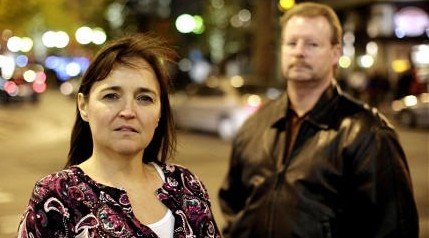
Fooled ya! Knox’s parents have the mythmaking machine’s pedal to the floor, and arent slowing it
Introduction
I’ve listed the 50 most common myths circulating in the media with regard to the Amanda Knox/Meredith Kercher case and refuted them using as far as possible the official court documents and court testimony.
1. Knox was called to the Perugia central police station on 5 November 2007.
Neither the police nor the prosecutors brought Knox in for questioning on 5 November 2007. She was there unwanted, and stayed after it was suggested she go home and sleep.
Amanda Knox herself testified in court that she wasn’t called to come to the police station on 5 November 2007.
Carlo Pacelli: “For what reason did you go to the Questura on November 5? Were you called?”
Amanda Knox: “No, I wasn’t called. I went with Raffaele because I didn’t want to be alone.”
Monica Napoleoni, the head of Perugia’s homicide squad, said they told Knox she should go home to rest, but Knox insisted on staying:
Amanda also came that evening, the evening of the 5th. We said to Amanda that she could go home to rest. Since, during those days, she was always saying, always complaining that she wanted to rest, wanted to eat, we said: “˜Look, you’ve eaten; you can go and rest yourself. If there’s a need, we’ll call you.’
Instead, she was very nervous, and insisted on staying there.
Inspector Rita Ficarra was the one who led the discussion on a list of possible perps with Knox.
Rita Ficarra: My astonishment was that I saw, I found her there, and I found her doing ““ demonstrating ““ her gymnastic abilities: she was doing a cartwheel; she had shown the back arch, she had done the splits, and it seemed to me, sincerely, a bit out of place, that is to say given the circumstances, the moment and the place. For which [reason] I admonished her, and I even asked her what she was doing there.
She, and my colleagues also confirmed this, said to me that she had come because they had called Raffaele Sollecito, he had been invited that evening to give another recap, and she had accompanied him.
Judge Massei [GCM]: You said this to her in English or in Italian?
RF: In Italian. I reiterate that she speaks Italian, with me she speaks only in Italian. I do not understand a word of English, so “¦ My colleagues confirm that there was Sollecito who was there in another room and in that moment the Deputy Commissioner Napoleoni and other colleagues were listening to him.
And continuing to speak, the girl told me that she was rather shocked at the fact, annoyed at the fact that she had been called and recalled several times by the Police and [that] she was totally tired.
At that point, I also admonished her because I said: you’re tired, yet nonetheless you came this evening, when nobody has invited you: you could have gone to rest. And furthermore ““ I said ““ you don’t understand that we are talking about a murder, of a person that you say was your friend, [who] lived in the same house as you, it happened in your house. If the Police call you, put yourself in our shoes: we need useful information.
2. Knox was subjected to an all-night interrogation on 5/6 November.
According to Barbie Nadeau in The Daily Beast, Amanda Knox’s questioning began at about 11:00pm.
“Since Knox was already at the police station [in the company of Raffaele Sollecito], the head of the murder squad decided to ask her a few questions. Her interrogation started at about 11pm.”
After Amanda Knox had made her witness statement at 1:45am, she wasn’t questioned again that evening. She decided to made another witness statement at 5:45am, but she wasn’t asked any questions.
3. Knox wasn’t provided with an interpreter for her questioning on 5 November 2007.
This claim is completely false as shown through the trial testimony of Knox and her interpreter. Knox’s interpreter on 5 November 2007, Anna Donnino, testified at length at trial about Knox’s convesrsation that evening. And Amanda Knox herself spoke about her interpreter when she later gave testimony at the trial.
4. Knox wasn’t given anything to eat or drink.
Reported by Richard Owen, in The Times, 1 March 2009:
Ms Napoleoni told the court that while she was at the police station Ms Knox had been “˜treated very well. She was given water, chamomile tea and breakfast. She was given cakes from a vending machine and then taken to the canteen at the police station for something to eat.’
Also reported by Richard Owen, in The Times, 15 March 2009:
Ms Donnino said that Ms Knox had been “˜comforted’ by police, given food and drink, and had at no stage been hit or threatened.
John Follain in his book Death in Perugia, page 134, also reports that Knox was given food and drink during her questioning:
During the questioning, detectives repeatedly went to fetch her a snack, water, and hot drinks, including chamomile tea.
This is from the relevant court transcript:
Monica Napoleoni: Amanda was given something to drink several times. She was brought hot chamomile; she was taken to the bar of the Questura to eat. First she was given brioches from the little [vending] machine.
Carlo Pacelli: These methods of treatment, how did they translate into practice? With what behaviour/actions [were they carried out] in actual fact? Earlier, you recalled that they actually brought her something to eat”¦
MN: It’s true. That morning, I remember that Inspector Ficarra actually took her to the bar to eat as soon as it opened. But before [that], we have little [vending] machines on the ground floor, and she was brought water, she was brought hot drinks, she was brought a snack. But also Raffaele, he was given something to drink; it’s not as though they were kept “¦ absolutely.
Giuliano Mignini: Had types of comfort been offered to her?
Anna Donnino: Well, during the evening, yes, in the sense that I remember that someone went down to the ground floor; it was the middle of the night, so in the station at that hour there are those automatic distributors; there’s nothing else; someone went to the ground floor and brought everybody something to drink, some hot drinks and something to eat. I myself had a coffee, so I believe that she also had something.
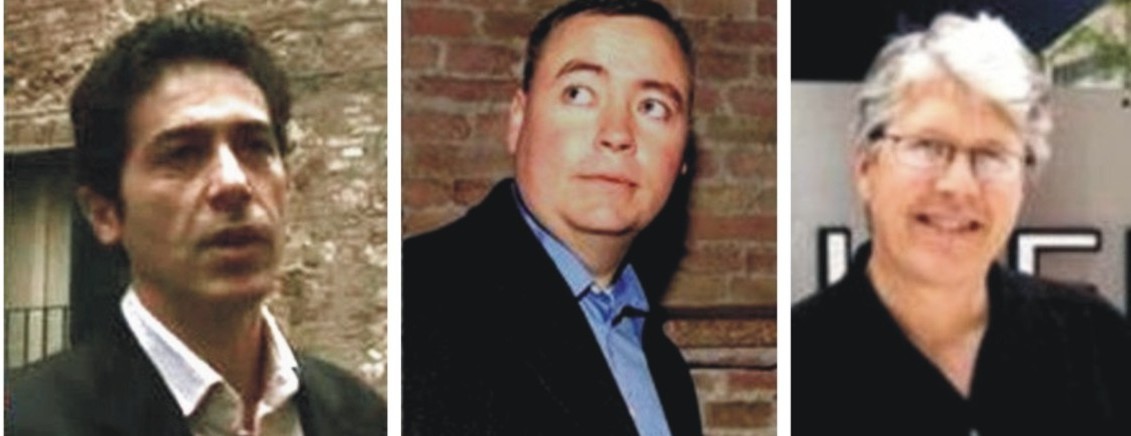
Above: Several of the myth inventors and disseminators: Sforza, Mellas, Preston
5. Knox was beaten by the police.
The witnesses who were present when Knox was questioned, including her interpreter, testified under oath at the trial in 2009 that she wasn’t hit. (Under Italian law, witnesses must testify under oath, while defendants do not, so are not required by law to be truthful on the stand.)
These are from the relevant court transcripts:
Giuliano Mignini: Do you recall, shall we say, that night between the 1st and then the spontaneous declarations and then the order for arrest, who and what was with her, other than you, whether there were other subjects that spoke with us, how they behaved? Did [she] undergo/experience violent [sic: NdT: “violente” in Italian, probably typo for “violenze” = “violence/force/assault”] by any chance?
Rita Ficarra: Absolutely not.
GM: Was she intimidated, threatened?
RF: No. I, as I said earlier, I came in that evening and there were some colleagues from the Rome SCO, I was with Inspector Fausto Passeri, then I saw come out, that is come out from the entry-door to the offices of the Flying [Squad] the Assistant Zugarini and Monica Napoleoni, who appeared for an instant just outside there, then we went back in calmly, because the discussion we had with her was quite calm.
Giuliano Mignini: ... violence, of “¦
Monica Napoleoni: But absolutely not!
Mignini: You remember it”¦ you’ve described it; however, I’ll ask it. Was she threatened? Did she suffer any beatings?
Anna Donnino: Absolutely not.
GM: She suffered maltreatments?
AD: Absolutely not.
Carlo Pacelli: In completing and consolidating in cross-examination the questions by the public prosecutor, I refer to the morning of the 6th of November, to the time when Miss Knox had made her summary information. In that circumstance, Miss Knox was struck on the head with punches and slaps?
Anna Donnino: Absolutely not.
CP: In particular, was she struck on the head by a police woman?
AD: Absolutely not!
CP: Miss Knox was, however, threatened?
AD: No, I can exclude that categorically!
CP: With thirty years of prison”¦ ?
AD: No, no, absolutely not.
CP: Was she, however, sworn at, in the sense that she was told she was a liar?
AD: I was in the room the whole night, and I saw nothing of all this.
CP: So the statements that had been made had been made spontaneously, voluntarily?
AD: Yes.
Carlo Della Valla: This”¦
Giancarlo Massei: Pardon, but let’s ask questions”¦ if you please.
CP: You were also present then during the summary informations made at 5:45?
AD: Yes.
CP: And were they done in the same way and methods as those of 1:45?
AD: I would say yes. Absolutely yes.
CP: To remove any shadow of doubt from this whole matter, as far as the summary information provided at 5:45 Miss Knox was struck on the head with punches and slaps?
AD: No.
CP: In particular, was she struck on the head by a policewoman?
AD: No.
Even Amanda Knox’s lawyer, Luciano Ghirga, distanced himself in the Italian media from these allegations and never lodged any complaint:
There were pressures from the police, but we never said she was hit.
6. Knox was refused a lawyer.
Rita Ficarra and Anna Donnino testified that Knox was several times advised to have a lawyer, but each she declined the offer:
Anna Donnino: ...she was asked if she wanted a lawyer.
Giuliano Mignini: And what was her response?
AD: She had answered no; I remember that she replied with no.
Before she insisted on drafting her 1:45 and 5:45 am accusations Knox was advised to have a lawyer advise her, but she declined and pressed on.
Dr Mignini has wondered if the Supreme Court really understood this in banning the two unprovoked accusations from Knox’s main trial.
7. Knox was tag-teamed by two police officers every hour.
According to Anna Donnino, who arrived at the police station at about 12:30am, there was a total of three people in the room with Knox:
Anna Donnino: “I had been made to enter a room where in fact there was Inspector Ficarra at a small table, another colleague from SCO (I only remember his first name; he was called Ivano), a police officer, and there was Miss Knox seated. I seated myself beside her.”
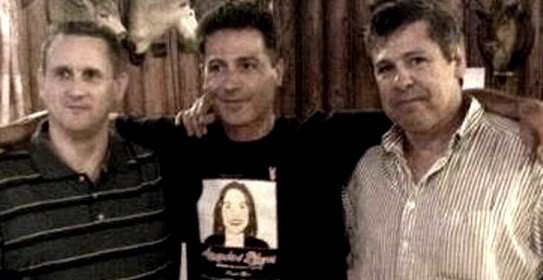
Above: Several of the main myth inventors and disseminators: Fischer, Sforza, Moore
8. Knox was asked to imagine what might have happened.
According to the corroborative testimony of the three others present, including Rita Ficarra and Anna Donnino, Amanda Knox voluntarily and spontaneously accused Patrick Lumumba of murdering Meredith.
Here is Rita Ficarra.
We found only that one [text message] sent by her. She was given the mobile into her hand, and it was said, who is this person, and did you go out later or not? She said the name of Patrick Lumumba, and gave the declaration that then ...
GM: And what behaviour did she then adopt/assume?
RF: She suddenly put her hands to her head, burst out crying and said to us “It’s him, it’s him, it was him, he killed her”. It was the only time that I saw her cry.
GM: This behaviour, did she then continue like that during the course of that morning, by now we were at what time?...
RF: No, she was as if she was giving vent in that moment, she cried, she began to say that he was crazy, he was crazy.
Here is Anna Donnino:
Judge Massei: This change, at what moment did it happen, and in what did it consist of?
Anna Donnono: The change had occurred right after this message, in the sense that the signorina said she hadn’t replied to the message from Patrick, when instead her reply message was shown to her she had a true and proper emotional shock. It’s a thing that has remained very strongly with me because the first thing that she did is that she immediately puts her hands on her ears, making this gesture rolling her head, curving in her shoulders also and saying “It’s him! It’s him! It was him! I can see/hear him or: I know it.[Lo sento]” and so on and so forth.
Carlo Pacelli: So the statements that had been made had been made spontaneously, voluntarily?
Anna Donnino: Yes.
Here is Judge Massei.
[After hearing and weighing up the testimony of these witnesses and Amanda Knox, Judge Massei stated that it couldn’t be claimed that] “Amanda Knox was persuaded by the investigators to accuse Diya Lumumba, aka Patrick, by means of various pressing requests which she could not resist.” (Massei report, page 388.)
[He noted that there had been] “no corroboration of the pressing requests which Amanda was seemingly subjected to in order to accuse Diya Lumumba of the crime committed to the detriment of Meredith.” (Massei report, page 389.)
Judge Massei concluded at trial in 2009 that Knox had freely accused Patrick Lumumba of Meredith’s murder and awarded her a prison sentence for calunnia confirmed in 2013 by the Supreme Court for which there is no further appeal.
9. Amanda Knox claimed she had had a “dream-like vision” in her witness statements.
Amanda Knox makes no mention of a dream or vision in her two witness statements. She categorically states that she met Diya Lumumba at Piazza Grimana and that they went to the cottage on Via della Pergola. In her first witness statement, she claims that Lumumba killed Meredith.
This is from the 1:45 am statement.
I responded to the message by telling him that we would see each other at once; I then left the house, telling my boyfriend that I had to go to work. In view of the fact that during the afternoon I had smoked a joint, I felt confused, since I do not frequently make use of mind-altering substances, nor of heavier substances.
I met Patrik immediately afterward, at the basketball court on Piazza Grimana, and together we went [to my] home. I do not recall whether Meredith was there or arrived afterward. I struggle to remember those moments, but Patrik had sex with Meredith, with whom he was infatuated, but I do not recall whether Meredith had been threatened beforehand. I recall confusedly that he killed her.
This is from the 5:45 am statement.
I wish to relate spontaneously what happened because these events have deeply bothered me and I am really afraid of Patrick… I met him in the evening of November 1st 2007, after sending him a reply message saying “I will see you”. We met soon after at about 21.00 at the basketball court of Piazza Grimana. We went to my apartment in Via della Pergola n. 7.
I do not clearly remember if Meredith was already at home or if she came later, what I can say is that Patrick and Meredith went into Meredith’s room, while I think I stayed in the kitchen. I cannot remember how long they stayed together in the room but I can only say that at a certain point I heard Meredith screaming and as I was scared I plugged up my ears.
10. Amanda Knox was questioned in Italian
The police provided Amanda Knox with an interpreter, Anna Donnino, so that she could be questioned in English.
11. Dr Mignini questioned Knox on 5 November 2007.
Dr Mignini did not question Amanda Knox that evening. She wanted to make further declarations, and he came to the police station on the night only because he was on duty and had to witness Knox being cautioned. After Knox was cautioned that she need not say anything without a lawyer, Knox nevertheless insisted that she draft a second statement in front of him.
Mr Mignini explained what happened in his e-mail letter to Linda Byron, a journalist for King5 in Seattle:
All I did was to apply the Italian law to the proceedings. I really cannot understand any problem.
In the usual way, Knox was first heard by the police as a witness, but when some essential elements of her involvement with the murder surfaced, the police suspended the interview, according to article 63 of the penal-proceedings code.
But Knox then decided to render spontaneous declarations that I took up without any further questioning, which is entirely lawful.
According to article 374 of the penal-proceedings code, suspects must be assisted by a lawyer only during a formal interrogation, and when being notified of alleged crimes and questioned by a prosecutor or judge, not when they intend to render unsolicited declarations.
Since I didn’t do anything other than to apply the Italian law applicable to both matters, I am unable to understand the objections and reservations which you are talking about.”
In Amanda Knox’s written witness statement, she explicitly states that she’s making a spontaneous declaration:
I wish to relate spontaneously what happened because these events have deeply bothered me and I am really afraid of Patrick, the African boy who owns the pub called Le Chic located in Via Alessi, where I work periodically.
12. Knox didn’t confess until 6am.
Amanda Knox’s first written statement was made at 1:45am. It was not a confession, it was a false accusation.
13. Knox retracted her allegation against Lumumba immediately.
Amanda Knox didn’t retract her accusation immediately. In fact, she never did formally. Knox reiterated her allegation in her handwritten note to the police late morning of 6 November 2007, which was admitted in evidence: From the Massei report:
[Amanda] herself, furthermore, in the statement of 6 November 2007 (admitted into evidence ex. articles 234 and 237 of the Criminal Procedure Code and which was mentioned above) wrote, among other things, the following:
I stand by my [accusatory] statements that I made last night about events that could have taken place in my home with Patrick”¦in these flashbacks that I’m having, I see Patrick as the murderer”¦
This statement was that specified in the notes of 6 November 2007, at 20:00, by Police Chief Inspector Rita Ficarra, and was drawn up following the notification of the detention measure, by Amanda Knox, who “requested blank papers in order to produce a written statement to hand over” to the same Ficarra. (Massei report, page 389.)
Knox did not withdraw the false accusation at her first hearing in front of a magistrate on 8 November.
The Massei court took note of the fact that Amanda Knox didn’t recant her false and malicious allegation against Diya Lumumba during the entire time, two weeks, he was kept in prison.
14. In the days following Meredith’s murder, Knox voluntarily stayed in Perugia to help the police
This claim is contradicted by Amanda Knox herself. In the e-mail she wrote to her friends in Seattle on 4 November 2007 she categorically stated she was not allowed to leave Italy:
“i then bought some underwear because as it turns out i wont be able to leave italy for a while as well as enter my house”
Knox actually knew on 2 November 2007 that she couldn’t leave Italy. Amy Frost, a friend of Meredith, reported the following conversation (Massei report, page 37):
“I remember having heard Amanda speaking on the phone. I think that she was talking to a member of her family, and I heard her say, “˜No, they won’t let me go home; I can’t catch that flight.’ “
15. All of Meredith’s friends left immediately.
The police also told Sophie Purton that they needed her to stay on in Perugia on precisely the same basis as Amanda Knox. Sophie had been counting on leaving Perugia to fly back home as soon as her parents arrived, but the police called to tell her they needed her to stay on; they would let her know when she could leave. Her father stayed on with her.
In chapter 19 of Death in Perugia John Follain states that Sophie Purton was questioned by Mignini and Napoleoni in the prosecutor’s office on 5 November 2007.
16. There were only two tiny pieces of DNA evidence that implicated her, but they were probably contaminated.
The Italian Supreme Court explained how DNA evidence should be assessed in court; i.e., contamination must be proven with certainty, not supposition. The Court stated that the theory “anything is possible” in genetic testing is not valid.
The burden of proof is on the person who asserts contamination, not the person who denies it.
In other words, if the defence lawyers claim the DNA evidence was contaminated, they must describe the specific place and time where it could have plausibly occurred. Nobody has ever proved that the bra clasp and knife evidence were contaminated. Even Conti and Vecchiotti excluded contamination in the laboratory:
“Laboratory contamination was also excluded by these experts [Conti and Vecchiotti].” (The Supreme Court report, page 92.)
(1) The bra clasp
The fact that the bra clasp was not collected immediately because defense witnesses were not available is irrelevant. The cottage was a sealed crime scene and nobody entered the room during this time:
...the flat had been sealed and nobody had had the opportunity to enter, as shown in the case file.” (The Italian Supreme Court report, page 92.)
Alberto Intini, the head of the Italian police forensic science unit, excluded environmental contamination because “DNA doesn’t fly.”
Even Conti and Vecchiotti excluded contamination in the laboratory because Dr Stefanoni last handled Sollecito’s DNA twelve days before she analysed the bra clasp.
Professor Francesca Torricelli testified that it was unlikely the clasp was contaminated because there was a significant amount of Sollecito’s DNA on it. His DNA was identified by two separate DNA tests. Of the 17 loci tested in the sample, Sollecito’s profile matched 17 out of 17.
David Balding, a Professor of Statistical Genetics at University College London, analysed the DNA evidence against Sollecito and concluded that the evidence was strong”
“...because Sollecito is fully represented in the stain at 15 loci (we still only use 10 in the UK, so 15 is a lot), the evidence against him is strong”¦”
(2) The knife
Dr Stefanoni analysed the traces on the knife six days after last handling Meredith’s DNA. This means that contamination couldn’t have occurred in the laboratory. Meredith had never been to Sollecito’s apartment, so contamination away from the laboratory was impossible.
The knife and bra clasp are not the only pieces of DNA evidence.
According to the prosecution’s experts, there were five samples of Knox’s DNA or blood mixed with Meredith’s blood in three different locations in the cottage. After the trial in 2009, The Kerchers’ lawyer, Francesco Maresca, said the mixed-blood evidence was the most damning piece of evidence against Amanda Knox.
The Scientific Police experts concluded it proves that Meredith and Knox were bleeding at the same time.
17. The knife has essentially been thrown out.
The knife hasn’t been thrown out. A further DNA sample (36-I) was extracted from the blade last year and tested by the Carabinieri RIS DNA experts Major Berti and Captain Barni. The sample was attributed to Amanda Knox, the second. Judge Nencini stated in his report that Knox stabbed Meredith with the knife.

Above: Several of the myth inventors and disseminators: Hampikian, Burleigh, Heavey
18. The knife doesn’t match any of the wounds on Meredith’s body.
The prosecution experts, multiple defence experts and Judge Massei in his report have all agreed that the double DNA knife DID match the large wound on Meredith’s neck.
“On these matters, the considerations already made must be recalled which led this Court to evaluate the outcome of the genetic investigation as reliable, and this knife as absolutely compatible with the most serious wound.” (Massei report, page 375.)
Barbie Nadeau, an American journalist based in Rome, reported directly from the courtroom in Perugia that multiple witnesses for the defence, including Dr. Carlo Torre, conceded that the double DNA knife was compatible with the deep puncture wound in Meredith’s neck.
According to multiple witnesses for the defense, the knife is compatible with at least one of the three wounds on Kercher’s neck, but it was likely too large for the other two. (Barbie Nadeau, Newsweek.)
He (Dr. Carlo Torre, defence expert) conceded that a third larger wound could have been made with the knife, but said it was more likely it was made by twisting a smaller knife. (Barbie Nadeau, The Daily Beast.)
19. The DNA on the blade could match half the population of Italy.
Vieri Fabani, a lawyer for the Kerchers, pointed out that there is the possibility of 1 in 1 billion 300 million that the DNA on the blade does not belong to Meredith.
20. Meredith’s DNA wasn’t found on the blade of the knife.
A number of independent forensic experts—Dr. Patrizia Stefanoni, Dr. Renato Biondo, Professor Giuseppe Novelli, Professor Francesca Torricelli and Luciano Garofano—have all confirmed that sample 36B was Meredith’s DNA.
Even American experts Elizabeth Johnson, Greg Hampikian and Bruce Budowle, who have been critical of the Scientific Police’s work in this case, have conceded that the DNA was consistent with Meredith’s DNA profile.
It should be noted that none of these American experts testified at the trial or played any official role in the case. They became involved in the case after being approached by supporters of Amanda Knox. They had no bearing on the legal proceedings in Florence.
Judge Nencini accepted that Judge’s Massei and the prosecution’s assertions that Meredith’s DNA was on the blade of Sollecito’s kitchen knife and that it was the murder weapon.
21. No other knives were taken from Sollecito’s apartment.
Judge Massei discusses a jack-knife that was 18cm long with an 8cm blade at some length and the results of the DNA tests that were carried out on it:
“He [Armando Finzi] recalled they found another knife whose total length was 18cm, with an 8cm blade”¦” (Massei report, page 106.)
“On the jack”‘knife, four samples were taken, with negative results where blood-derived substances had been looked for; on the fourth sample, which involved the handle, the genetic profile was found to be of Sollecito plus Knox.” ( Massei report, page 194.)
22. The knife was chosen at random.
Armando Finzi was the police officer who bagged the knife. He testified that he thought it was the murder weapon because it was compatible with the wound on Meredith’s neck. Andrea Vogt explained this in the same article:
“Armando Finzi, an assistant in the Perugia police department’s organized crimes unit, first discovered the knife in Sollecito’s kitchen drawer. He said the first thing he noticed upon entering the place was a “˜strong smell of bleach.’ He opened the drawer and saw a “˜very shiny and clean’ knife lying on top of the silverware tray.
” “˜It was the first knife I saw,’ he said. When pressed on cross-examination, he said his “˜investigative intuition’ led him to believe it was the murder weapon because it was compatible with the wound as it had been described to him. With gloved hands, he placed the knife in a new police envelope, taped it shut with Scotch tape, then placed it inside a folder, he said. There were smaller and bigger knives in the drawer, but no others were taken into evidence from the kitchen, he said.” (Andrea Vogt, The Seattle Post-Intelligencer, 28 February 2009.)
23. No control tests were done.
John Follain pointed out in Death in Perugia that the control tests had been filed with another judge:
“The tests had been filed with an earlier test, and Judge Pratillo Hellmann later admitted them as evidence.” (Death in Perugia, Kindle edition, page 409.)
The judges at the Supreme Court in Italy noted in their report that the negative controls had been carried out:
“...since all the negative controls to exclude it [contamination] had been done by Dr Stefanoni”¦” (Supreme Court report, page 93.)
The judges at the Italian Supreme Court criticised the court-appointed independent experts Conti and Vecchiotti for assuming they hadn’t been done.
24. There is no evidence of Amanda Knox at the actual crime scene.
The crime scene involves the whole cottage and isn’t limited to Meredith’s room. Knox and Sollecito were both convicted of staging the break-in in Filomena’s room. Furthermore, there is plenty of evidence placing Amanda Knox in Meredith’s room on the night of the murder.
For example, her DNA was found on the handle of the murder weapon, her bare bloody footprints were revealed by Luminol in the hallway and her own room and, according to the Scientific Police, her blood was mixed with Meredith’s blood in different parts of the cottage. Knox’s lamp was found in Meredith’s room, and a shoeprint in her size of shoe.
25. None of the Luminol* stains contained Meredith’s DNA.
Two of the traces revealed by Luminol contained Meredith’s DNA:
“Amanda (with her feet stained with Meredith’s blood for having been present in her room when she was killed) had gone into Romanelli’s room and into her [own] room, leaving traces [which were highlighted] by Luminol, some of which (one in the corridor, the L8, and one, the L2, in Romanelli’s room) were mixed, that is, constituted of a biological trace attributable to [both] Meredith and Amanda”¦” (Massei report, page 380.)
[* Luminol is a substance used in crime-scene investigations to reveal blood that has been cleaned up. It reacts with the microscopic particles of iron in the blood and turns it fluorescent.]
26. Mignini is persecuting Amanda Knox.
As shown above Dr Mignini was absent when Knox made her false accusation. Because of checks and balances, prosecutors in Italy have far less power than their American counterparts. The decision to send Knox to trial was actually made by Judge Micheli in 2008, not by Dr Mignini.
Judge Massei, Judge Cristiani and six lay judges found Knox guilty of murder in Perugia in 2009, and Judge Nencini, Judge Cicerchia and six lay judges confirmed Knox guilty of murder at the appeal in Florence in January 2014.
Dr Mignini is just one of several prosecutors who have been involved in the case. Manuela Comodi was Mignini’s co-prosecutor at the the trial in 2009. Giancarlo Costagliola was the main prosecutor in the first appeal, which was annulled by the Italian Supreme Court. He and Giovanni Galati appealed against the 2011 acquittals. Dr Mignini played no part in the new appeal in Florence. Alessandro Crini was the prosecutor.
27. Mignini claimed Meredith was killed as part of a satanic ritual.
Mignini has never claimed that Meredith was killed during a satanic or sacrificial ritual, and that’s the reason why no one has been able to provide a verbatim quote from Mignini supporting this false accusation.
Mignini specifically denied claiming that Meredith was killed in a sacrificial rite, in his letter to the Seattle reporter Linda Byron:
“On the “˜sacrificial rite’ question, I have never said that Meredith Kercher was the victim of a “˜sacrificial rite.’ “
Mignini also made it quite clear that he has never claimed that Meredith was killed as part of a satanic rite in his interview with Drew Griffin on CNN:
Drew Griffin: “You’ve never said that Meredith’s death was a satanic rite?”
Mignini: “I have never said that. I have never understood who has and continues to say that. I read, there was a reporter ““ I don’t know his name; I mention it because I noticed it ““ who continues to repeat this claim that, perhaps, knowing full well that it’s not like that.
“I have never said that there might have been a satanic rite. I’ve never said it, so I would like to know who made it up.”
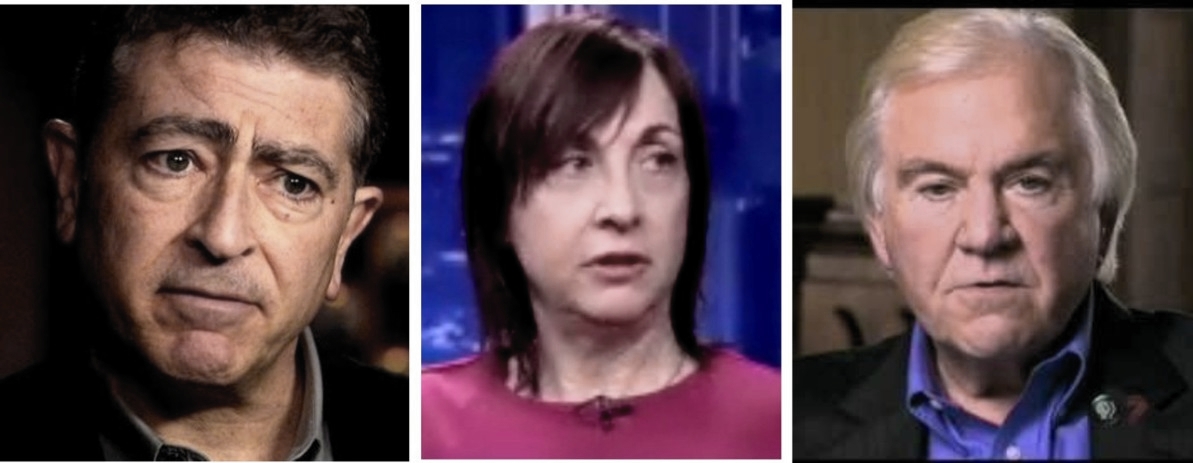
Above: Several of the myth inventors and disseminators: Kassin, Dempsey, Douglas
28. Mignini claimed Meredith was killed in a sex game that went wrong.
Mignini didn’t say anything about there being a sex game that went wrong when he presented his timeline to the court at the trial. Please be warned that there is some extremely graphic content below:
[Timeline of the attack on Meredith]
23:21: Amanda and Raffaele go into the bedroom while Rudy goes to the bathroom.
23:25: A scuffle begins between Amanda, helped by Raffaele, and Meredith. The English girl is taken by the neck, then banged against a cupboard, as shown by wounds to the skull. She resists all this. Rudy Guede enters.
23:30: Meredith falls to the floor. The three try to undress her to overcome her; they only manage to take off her trousers. The girl manages to get up, she struggles. At this point, the two knives emerge from the pockets of Amanda and Raffaele: one with a blade of four to five centimetres, the other, however, a big kitchen knife. Meredith tries to fend off the blades with her right hand. She is wounded.
23:35: The assault continues. Sollecito tries to rip off the English girl’s bra.
23:40: Meredith is on her knees, threatened by Amanda with the knife while Rudy holds her with one hand and with the other hand carries out an assault on her vagina. There is first a knife blow on her face, then straight away another. However, these blows are not effective. The three become more violent. With the smaller knife, Sollecito strikes a blow: the blade penetrates 4 centimetres into the neck.
There is a harrowing cry, which some witnesses will talk about. Amanda decides to silence her, still according to the video brought to court by the prosecutors, and strikes a blow to the throat with the kitchen knife: it will be the fatal wound. Meredith collapses on the floor.
23:45: Meredith is helped up by Rudy and is coughing up blood. The English girl, dying, is dragged along so that she can continue to be undressed.
29. Mignini called Amanda Knox a “she-devil.”
It wasn’t Mignini who called Amanda Knox a “she-devil”; it was Carlo Pacelli, the lawyer who represents Diya Lumumba, at the trial in 2009.
Carlo Pacelli’s comments were widely reported by numerous journalists who were present in the courtroom. Barbie Nadeau describes the moment he asked if Knox is a she-devil in some detail in Angel Face:
“”˜Who is the real Amanda Knox?’ he asks, pounding his fist in the table. “˜Is she the one we see before us here, all angelic? Or is she really a she-devil focused on sex, drugs, and alcohol, living life on the edge?’
“She is the luciferina—she-devil.’” (Barbie Nadeau, Angel Face, Kindle edition, page 124.)
30. Dr Mignini was convicted of a felony and faced prison.
The Florence Appeal Court and Cassation scathingly threw out a malicious prosecution for which both the prosecutor and judge suffered. Dr Mignini has never faced the slightest risk of prison. Often now seen on national TV, Dr Mignini is expected to be the next Prosecutor General of Umbria.
31. Rudy Guede was a drifter.
Rudy Guede lived in Perugia from the age of five, and he had his own apartment at the time of the murder.
32. Guede had a criminal record at the time of the murder.
Rudy Guede didn’t have any criminal convictions at the time of Meredith’s murder. He was not a drug dealer and not a police informant. As Judge Micheli scathingly noted, there is no proof that he committed any break-ins.
33. Guede left his DNA all over Meredith and all over the crime scene.
There was only one sample of Guede’s DNA on Meredith body and there were only five samples of his DNA at the cottage. His DNA was found on a vaginal swab, on the sleeve of Meredith’s tracksuit, on her bra, on the zip of her purse and on some toilet paper in the bathroom that Filomena and Laura shared.
“...also a genetic profile, from the Y haplotype on the vaginal swab, in which no traces of semen were found; DNA on the toilet paper in the bathroom near the room of Mezzetti, where unflushed faeces were found; on the bag found on the bed; on the left cuff of the blue sweatshirt (described as a “zippered shirt” in the first inspection, discovered smeared with blood near the body and partly underneath it); and on the right side of the bra found by the foot of Kercher’s body”¦” ( Judge Giordano sentencing report, page 5.)
34. Guede left his semen at the crime scene.
Guede’s DNA semen wasn’t found at the crime scene.
“...also a genetic profile, from the Y haplotype on the vaginal swab, in which no traces of semen were found”¦” (Judge Giordano sentencing report, page 5.)
“In one of these swabs was found biological material belonging to a male subject identified as Rudy Hermann Guede. This material, which turned out not to be spermatic [158], could be from saliva or from epithelial cells from exfoliation”¦” (Massei report, page 158.)
35. Guede left his DNA inside Meredith’s bag.
According to the Micheli report, which was made available to the public in January 2009, Guede’s DNA was found on the zip of Meredith’s purse, and not inside it.
“...b) traces attributable to Guede: ...on the bag found on the bed”¦” (Judge Giordano sentencing report, page 5.)
36. Guede left his bloody fingerprints all over the crime scene.
He left zero fingerprints. According to the Micheli report, the Massei report and Rudy Guede’s final sentencing report, Guede was identified by a single bloody palm print:
“...b) traces attributable to Guede: a palm print in blood found on the pillow case of a pillow lying under the victim’s body ““ attributed with absolute certainty to the defendant by its correspondence to papillary ridges as well as 16-17 characteristic points equal in shape and position”¦” (Judge Giordano sentencing report, page 5.)
It is confirmed that Guede was identified by a bloody palm print in the Micheli report (pages 10-11) and the Massei report (page 43).
37. Guede left his hair at the crime scene.
The Scientific Police didn’t find any hair that belonged to Rudy Guede at the crime scene. That’s why there’s no mention of this in any of the court documents.
38. Guede pleaded guilty or confessed.
Rudy Guede has never pleaded guilty or confessed to Meredith’s murder. He offered to testify against Knox and Sollecito at trial in 2009, but the prosecutors did not want to give him any breaks.
39. Guede’s prison sentence was reduced because he made a deal with the prosecutors.
Guede was sentenced to 30 years in prison by Judge Micheli in 2008. However, his sentence was reduced because he opted for a fast-trial, which means he automatically received a third off the sentence of Knox and Sollecito. Generic mitigating circumstances—i.e., his young age—were also taken into consideration.
40. Guede didn’t implicate Knox and Sollecito until much later.
Rudy Guede first implicated Knox and Sollecito whilst on the run in Germany on 19 November 2007 in an intercepted Skype conversation with his friend Giacomo:
Giacomo: “So they [Knox and Sollecito] killed her while she was dressed.”
Guede: “Yes, here it says that they [clothes] were washed in the washing machine, but that’s not true. She was dressed.”
41. Amanda Knox didn’t know Rudy Guede.
Amanda Knox testified in court that she had met Rudy Guede on several occasions.
Here’s the court transcript:
Carlo Pacelli (CP), Patrick Lumumba’s lawyer: In what circumstances did you meet him (Rudy)?
Amanda Knox (AK): I was in the center, near the church. It was during an evening when I met the guys that lived underneath in the apartment underneath us, and while I was mingling with them, they introduced me to Rudy.
CP: So it was on the occasion of a party at the house of the neighbors downstairs?
AK: Yes. What we did is, they introduced me to him downtown just to say “This is Rudy, this is Amanda”, and then I spent most of my time with Meredith, but we all went back to the house together.
CP: Did you also know him, or at least see him, in the pub Le Chic, Rudy?
AK: I think I saw him there once.
CP: Listen, this party at the neighbors, it took place in the second half of October? What period? End of October 2007?
AK: I think it was more in the middle of October.
42. Raffaele Sollecito had never been in trouble with the police.
Raffaele Sollecito had a previous brush with the police in 2003.
“...Antonio Galizia, Carabinieri [C.ri] station commander in Giovinazzo, who testified that in September 2003 Raffaele Sollecito was found in possession of 2.67 grams of hashish.” (Massei report, page 62.)
43. Sollecito had an impeccable track record.
Sollecito was monitored at university after being caught watching hardcore pornography featuring bestiality:
“...and educators at the boy’s ONAOSI college were shocked by a film “˜very much hard-core…where there were scenes of sex with animals with animals,’ at which next they activated a monitoring on the boy to try to understand him. (Pages 130 and 131, hearing 27.3.2009, statements by Tavernesi Francesco).” (Massei report, page 61.)
44. Sollecito couldn’t confirm Knox’s alibi because he was sleeping.
The claim that Sollecito couldn’t confirm Knox’s alibi because he was sleeping is completely contradicted by Sollecito’s witness statement:
“Amanda and I went into town at around 6pm, but I don’t remember what we did. We stayed there until around 8:30 or 9pm.
“At 9pm I went home alone and Amanda said that she was going to Le Chic because she wanted to meet some friends. We said goodbye. I went home, I rolled myself a spliff and made some dinner.” (Aislinn Simpson, The Daily Telegraph, 7 November 2007.)
Police said Raffaele Sollecito had continued to claim he was not present on the evening of the murder. He said:
“I went home, smoked a joint, and had dinner, but I don’t remember what I ate. At around eleven my father phoned me on the house phone. I remember Amanda wasn’t back yet. I surfed on the Internet for a couple of hours after my father’s phone call, and I stopped only when Amanda came back, about one in the morning, I think. (The Times, 7 November 2007.)

Above: The two provisionally convicted who originated some of the cancerous myths.
45. Amanda Knox had never been in trouble with the police.
According to Andrew Malone in an article on the Mail Online website, Amanda Knox was charged with hosting a party that got seriously out of hand, with students high on drink and drugs, and throwing rocks into the road, forcing cars to swerve. He claimed the students then threw rocks at the windows of neighbours who had called the police. Knox was fined $269 (£135) at the Municipal Court after the incident (crime No: 071830624).
Barbie Nadeau also reported that Knox had had a previous brush with the law:
...and her only brush with the law was a disturbing-the-peace arrest for a house party she threw.” (Barbie Nadeau, Angel Face, Kindle edition, page 6.)
According to the police ticket written by Seattle Police officer Jason Bender, Knox was issued with an infraction for the noise violation and warned about the rock throwing:
I issued S1/Knox this infraction for the noise violation and a warning for the rock throwing. I explained how dangerous and juvenile that action was.
46. Amanda Knox was retried for the same crimes.
All criminal cases in Italy are subject to three levels of review. No verdict is final until it has been confirmed by the Supreme Court.
Amanda Knox was not retried. She simply appealed her provisional 2009 convictions. The first appeal was held in Perugia in 2011, where she was provisionally acquitted by Judge Hellmann.
However, the Italian Supreme Court annulled the acquittals because Hellmann was found to have made a series of grave legal errors, and ordered a new appeal in Florence.
47. The Italian Supreme Court ruled that Amanda Knox’s interrogation was illegal.
The Italian Supreme Court has never stated that Amanda Knox’s recap/summary session on 5 November 2007 for the building of a list of names was illegal.
Bruce Fischer, who runs the Injustice in Perugia website and had heatedly denied this, eventually admitted this was not true on Perugia Murder File.net website:
“When it comes to the admissibility of the written statements, you are technically correct. The interrogation itself was never ruled illegal.”
Note that as stated above it was not an interrogation.
48. The Supreme Court threw out Amanda Knox’s statements.
The Supreme Court ruled that the 1:45am and 5:45am statements Knox insisted upon couldn’t be used against her in the murder trial because she wasn’t represented by a lawyer when she made them, even though she declined the presence of a lawyer.
However, both her statements were used against her at the calunnia component of the trial.
49. Dr. Stefanoni and the forensic technicians broke international protocols.
There is no internationally accepted set of standards. DNA protocols vary from country to country, and in America they vary from state to state. For example, New York state accepts LCN DNA tests in criminal trials.
Conti and Vecchiotti cited obscure American publications such as the Missouri State Highway Patrol Handbook and the Wisconsin Crime Laboratory Physical Evidence Handbook, not international protocols.
50. Amanda Knox is being railroaded or framed.
It would be immensely difficult in the Italian system for police or prosecutors to frame anyone and sustain this through two levels of appeal. With all its checks and balances and its professional career paths, it may be the system least prone to false final convictions in the world.
A number of Knox’s supporters, including Judy Bachrach, Paul Ciolino and Steve Moore, have claimed in the US media that Amanda Knox is being railroaded or framed, but they mis-state multiple facts and provide no hard proof or any reason why. The Hellmann appeal was wiped off the books, but they wrongly still draw upon that.
The collection of the DNA and forensic evidence was videotaped by the Scientific Police and, as the judges at the Supreme Court noted, defence experts were actually in the police labs to observe the DNA tests and reported nothing wrong:
“...the probative facts revealed by the technical consultant [Stefanoni] were based on investigative activities that were adequately documented: sampling activity performed under the very eyes of the consultants of the parties, who raised no objection”¦” (The Supreme Court report, page 93.)
The legal proceedings against Sollecito and Knox have been monitored throughout by US officials from the Rome embassy, and they at no time have ever expressed any concerns about the fairness or legitimacy of the judicial process.
Sources
Court documents
The Micheli report
The Massei report
Judge Giordano sentencing report
The Supreme court report
The Nencini report
Court testimony
Amanda Knox
Anna Donnino
Monica Napoleoni
Articles
The Daily Mail
The Times
The Telegraph
The Daily Beast
The Seattle Post-Intelligencer
Books
Death in Perugia, Kindle edition, John Follain
Angel Face, Kindle edition, Barbie Nadeau
Television programmes
Drew Griffins’ interview with Giuliano Mignini on CNN
Websites
The Freelance Desk: http://thefreelancedesk.com
Perugia Murder File.org: http://www.perugiamurderfile.org
Perugia Murder File.net: http://perugiamurderfile.net
CPS website: http://www.cps.gov.uk/publications/prosecution/lcn_testing.html
Seattle-Post Intelligencer: http://blog.seattlepi.com/seattle911/files/library/knoxincidentreport.pdf
Tuesday, May 06, 2014
Judge Nencini Issues Harsh Warning To Tell The Truth - So Amanda Knox Does The Precise Opposite
Posted by Our Main Posters
1. Substance Of The Nencini Explanatory Report
The Florence Court of Appeals released the Nencini Motivations Report in Florence one week ago today.
This report explains the rejection of Knox’s and Sollecito’s own first appeal against the Massei trial outcome of 2009. Four years were lost because the Hellmann court, which heard the first iteration of that appeal was bent as Cassation, the competent judge displaced, and now Judge Nencini have all concluded.
The Hellmann outcome of 2011 was mostly annulled, as in “ceased to exist”. The main findings and verdict have zero legal standing, and zero relevance to today’s process though (see below) Knox and Sollecito repeatedly try to ride that dead horse again.
Cassation confirmed Knox’s three-year prison sentence for framing Patrick (for which she has served the time). And Cassation referred the methods and recommendations of the Conti & Vecchiotti consultancy, which Cassation had hammered on legal grounds, to the Florence appeal court for the substance to be reviewed.
Our evidence and law experts here and in Italy have been looking at Judge Nencini’s 347 page report and find it hard-hitting and unequivocally blunt.
It will be extremely hard to appeal against within the very narrow limits Cassation allows. It removes all of Judge Massei’s ambiguities about motives, it reaffirms the witness statements of Curatolo and Quintavalle, and it judicially affirms the validity of the DNA and other forensic evidence against Knox and Sollecito.
There is overwhelming proof of the presence of all three perps, Knox, Sollecito and Guede, in the cottage that night. Guede is considered to have been brought inside by Knox, who had the only key, and he could not possibly have broken in through Filomena Romanelli’s window in the manner asserted by their defense.
Especially troubling for the defense, the report hints at an illegal suborning of the independent forensic experts appointed by the Hellmann court, and it also hints that the two “supergrass” witnesses, the prisoners Aviello and Alessi, may have been illegally tampered with by Sollecito’s lawyer Giulia Bongiorno, as first claimed 30 months ago.
The report warns that criminal slander of justice officials and other contempts of court will be heavily leaned on.
So the report demolishes the last remnants of Judge Claudio Hellmann’s now annulled acquittal, and substitutes for its fatally flawed reasoning a tightly crafted report that confirms the convictions of Knox and Sollecito.
It confirms that they acted in concert with Guede as Cassation itself long ago concluded had to be the case, and it appears to close any possible argument against the verdict that will carry weight at the Supreme Court.
2. Amanda Knox’s Press-Release Statement In Response
Knox issued a seven paragraph statement later the same day. Maybe not the smartest bit of work.
It is riddled with factual inaccuracies and innuendo, is typically arrogant and condescending in tone, includes the trademark racial innuendos about Italians and the black guy in the case, and shows no signs in its compiling of competent legal help.
Here below we show the various ways in which Knox flouts Judge Nencini’s warning and attempts to mislead. None of what Knox stated was the truth.
Claim: The Hellmann Court Found Knox “Innocent”
I have stated from the beginning of this long ordeal that I am innocent of the accusations against me. I was found innocent by the only court in Italy that retained independent forensic experts to review my case. I want to state again today what I have said throughout this process: I am innocent of the accusation against me, and the recent motivation document does not ““ and cannot ““ change the fact of my innocence.
First even if she was provisionally released following the now-annulled appeal, Amanda Knox was never, repeat never, found innocent. Only Cassation can make that final ruling, and they strongly found against the lower court that had jumped the tracks midway-through.
Even Judge Hellman himself said after his verdict that ‘the truth might be otherwise’ and suggested any reasonable doubt as to guilt has not been categorically and legally dismissed. He seemed to divine that he had failed in his task of bending the outcome in a way that would stay bent.
Second the court that Knox thinks found her innocent no longer exists as a legal fact. It seems to endemically escape Knox that the Hellmann outcome was annulled. Annulled. As in: wiped off the books. It is surprising that even Curt Knox and Ted Simon and David Marriott, while admittedly themselves no masters of Italian law, cannot help Knox to grasp that simple fact. It weakens her to keep clinging to a myth.
One reason it was annulled (and the reasons were overwhelming, one of Italy’s most decisive annullments ever) was that both Cassation and Dr Nencini had good reason to suspect the Hellmann court had been corrupted and had deliberately departed from the evidence and the law. Knox needs to ask herself why the highly qualified Judge Chiari was pushed aside (and immediately resigned in anger) in favor of a wrongly-qualified business judge (who is now ignominiously retired).
Third, it needs to be grasped by Knox that the Conti/Vecchiotti consultancy, far from being legally right and acting independently (and scientifically), was suggested as illegal by Perugia’s chief prosecutor Dr Galati, as appeal judges are forbidden from appointing consultants at that stage. While Cassation passed in ruling on that one, the consultancy outcome was criticised as illogical and legally unsound by both Cassation and Judge Nencini, as biased, full of baseless innuendo about contamination, and possibly tampered with by an American academic hired by the defense.
Conclusion: none of what Knox stated was the truth.
Claim: Only Rudy Guede’s DNA Was Found
The recent motivation document does not ““ and cannot ““ change the forensic evidence: experts agreed that my DNA was not found anywhere in Meredith’s room, while the DNA of the actual murderer, Rudy Guede, was found throughout that room and on Meredith’s body. This forensic evidence directly refutes the multiple-assailant theory found in the new motivation document. This theory is not supported by any reliable forensic evidence.
The forensic evidence is not just the DNA on the knife or in the room. It also includes the extensive traces deposited by Knox in the rest of the crime scene (bathroom, corridor and Filomena’s bedroom), and it also includes all of the autopsy.
Meredith’s room itself was not comprehensively tested for DNA. The room was dusted only for fingerprints, as the investigators had to make a call on prints or DNA.
Guede’s DNA was not found “throughout that room” or all over Meredith’s body. Guede’s DNA was found only in one instance on Meredith’s body, on a part of Meredith’s bra, mixed with Meredith’s blood on a sweatshirt cuff and the purse, and on toilet paper in a bathroom.
Knox’s DNA was found mixed with the blood of Meredith in multiple places, the only known source for which was the pool of blood in Meredith’s bedroom: multiple prints of Knox’s bare right foot in the hallway and in Knox’ bedroom, and at least five instances of mixed samples containing the DNA of both Meredith and Knox, including in the north bathroom and Filomena’s room, places where Guede did not go.
The court ruled that the blood and mixed DNA evidence found throughout the crime scene places her and Sollecito there at the time of the murder at the same time as Rudy Guede.
Though not DNA, there was one bloody shoe print in Meredith’s bedroom estimated to be Euro size 36-38, compatible with Knox size 37 and with no one else known of who could have left it there.
No fingerprints of anyone were found in the room, just a palmprint of Rudy Guede. Fingerprints were not found even on Knox’s own lamp, which she only confirmed grudgingly at trial was her own, and not found even in Knox’s own bedroom. Overwhelming sign of a cleanup? The courts all believed so.
Conclusion: none of what Knox stated was the truth.
Claim: The Knife As Murder Weapon Was Disproved
The forensic evidence also directly refutes the theory that the kitchen knife was the murder weapon: the court-appointed independent experts confirmed that neither Meredith’s blood nor her DNA was on the alleged murder weapon, which experts also agreed did not match the stab wounds or the bloody imprint of a knife on her pillow.
Judge Nencini’s finding is that two knives HAD to have been involved from both side of Meredith’s throat and the final blow was by a large knife the same size as the one in evidence.
Regarding the large knife, Knox rehashes the same arguments her defense made to no avail before the original trial court that found her guilty. We posted explaining the solid proof here and here.
The only DNA tests that matter with regard to the big knife are (1) the sound finding by Dr Stefanoni that Meredith’s DNA was on the blade - Knox is wrong, the independent experts did not refute that; (2) the sound findings by Dr Stefanoni and the Carabinieri lab that Knox’s DNA was on both the blade and the handle of the knife. None were overturned; contamination was ruled out; and the defense was left without a shot.
The Hellmann-appointed experts confirmed that the genetic profile found on the knife blade was the genetic profile of Meredith Kercher. The TMB test did not confirm if it was blood, but defense experts were forced to concede that TMB erroneously fails to confirm that blood is present about half the times in assessing minute quantities.
The Hellmann-appointed experts tried to explain away the genetic profile as being the result of contamination, but were never able to identify any scenario by which a knife that had supposedly never left Sollecto’s kitchen contained biological material yielding a clear genetic profile of Meredith Kercher.
Accordingly the Appeals court has ruled the kitchen knife is in fact the one that was wielded by her to strike a final blow, and at the same time there was a second knife in the room used by Sollecito to torture Meredith.
London DNA expert Dr David Balding certified Raf’s DNA as being on the bra clasp. This proves by itself that Sollecito was there. Knox belatedly claimed she stayed at the Via Garibaldi apartment with Sollecito all evening and now and then Sollecito belatedly backs her up. But how could that be if the court has positives of his footprint on the bathroom rug and on the bra, showing he was over at Meredith’s cottage that night? Proof of him present equals proof of her.
The Hellmann-appointed experts were not charged with analyzing the stab wounds, or whether the imprint on a sheet was of a knife or of something else and the result of the fabric being folded - nor was this within their field of expertise. Defense experts testifying on these issues were in conflict.
Conclusion: none of what Knox stated was the truth.
Claim: The Circumstantial Evidence Is “Unreliable”
In fact, in the prior proceeding in which I was found innocent, the court specifically concluded that the forensic evidence did not support my alleged participation in the crime and further found that the circumstantial evidence was both unreliable and contrary to a conclusion of guilt.
The recent motivation document does not ““ and cannot ““ change the fact that the forensic evidence still does not support my participation and the circumstantial evidence still remains unreliable and contrary to the conclusion of guilt.
Knox appeals to Hellmann’s ruling on the circumstantial evidence being unsound. But the Supreme Court, in annulling Hellmann, explained why it found his arguments illogical, and reminded the court of the standards by which circumstantial evidence must form a coherent whole. Judge Nencini in our opinion amply meets those standards in an elegantly argued report which will be hard to defeat at Rome’s Supreme Court.
Knox herself has proved the “unreliable” one, proven over and over again to be a liar who attests to her own bad memory in written statements, who talks of “dreams her mind made up”, who repeatedly goes vague.
We cannot rely on Knox’s recall of phoning mom, the timing of which moves and sometimes disappears. Knox claims she can’t remember where she was that night, she told a whopper of a lie on her boss, she can’t remember if the door to Filomena’s room was open or closed, she can’t remember her own lamp, she claims she rarely looks at a clock. On and on.
The strongest example of circumstantial evidence Knox can’t shake is the five spots of her DNA mixed with Meredith’s blood. Maybe 2 or 3 spots could be put down to unlucky chance, but five really removes reasonable doubt.
Conclusion: none of what Knox stated was the truth.
Claim: No “Legitimate” Motive Is Identified
And the recent motivation document does not ““ and cannot ““ identify any legitimate motive for my alleged involvement in this terrible crime. No fewer than three motives have been previously advanced by the prosecution and by the courts. Each of these theories was as unsupported as the purported motive found in the new motivation document, and each of these alleged motives was subsequently abandoned by the prosecution or the courts. Like the prior “motives”, the latest “motive” in the new motivation document is not supported by any credible evidence or logic. There is simply no basis in the record or otherwise for this latest theory.
“Proof” of motive is not required in any legal system in the world. The serial misleader Ted Simon should at least admit to that. The motives advanced were not withdrawn or abandoned by successive judges; they were fine-tuned chronologically only within very narrow limits. The sex hazing that went too far was weighted downward and pushed back, and a battle over theft of money was weighted upward and pushed forward.
The court found very compelling evidence that Knox committed the murder and led the pack. It postulates that Meredith and Amanda were incompatible with each other, and that Knox, Sollecito and Guede, high on drugs, first assaulted Meredith, restrained and abused her, and then murdered her with two knives.
Knox was known to be in serious rejection by those she encountered in Perugia for her sharp-elbowed brashness - growing rejection by her flatmates, her employer and the bar customers, and just about everyone she encountered except initially for Sollecito. But soon even he was being given a hard time and has semi-rejected Knox in return ever since. The first words of his 8 November 2007 statement to Judge Matteini were “I wish to not see Amanda ever again.”
And money was a huge looming problem which could have had her back in Seattle in weeks. Knox was known to want to head for China, and was known locally to have an expensive drug habit which had cut her savings in half. She really needed to hang on to that job at Patrick’s bar, especially as she had no work permit.
Sollecito’s bank balance was minimally topped up by his father each month. Francesco seemed to realise cocaine is an expensive habit and didnt want to see his son off down that slippery slope. So with Knox’s own habit, her remaining savings would have run out in weeks. How then to explain to Curt Knox that she really needed a whole lot more? He would have given her a very hard time before any more money flowed.
Conclusion: none of what Knox stated was the truth.
Claim: The Supreme Court Will Allow Another Full Appeal
I will now focus on pursuing an appeal before the Italian supreme court. I remain hopeful that the Italian courts will once again recognise my innocence. I want to thank once again, from the bottom of my heart, all of those””family, friends, and strangers””who have supported me and believe in my innocence.
Cassation wont “once again” recognise innocence. Knox should be encouraged to get real. So should her dummy followers - all her immediate circle know she was involved. There are no obvious grounds for Cassation to second-guess Judge Nencini, a very senior and very respected judge, considering the thoroughness of the Nencini Report. The disjointed series of statements on her blog arguing to the contrary look like the opinions of her friends and fans, not legal minds, and it is time she realizes they have feet of sand and no power to help.
Conclusion: none of what Knox stated was the truth.
Three lawyers and five others supplied the rebuttals for Amanda Knox’s false claims here and elsewhere, such as Knox’s email to Judge Nencini and her interviews on TV. Posts on those follow soon. Below: the careful way in which Italian media explain what Judge Nencini released.
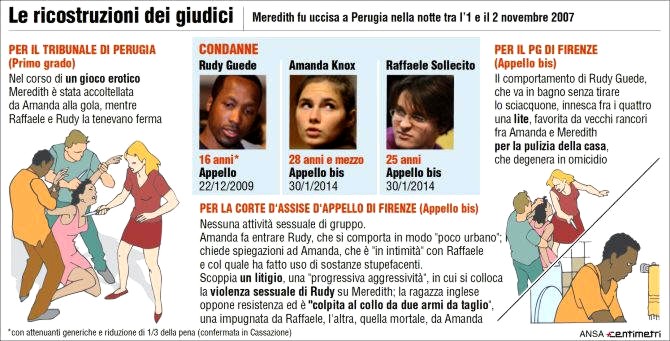
Wednesday, April 16, 2014
The Incriminating Bathroom Evidence: Visual Analysis shows the Footprint IS Sollecito’s
Posted by Machiavelli
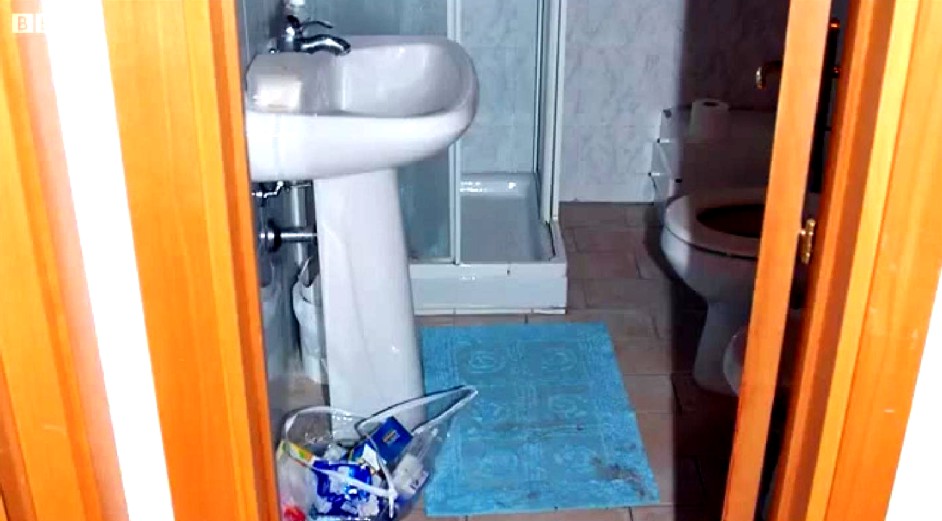
[Please click on each image for a larger and more high-resolution version]
The sheer depth and width of the hard evidence
The defenses really don’t want you to know this: in both width and depth, the full panoply of the evidence against Knox and Sollecito is absolutely overwhelming.
As we remarked in our post below there are far more and far stronger evidence points than UK and US courts normally require for conviction. But only the trial panel of judges observed anything like their full array.
The 2010 Massei Trial Report (which the Nencini Appeal court validated this past January) is a SUMMARY of what was presented to the judges in the courtroom. Those presentations in court were in turn something of a SUMMARY of the hard evidence buried in all the evidence files and the minds of witnesses.
Italian media SUMMARISED for Italians what was to be seen in the courtroom and to be read in the Massei Report. They were barely able to do even summaries for the 1/4 of all the trial hearings that were not open to the media or the public.
UK and US media for the most part didn’t even bother to provide comprehensive summaries (the very fine on-the-spot reportings of Andrea Vogt, Barbie Nadeau and Ann Wise were the main exceptions).
So in effect people in the UK and US attempting to follow the story didnt for the most part receive even a summary of a summary of a summary!
Not one US or UK newspaper or TV network translated the Micheli Report, or the vital Massei Report, or the Supreme Court appeal, or the Supreme Court outcome - only the (mostly professional) translators on PMF dot Org did all that translation.
This post is another example of how far down - beyond even Massei - it’s possible to drill into the evidence, and see it still hold up.
Some past posts on TJMK drilled down to similar depths, on the knives, on the DNA, on the mixed-blood traces, on the phone-events, on the motives and psychologies, and so on. All that evidence too all held up.
Visual analysis of the bathroom-mat footprint
This post mainly consists of high-resolution pictures and measurements. Presented like this, the pictures and measurements largely speak for themselves, and show the real strength of the bathroom-mat footprint evidence.
You will see that as SomeAlibi previously concluded using other methods, this footprint was quite undeniably Sollecito’s. It bears no similarity at all to Rudy Guede’s.
Please click on all images for larger versions in scalable PDF format
1 . [Below] the bathmat and the print, with measurement reference
2 . The bathmat print and the surrounding area
3 . The bathmat print (photo from Polizia Scientifica).
4 . The bathmat print, with vertical and horizontal sizes, from Rinaldi’s report
5. The bathmat print, photo with enhanced contrast.
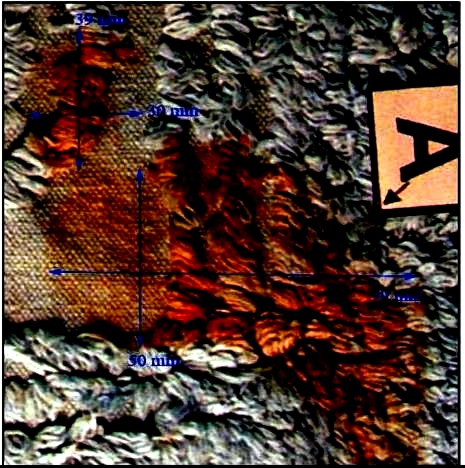
The photo above was modified by highly enhancing contrast.
6 . Enhanced contrast helps to spot some features
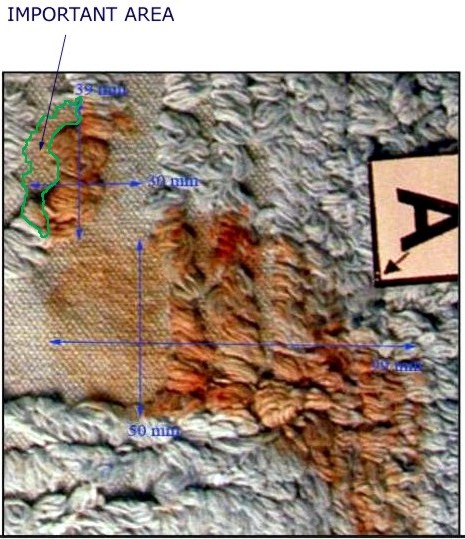
Contrast may help to highlight especially some parts of the print outline.
For example the area on the left labeled as “important area” in the picture (which was “forgotten” in the notorious photo elaborations disseminated by the ‘Friends of Amanda’ group), shows the actual left outline of the “˜big toe’ of the bathmat print.
The toe includes the area indicated in this picture (here the picture is shown again in its original colours).
7. The bathmat, with enhanced contrast
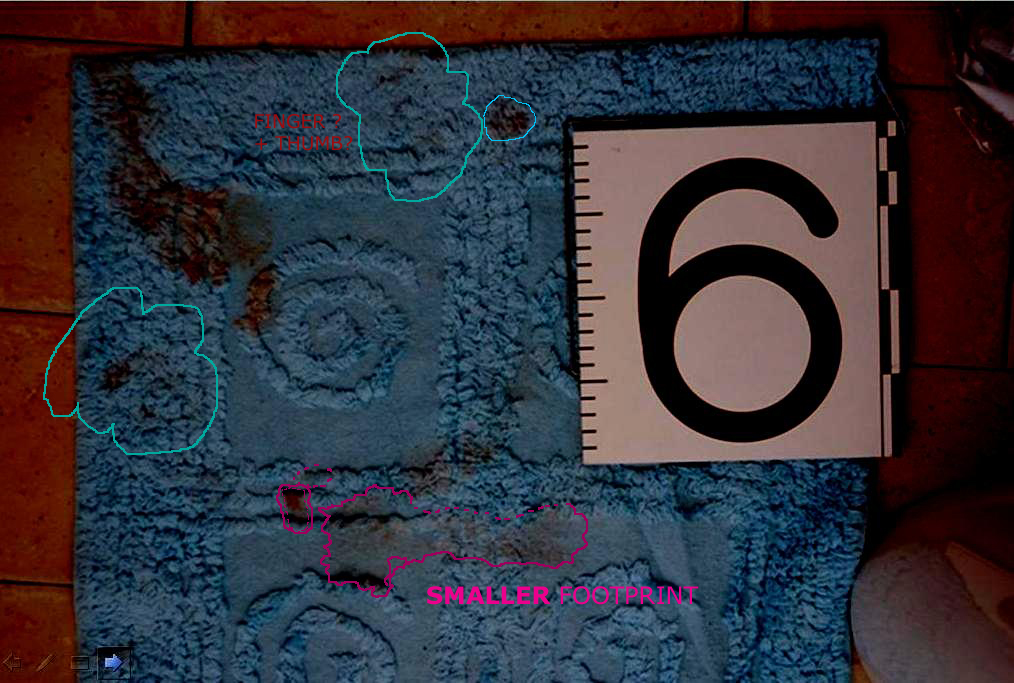
The contrasted image is showing the presence of other stains
There are other stains on the carpet (about another 10, factually situated in one half of the mat area), and also there shows a second diluted footprint (apparently from a foot of smaller size).
8. The selection of a set of red colour shades, outlined by an automatic outline generator
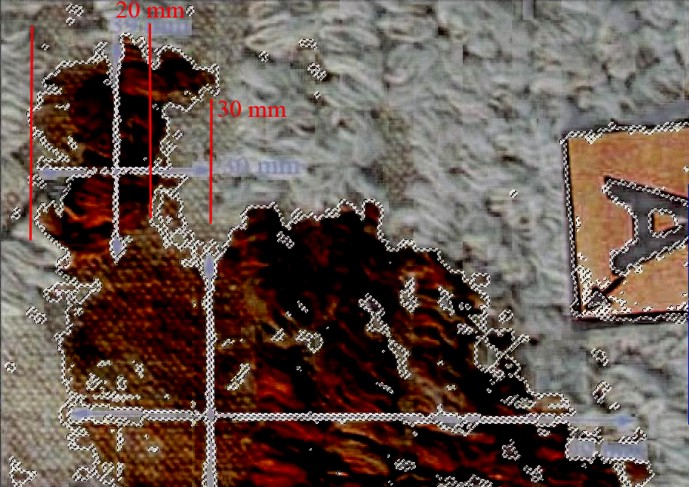
Shows the shape and the possible “˜outline’ of the stain
Reference measurements indicate the width of the “˜big toe’ in millimetres.
9 . A hand drawing of the outline (detail).
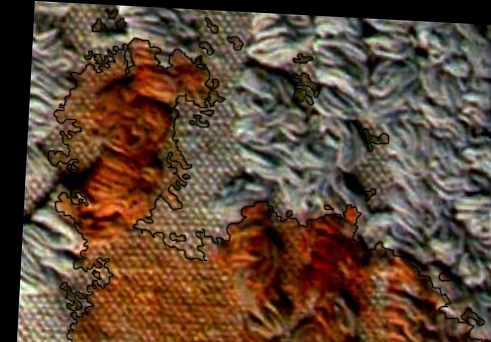
The photography above was modified
The modifications are: +28% contrast, -8% luminosity, + 20% colour saturation, from the original.
An outline has been drawn manually on the photoshop image, trying to be as faithful as possible to the actual stain.
You can notice that, apart from some minor “˜disputable’ very faint areas (such as the area between the toe and the metatarsus) there are only minimal differences between an automatically generated outline and a manually drawn one.
The shapes of the “˜big toe’ are extremely similar in both contours (images 8 and 9), in fact all meaningful features are basically identical.
We consider this manually drawn outline as good for comparison.
10 . The complete hand-drawn outline
11 . Minor detail: small dots separated from the main stain

Observe the small red ‘dots’ in the picture above
Although we can’t draw any conclusion about their possible significance, we note the existence of these very small “˜spots’ of a faint red colour shade, separated from the big stain.
They are detected by the computer generated outline above, and that we also see as distinguishable with the naked eye thus we considered them in drawing manually the outline.
We don’t draw any conclusion about them; but because of their sensitive position (they may suggest a “˜small toe’ mark) we take note of them.
The green arrows in the picture point out their position (green circles).
12 . An image in electronically modified colours
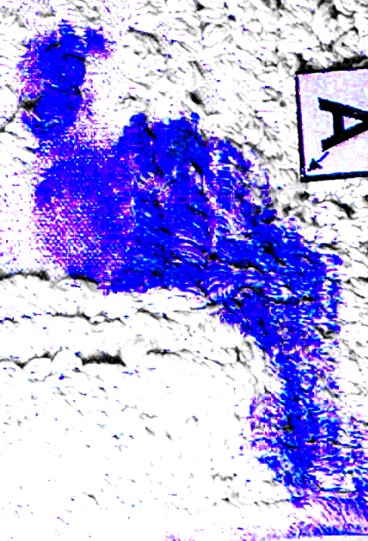
Distribution and intensity of the colouration
As a part of the preliminary study of the stain, we also produced this image above where the computer assigned an artificial colour to an array of shades of ‘red’, thus allowing to further isolate the stain from the background for further assessments about its shape.
This picture shows the distribution and intensity of the colouration. (note: the existence of some above mentioned tiny marks is recorded by this technique too)
13 . The bathmat has a spiral-shaped relief decoration
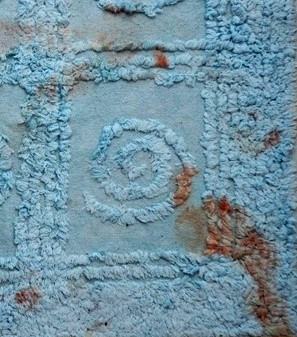
The footprint’s toe obviously balancing on top of the relief decoration.
We think the outline of the “˜toe’ mark of the bloody footprint is affected by the shape of the decoration, in particular the missing part of the toe on the right side, which is remarkably coincident with the margin of the decoration.
So that on that side there is a striking correspondence between the outline of the “˜negative area’ ““ the fabric surface around the spiral, which is lower ““ and the big toe’s outline
This indicates that the outline of that mark on that side was affected by the decoration margin, thus the print there has a “˜missing part’. So the “˜crooked’ bloody area in fact follows the margin of a larger toe.
Because of such coincidence, we can logically assume that the actual shape of the big toe mark appears to be part of a big toe, with larger surface which left its print only partly because part of its surface did not have contact with the fabric, in correspondence of the “˜negative area’.
14. The “negative area”
15. Mat decoration in relief and the toe mark
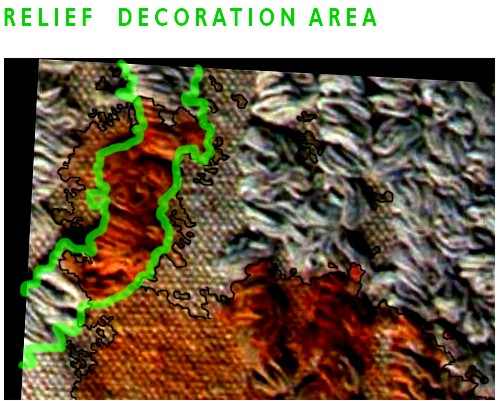
Observe above one single, unitary stain
The remarkable coincidence between the outlines of the decoration in relief and of the toe mark is shown in the picture above.
The rough contour of the print obtained through a smooth curve highlights the shape of the big toe.
Part of the relief decoration outline coincides with the toe mark outline, which shows, highlights and explains how all parts of the red toe mark, that you can see left of the relief decoration, they all belong to one single, unitary stain.
Thus we can deduce that the “missing” area on the right of the toe is determined by the decoration, and coincides with the negative area.
16. Picture (by Kermit) showing a rough shape of the stain
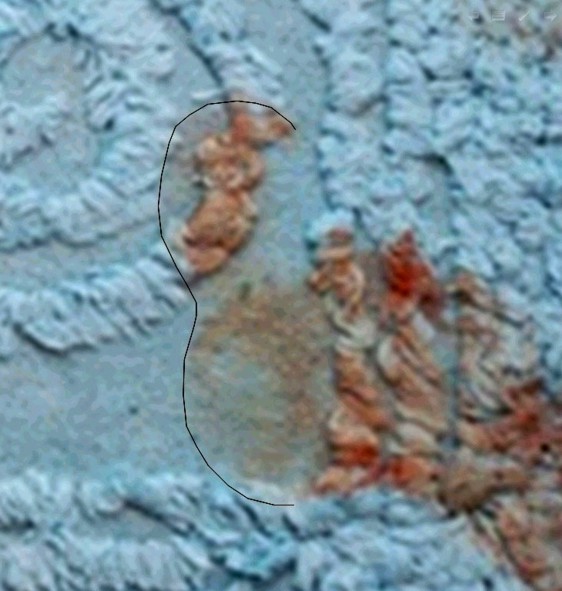
Observe shape, curvature and size
This drawing by Kermit above highlights the rough shape, curvature of left margin and overall size of the big toe.
17. Rudy Guede’s sample print
A copy of this picture together with one of Sollecito’s print at the same scale will be used for comparisons.
18 . Raffaele Sollecito’s sample print
A copy of this picture together with one of Guede’s print at the same scale will be used for comparisons.
19. Part of Rudy Guede’s sample print with Rinaldi’s reference measurements
20. Part of Sollecito’s sample print, with Rinaldi’s reference measurements:
21. Bringing all photographs down to the same scale
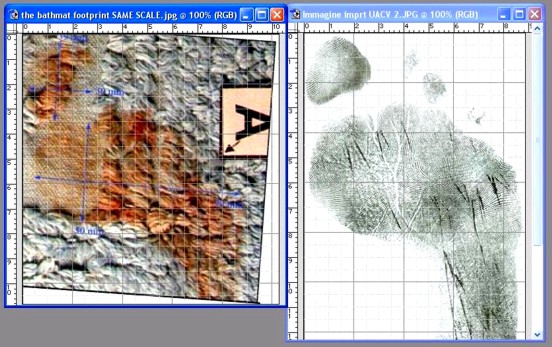
An accurate exercise of scaling was done
This was based on Rinaldi’s referenced pictures. Each one of the Rinaldi’s sample pictures has multiple measurements on several points of reference which allow a high precision determination of their scale and sizes, and thus comparison at the same scale.
In order to further increase scaling precision, the scale was calculated previously and separately for each comparative measurement in the three photos; this was done multiple times for each measurement and the average was picked in order to reduce error as for statistical measurement method.
The resulting final error in the scale is extremely small, far below a threshold of significance that could affect comparison (which was set arbitrarily at 1%, but it’s probably significantly higher, while the actual error is much lower).
In other words, the scale error that may affect your screen pictures will be definitely smaller than any possible perceivable (either significant or tolerated) difference that would be noticed or that may affect the attribution of the stain, when this is compared to the sample.
22. The hand drawn outline is shown again here
23 . The outline (matched scale) overlapped on Sollecito’s sample footprint
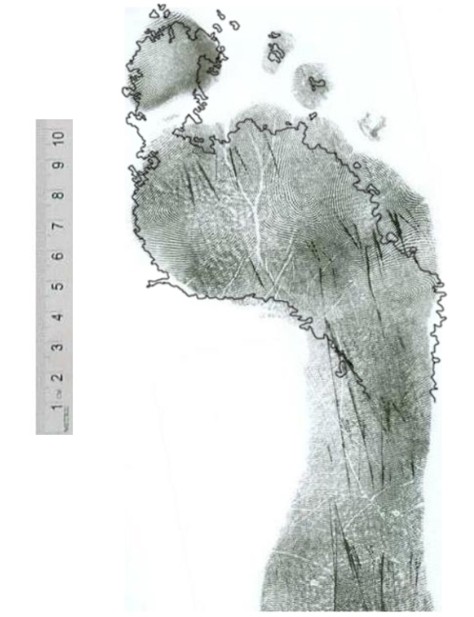
The array of compatibilities with Sollecito
The bathmat stain does not seem to have major incompatibilities with Sollecito’s print; it shows rather an array of compatibilities that can be perceived visually.
One interesting feature is the shape, size and position of a ‘big toe’, that appears as a remarkable coincidence; the toe also has a kind of cleft (see 28 below) on the curvature of its left margin. Another outstanding coincidence is the curvature of the plantar arch on the left.
24 . The same outline overlapped on Guede’s footprint
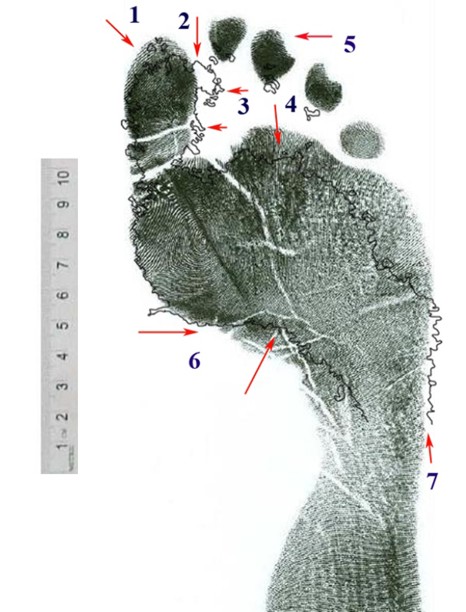
Compare with Guede’s - matched scale.
If you look at the overlapping of the stain outline (see pic 22.) with the sample of Guede’s print (see pics 17. 19.), you may notice 7 major differences, showing a failure of compatibility. Those differences are indicated by numbers (1-7) in the picture .
Each one indicates an area of major difference between the outline of the bathmat stain and the outline of Guede’s sample print. Those measurement differences are remarkably larger than those that can be detected on the overlapping with Sollecito’s sample print.
On the other hand, the compatibility between Sollecito’s print and some very peculiar aspects of the bathmat print (such as a 30mm wide and short toe) were absolutely remarkable.
The differences between the bathmat stain and Guede’s print are :
1) Toe mark of stain is significantly SHORTER than the big toe in Guede’s sample print (a difference of about 7 millimetres). Some people may want to attempt an objection, by suggesting that such a difference may be just a consequence of the position chosen for the overlapping, that maybe the bathmat print was just positioned too low in the picture, the problem may be solved by shifting it up about 7 millimeters so as to make the tip of the bathmat toe ‘coincide’ with the tip of Guede’s print toe.
However, such objection wouldn’t work; it’s a wrong argument. In fact the only possibly correct position for overlapping the bathmat stain outline is determined by the left curvature of the ball of feet and plantar arch (the area of the picture near number 6), which is by the way the most clearly outlined part of the bathmat stain. If you shift the bathmat stain upwards, the outline will miss the match with the curvature of the left margin of the ball of the feet. You will notice that the plantar arch in this area is already very incompatible with Guede’s plantar arch. It tends to become even more incompatible the more you shift the bathmat stain outline towards the toe.
The problem has no solution, since the more you shift the stain outline upwards (in the direction of the toe) in an attempt to make it look more ‘compatible’ with the length of Guede’s toe (or with an upper margin) the more it will become incompatible with the plantar arch. In order to limit the incompatibility of the plantar arch, and in order to keep an overlapping of at least the left margin of the ball of the feet, you need to place it as shown in the picture, this is the position of ‘maximum’ compatibility between the bathmat stain and Guede’s print. Conclusion: the bathmat toe is too short.
2) Toe mark of stain is TOO WIDE (30 mm). It is much wider (30 mm) than Guede’s toe. The number 2. indicates the protruding mark at the upper right, the mark which Giulia Bongiorno desperately insisted on calling a “second toe” mark. In fact, not only would the mark miss completely any hypothetical Guede’s ‘second toe’ in any possible position of the print; also you may notice (highlighted by pics 8. and 9.) how it is not a “mark” itself, but actually it just part of the same area which is entirely continuous in shape and coloration with the rest of the toe mark, and - the most remarkable feature - its right outline is coincident with the outline of the spiral-shaped relief decoration, so that you can reasonably conclude that it is determined by that (the missing area at the lower right of the ‘big toe’ is determined by the existence of the “negative area” of the bathmat decoration).
Conclusion: the bathmat stain has a wider toe mark, however one likes to call it (“big toe”, or “big toe + second toe”) that fails to match any possible part of Guede’s print. The bathmat print is clearly different and incompatible with Guede’s print. It simply cannot be overlapped to any part of Guede’s sample print. Such area is a very significant difference that points outright to incompatibility between the stain and Guede’s print.
3) The toe mark is larger also in the area located at the lower portion of the toe. The toe of the bathmat print in fact has a ‘right margin’ which actually has some additional small marks, small drops protruding towards the right, like droplets maybe produced by the wet cotton fibres of the part in relief which protrude towards the right. This tends to suggest the toe area of the stain may in fact be considered wider: the object that produced it was definitely wider than 22mm, in this area of the toe as well. So also a look at this area confirms that the bathmat stain is wider than 22-23 mm (more towards 30 mm) not just when measured at the upper corner (number 2.) but also at its “lower” parts; here, the small marks caused by the liquid suggest that a larger surface has squeezed liquid from some fabric threads leaving some trace also on the lower area.
4) Bigger incompatibility of Guede on the metatarsus front outline. This area is the front outline of metatarsus: the stain is almost 1cm shorter than Guede’s metatarsus. This happens when you chose the overlapping so as to make the left outline and plantar arch (6.) of metatarsus coincide, as in the picture. Sollecito’s sample print also shows some difference from the stain in this area (pic. 23.) but the difference between the stain and Sollecito’s print is significantly smaller than what you can see in Guede’s print.
5) There are NO SMALL TOES in the bathmat stain. Small toes are completely absent from the bathmat stain (while the tiny blood marks around the stain don’t coincide with their expected position if it was Guede’s print). Such lack of small toes is a peculiarity of the bathmat print. This is a remarkable difference from Guede’s print, and at the same time, a considerable analogy with Sollecito’s print. In fact one outstanding feature of Guede’s print is the evidence that Guede places a big load of weight on his small toes while instead Sollecito has a posture with a weight distribution with the contrary tendency, and obviously he almost does not touch the ground with his small toes.
Thus, Guede’s small toes are all very well pressed on the ground and thus, we can reasonably infer they are somehow naturally likely to get wet if he steps on any wet surface, and anyway they should get wet for sure if the foot is immersed in water or washed (the foot that left the bathmat print must have been immersed in bloody water). The murderer supposedly washed his foot then stepped on the bathmat. In order to attribute the print to Guede we should assume that Guede “forgot” to touch the carpet with his small toes (while instead he puts a lot of weight on them) or that he managed to not rinse them.
6) The outline of the stain has a PLANTAR ARCH that COINCIDES, by curvature and angle, with the plantar arch in Sollecito’s print, while instead it is very different from the plantar arch of Guede’s print.
7) The stain is larger than Guede’s print metatarsus as visible in the right area of the stain. The difference is rather significant, almost half a centimetre, that is bigger than the difference with Sollecito’s print which instead coincides for a trait. This difference cannot be “solved” in any way since, even if one wanted to claim that the scale is wrong and that the stain should be sized down, this would make the toe, already too short (as in 1.) become even shorter.
If instead the toe length is adjusted the metatarsus becomes even less compatible with Guede. We recall that Massei found that Guede’s feet had a print overall more slender than Sollecito’s.
25 . Other features:
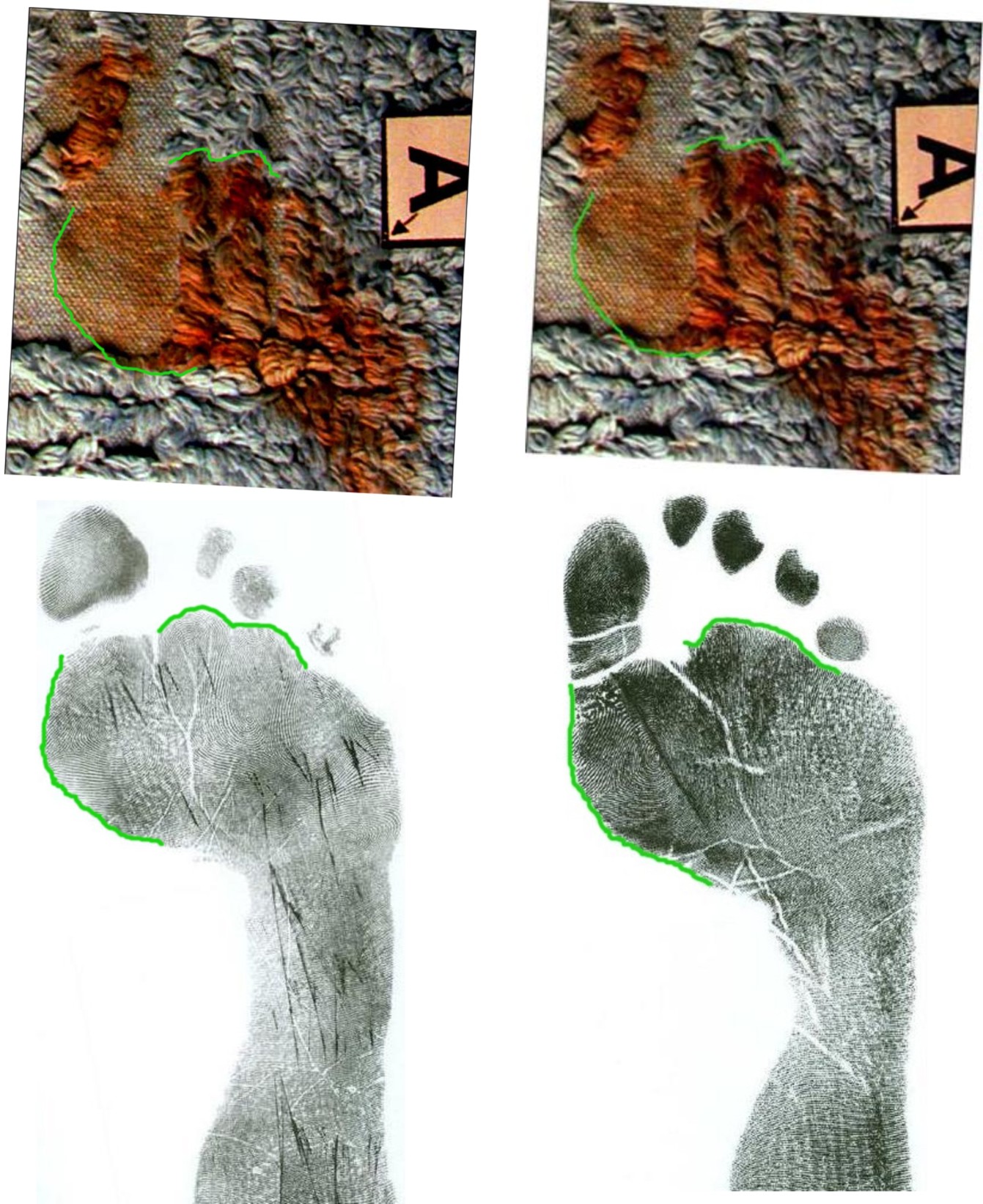
Curvatures of plantar arch are very different
The plantar arch curvature, highlighted in two different drawings (the second highlights also the upper outline “hunches”); the plantar arches in the two sample prints of Sollecito and Guede are shown below. The curvatures of plantar arch are very different.
26. The outline curvature generates different angles
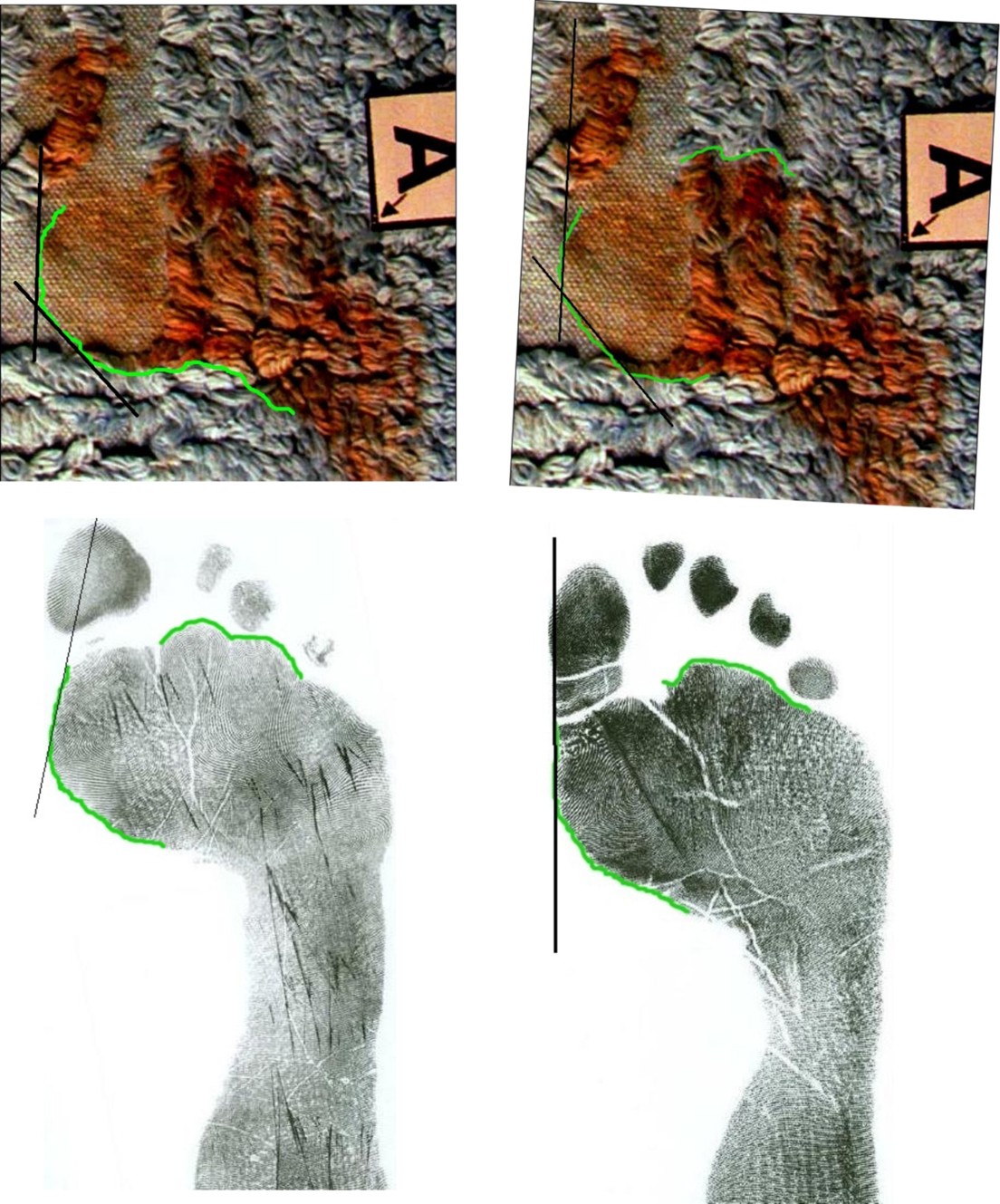
Sollecito’s and Guede’s plantar arch curvatures have very different angles. Also the left outline of metatarsus maintains a different curvature. Sollecito’s outline has an angle (see outline tangent) intersecting the toe (the metatarsus has a “bunion”); in Guede’s print there is basically no intersection, the outline and the toe form almost a straight line.
27 . Plantar arch curvature angle differs between Sollecito and Guede
If you consider the vertical axis of the sample footprint, and its orthogonal line, you may notice how the plantar arch curvatures of the two prints accomplish different angles: the two angles are VERY different, not just three or four degrees.
The (too) narrow angle of Sollecito’s plantar arch probably has a relation with the protruding outline and angle seen in pic 26., and seems related to a hallux valgus (which Guede does not have).
28 . The “cleft” on the left side of the stain
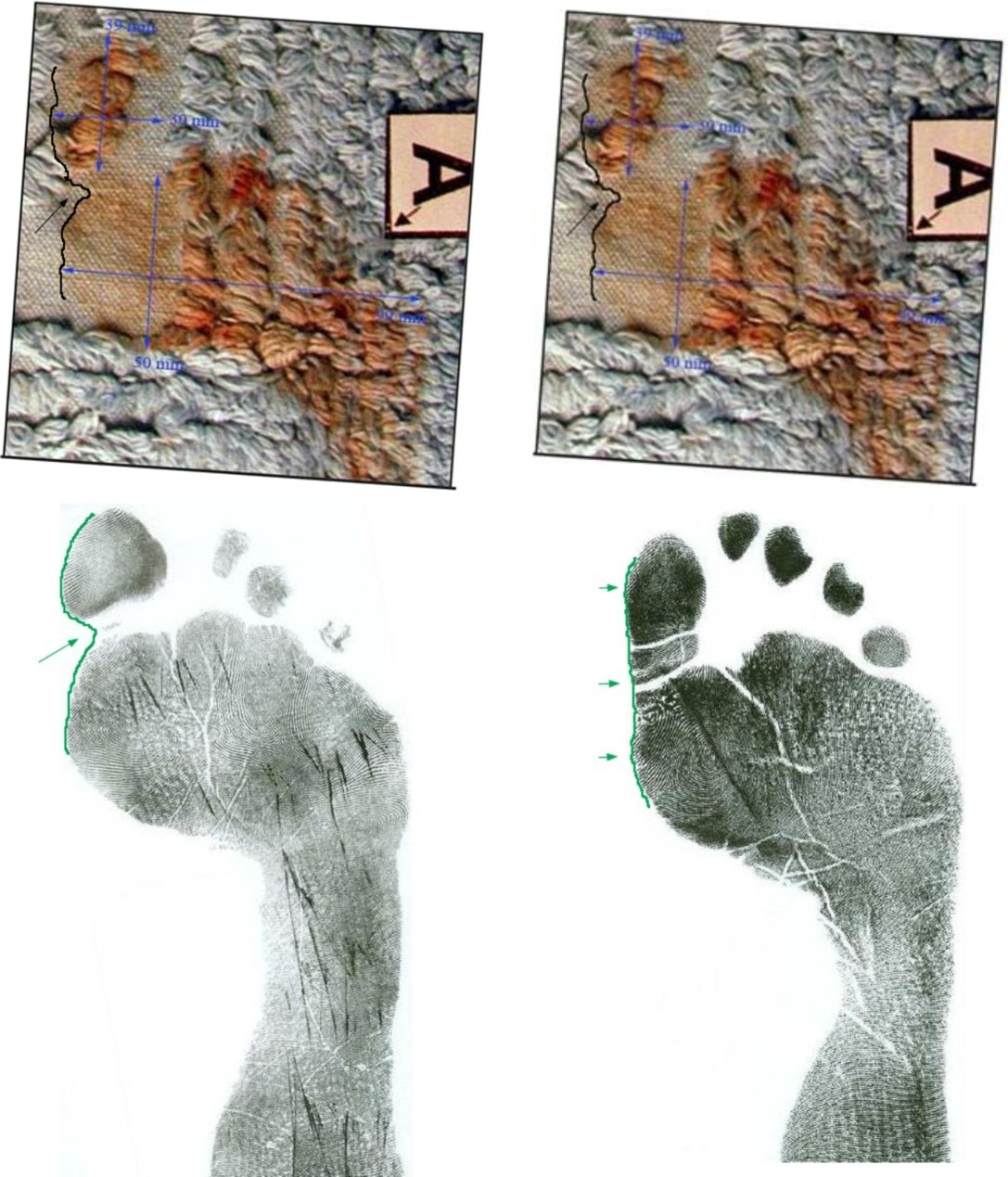
The “cleft” on the left side
This has a correspondence with one sample print, not so with the other.
29 . Table of metric comparison (by SomeAlibi)
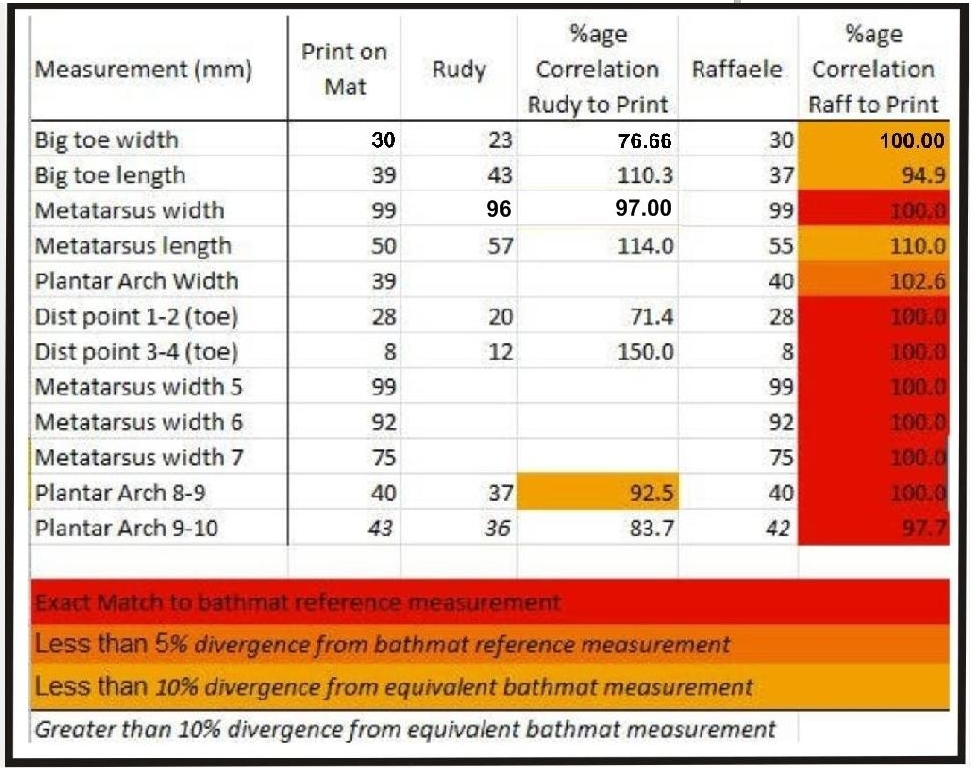
SomeAlibi’s post of a year ago
Comparison of measurements and analysis of correspondence degree of bathmat print, with both Guede’s and Sollecito’s sample prints.
Monday, February 03, 2014
Authors Of “Math On Trial” Bring The Explanations Of The Hard DNA Evidence Up To Date
Posted by Peter Quennell
The important new book in question Math On Trial is by mathematicians Leila Schneps and Coralie Colmez who is Leila’s daughter.
This article by Leila Schneps appeared in yesterday’s edition of The Independent and explains why the Nencini court has not ruled out any of the DNA evidence.
It’s not right to say there is “˜no evidence’ in the case against Amanda Knox. There’s plenty
The DNA alone is enough to raise questions
The verdict handed down yesterday at the new appeal trial for Amanda Knox and her former Italian boyfriend, Raffaele Sollecito, accused of the murder of British citizen Meredith Kercher in Italy in November 2007, may come as a surprise to those whose view of the case has been affected by an international media blitz based on the oft-repeated claim “There is no evidence”. Many believe that Rudy Guede, convicted in October 2008 for participating in the murder, acted alone.
There is, however, copious evidence to consider: the DNA alone is enough to raise questions. Leaving aside much of it, let’s focus for a moment on three key pieces of DNA evidence and present them from both sides, just as the jury may have heard them spoken of in court.First ““ the bra clasp.
The part of the victim’s bra containing the hooks had been ripped or slashed from the rest of her bra. Not immediately collected on that first day after the murder, it remained in the room in a sealed house for six weeks before being sent to the lab in December. There, it was tested and found to contain a large sample of Meredith’s DNA, together with a smaller but clearly visible contribution from Sollecito. The defence objections: firstly, between the two searches, objects in the crime room had been moved around, and indeed the bra clasp was found about a metre away from its original position.
Secondly, apart from “˜alleles’ - genetic traces - of Meredith and Sollecito on the clasp, there were a few unidentifiable extra ones. Putting these two facts together, the defence pointed out that Sollecito’s DNA on the bra clasp could have been a consequence of a careless police technician stepping on Sollecito’s DNA elsewhere in the flat and then entering the room and stepping on the bra clasp, even though no DNA of Sollecito was found anywhere else in the house except on a single cigarette butt in the ashtray.
Second ““ the mixed stain.
Although not visible to the naked eye, the chemical Luminol which flashes blue on contact with blood revealed a spot in the room of the flatmate whose window had been smashed and room rifled. Swabbing the spot produced a mixture of Amanda and Meredith’s DNA. This is a clear proof that the murderer entered that bedroom after the murder, as someone must have brought Meredith’s blood into the room, contradicting the defence theory that Rudy Guede broke into the house and then committed the murder.
The usual defence explanation for mixed DNA stains in the bathroom and corridor, namely that the house would have been coated in Amanda’s DNA given that she lived there, does not necessarily apply to a flatmate’s bedroom. It is much harder to leave traces of DNA than is commonly conceived, and hardly any of Amanda’s DNA was found in her own room - where she surely spent a lot more time than in her flatmate’s.
Lastly ““ the knife.
Days after the murder, a large kitchen knife was seized in Raffaele’s flat, where Meredith had never set foot. Police geneticist, Patrizia Stefanoni, swabbed spots on the blade of the knife and on the handle in the knife’s first DNA Test. One spot in particular attracted her attention: a visible scratch on the flat of the blade. The swab taken from this scratch yielded a positive ID for Meredith Kercher.
By the third trial, when a new attempt was made to collect DNA from the knife (which had been swabbed again during the appeal trial, though no tests were then conducted) there was no match to Meredith ““ a result welcomed by Knox’s defence team, though it did not in fact impact on the findings of the first trial.
Stefanoni’s test ““ she only conducted the first - came under strong fire in the courtroom. Two independent expert witnesses called in for the appeal against Knox and Sollecito’s original 2009 conviction stated that she had not worked in conformity with standard international protocol. Indeed, standard protocol for DNA testing involves three steps: first determining how much DNA is in a sample, secondly amplification, which reproduces the sample millions of times, and thirdly electrophoresis which produces the familiar DNA graphs showing peaks in the location of an individual’s alleles. Under cross-examination, Stefanoni explained that quantification had given a result of “too low” as the machine she used that day was not the most sensitive one in the lab.
Knowing that samples undetectable by the machine can still be sufficient to yield positive results, she chose to continue with testing. At the second stage of testing, amplification, a sample will normally be split into two or more pieces in order to run independent tests. But knowing that the sample was small, Stefanoni feared that cutting it in two would yield no result at all, and chose to amplify the entire sample in one unrepeatable test. The end result was a perfect match to Meredith Kercher.
Knox’s supporters have claimed since the beginning that the accusations levied against her are based on the Italian justice system’s hatred of a pretty, American girl who likes parties and having sex. And whilst both parties protest their innocence , Thursday’s decision shows that there is real evidence against her and Sollecito, that cannot be ignored.
Monday, January 27, 2014
An Investigation Into The Large Knife Provides Further Proof That This Was THE Knife
Posted by Ergon
Overview
This is the first report of an investigation (the second part follows soon) of the kitchen knife used in the murder of Meredith Kercher, RIP.
Specifically its compatibility with the imprint of a bloody knife found by police investigators on her bed under-sheet which as you will see here seems possible to prove.
Two other recent posts also concentrated on aspects of the knife as strong proof: (1) proof of both Knox and Kercher DNA and (2) proof from the throat wounds.
- Reference files are from very high definition crime scene photos not in general circulation.
- Grateful thanks to the volunteers of the Meredith Kercher community who assisted in this production
Florence Court of Appeals
This is our poster Machiavelli, tweeting from the Florence courtroom on November 26, 2013:
“(Prosecutor Alessandro) Crini stated that this kitchen knife was compatible with the knife print on Meredith’s bed sheet”.
And this is from the defense summing up on January 09, 2014:
Bongiorno: “It’s too big, not the murder weapon.”
“Bongiorno shows a picture with an envisioned “knife” (pocket knife belonging to Guede?) together with the print on the bed sheet.”
“Nobody brings a “small blow with a big knife” “You don’t use half of a big knife” (she says)
Genesis of an investigation:
To recap: evidence was been presented at the Massei court of the first instance, which accepted that the kitchen knife, containing both Meredith Kercher’s DNA on the blade (trace B) and Amanda Knox’s DNA on the handle (trace A) was the weapon that struck the fatal blow to Meredith Kercher’s throat.
At some point after the attack, the perpetrator, Amanda Knox, puts it down on the bed, leaving “hematic stains” (bloody imprints) on the mattress.
The court concludes the shape of the imprints are compatible with the kitchen knife. It also concludes, based on the size of a lesser wound that a second, smaller knife caused the wound on the other side of the neck, and, the impossibility of accepting that a single weapon inflicted both wounds.
This is what it boils down to now, as we come to the final arguments of this case on January 30, with a decision to be handed down by the court later in the day:
- Was the kitchen knife found in Raffaele Sollecito’s kitchen the murder weapon that killed Meredith Kercher on November 01, 2007?
- Did the killer leave behind proof in the form of bloody imprints on the under sheet covering Meredith’s bed?
- And is the defense trying to divert attention away from it, even though the image on the bed fits the dimensions of the kitchen knife?
- And pointing to a second knife, not ever found?
This article (to be followed by part II) was prepared to offer answers to these questions.
Methods used
As someone with a keen interest in photography, I know we see things in photographs that are not always apparent to the naked eye.
Where before we had all been misled by low definition photographs released by the defense to obscure incriminating details, I was able to obtain and view the high definition photographs shown here that proved that indeed, the bed imprints matched the seized kitchen knife, exhibit 36.
These photographs, first posted at Perugia Murder File Evidence Files have been circulating for some time, with members trying to match the knife to the bed imprints, but not, in my opinion, being able to match it exactly.
First, note that the killer placed a knife on two separate locations on the bed, marked by reference cards “J”, and “O”. (Reference photos below.)
I discarded “J”, because there was too much blood there to form an accurate measurement. The killer lifted the knife and then placed it at “O”, which gave a better image, but even then, did not match exactly. Still, it was clear the images looked like a kitchen, and not, a pocket knife as alleged by the defense.
Looking at the reference photo, I saw a double image of a knife blade at “O”. (see where there’s a curved edge of the blade? That’s what convinced me there might be a double image there)
Conclusion reached
My opinion is the knife shifted slightly when it was placed there, hence the double image, which now made a perfect match with the kitchen knife, in both instances (see reference photos).
So I got a professional illustrator and other skilled people people to do the scale drawings and produce the video you see above which seems to provide conclusive proof the murder knife was placed on the bed.
Reference photos:
Image 1 above (click for larger image): Bed II (Image J and O on under sheet, shot November 02, 2007)
Image 2 above (click for larger image): Knife II (Image O on under sheet, shot November 02, 2007)
Image 3 above (click for larger image): FOTO5BIS (Conti-Vecchiotti lab, Mar. 22, 2011)
Image 4 above (click for larger image): Knife-Bed-Vector-AllScales (To prove the scales used to match the images)
Image 5 above (click for larger image): Knife-pos-lower-hi (The knife’s first resting position at “O”)
Image 6 above (click for larger image): Knife-pos-upper-hi (The knife’s final resting position at “O”)
Next steps
There are only four more days left till the Florence Appeals Court under Judge Nencini issues its verdict. It must of course consider ALL the evidence, of which there is a preponderance that indeed suggests the verdict will, as would be proper, be guilty as charged.
Part II will be ready ASAP. It will be a recap of Massei on the knife, and how the defense continually tried to divert us away from the knife image by saying it did not fit the dimensions of the major wound. Also will have Frank Sfarzo’s misdirection and Bruce Fischer’s amateurish attempts to prove that Rudy Guede caused the knife wounds.
Happy as always to do my share for justice for Meredith Kercher.
Tuesday, November 26, 2013
Appeal Session #5: Prosecutor Alessandro Crini Concludes, Proposes 30 Years For AK And 26 For RS
Posted by Our Main Posters
Overview
This is the report on the second day of Prosecutor Crnini summarizing the entire case.
This was not attempted at such length at the 2011 Hellman appeal and that panel of judges was perhaps not ever fully in the picture. The first day of the presentation is reported on here.
Real-Time Reporting, Bottom Up
4. Assessment by main poster SeekingUnderstanding
The case put forward by the prosecution and reported to us by Yummi is almost startling in its lucid and concise approach.
It couldn’t be more in contrast to the equivocations and disingenuousness, as well as irrelevant sentimentality that we have unfortunately become used to witnessing. The cutting use of logic was therefore refreshing, and gives grounds for optimism, albeit it tempered by unknowns.
All the issues seemed to be addressed from the base line, as if from primary considerations. And many points were simply politely dismissed as being unimportant to the true case in hand -which is the establishment of the guilt (or not) of the accused. For example, it was great to hear that the reason why the knife had been brought to the cottage need not be examined - it was enough that it was there.
It seemed that where the defence had challenged the evidence, for example suggesting contamination of DNA, it was here that Crini spared no detail, and took time in bottoming out the logic, and dispensing with their points. His arguments certainly carried conviction to me.
I was glad to see motive and behavioural dynamics looked at, as indeed Cassation had requested. It seemed good too that Crini ruled out premeditation, and reduced the dynamics to something highly plausible and believable as well as simple. There are just two points I might observe :
First, it would seem within character for Meredith to have been both open and direct in confronting issues of hygiene, drug use, infringement of privacy and noise etc., (or even theft of rent money, another possibility). I am not convinced that she would necessarily have been aggressively confrontational. Someone who is relaxed within themselves, accepting of their self, is well able to be assertive in a non-provocative manner. That is quite British too - especially old-fashioned English.
Secondly, bearing in mind the possible or probable profiles of the defendants, it would not have taken more than one small trigger of reasonable confrontation to release the consequent temper-tantrum or drug fuelled rage. I do not think we are dealing with something proportionate - and this is also why it escalated in the terrifying way it did. I don’t think it is essential to hypothesize as to what in particular Meredith raised an objection to (e.g. Rudy’s bathroom event). It is probable that Meredith’s concerns were reasonable, and then the overly defensive and angry reaction to any criticism whatsoever was unreasonable. I personally think this is enough.
I liked the way Crini said that even though a source is unreliable or not credible in some ways, that does not mean they do not (inadvertently as it were) give out information that is also true and useful. Possibly other statements from Guede might be taken into account in this way?
As a psychologist, it would seem dialogue with Rudy might yet be fruitful, but, with things the way they remain with the other two, it does not seem the time now for further words. Something else needs to happen.
3. Assessment by main poster James Raper
Crini spent about 10 hours in total addressing the court and was certainly very thorough. Maresca was so impressed that there was no need for him to add anything further.
Crini came to the prosecution case without the baggage of having presented any previous scenario or of having had his reputation sullied and slandered by the Knox PR machine. He reviewed the evidence dispassionately and found it compelling.
Clearly he also found the previous machinations of C&V and the Hellmann court objectionable and went in hard here, even discussing previous cases where Vecchiotti and Conti had goofed up. Hellmann had tried so hard to avoid that coming out during his appeal.
He was not, however, averse to taking a different tack where he thought this was appropriate. A sign of his intellectual honesty which may have impressed the court.
For instance, he thought that there was no need to nail TOD down to 11.30pm as Mignini had sought to do. He allowed for an earlier TOD.
He was of the opinion that coming up with an exact time line for a period in which there is no alibi, and when there is already evidence of involvement in murder, is of only marginal interest.
He spent well over an hour discussing the knife. He did not think it necessary to mull over how it came to be at the cottage. That is speculation that need not detain anyone if the knife is accepted as the murder weapon, and he thinks that on all the evidence it is.
He ruled out premeditation, even as to a hazing, and presented a very simple scenario as to motive and the dynamics behind and during the attack on poor Meredith. Keeping it simple makes it understandable to everyone. Elaborate further and you risk alienating someone who disagrees with the elaboration and thinks they have a better theory.
My only objection is that it is a tad ridiculous to believe that Meredith objected to poop being left in the toilet, the toilet she didn’t use. But yes, the objectionable behaviour of a trio of drunken/drugged up louts invading her space would most likely have triggered argument, unpleasantness and then a fight.
There is plenty of character evidence to support that scenario and with a little imagination, and some recollection of one’s student days, one can easily see how this might have gone. In a way, and Crini admitted to this possibility, Meredith’s own behaviour, or misreading of the situation, may also have been a trigger. Whether one agrees with this or not, it is at least a believable and honest suggestion.
So he set out base camp for the court (bearing in mind that Cassation had suggested that behavioural dynamics be given serious consideration by the appeals court) and whether the judges elaborate further (perhaps by conjecturing a possible range of equally valid motives and dynamics) is up to them.
2. Assessment by main poster Hopeful
Crini is magnificent! He’s absolutely crushing the defense. He nails Knox as having left her bloody shoeprint on the pillow under Meredith.
He accepts Novelli who found Meredith’s trace on the knife. He believes Knox left DNA on the knife. He quotes from differing experts Gill and Balding and says Sollecito’s DNA on the bra clasp stands.
He describes a small, very sharp knife that he believes was used to cut off the bra in several places. He says the knifeprint on the sheet was from the big kitchen knife.
Crini contends that the strong bruise marks around Meredith’s mouth were from restraining her and blocking the scream.
He believes this fight was caused by Meredith angrily reacting to Knox’s constant dirty ways in the cottage and Guede’s nasty toilet habit along with his and Sollecito’s unwanted presence in the cottage that night.
Crini argues a crime of rage when Knox was confronted by Meredith, citing Laura Mezetti’s remarks about the cleaning conflicts. Crini says that Meredith’s scream is what caused the fatal knife blow to silence her.
Not premeditated, the murder was the final result of the perps’ terror that they had gone too far during the raging fight. He’s asking for 30 years for Knox and asks to increase sentence for calunnia to 4 years, inclusive in the 30.
He almost laughs at Knox’s weak excuse over the drops of her blood found in the bathroom, saying she would surely have known if she bled.
He confirms the storekeeper did see Knox early in the morning after the crime. He finds no proof of Sollecito being firmly at his computer sending emails during the crime. He blasts the Knox and Sollecito alibis as being a tissue of lies.
Crini has another ex-Supreme Court justice standing with him in the Florence courtroom! (Baglione). Crini has worked extremely hard. He has conquered this convoluted pack of lies and distortions and his diligence shows. He upturned the applecart of Conti-Vecchioti nonsense and thoroughly redeemed Stefanoni’s findings.
He has completely severed the heads of this Medusa Gorgon mess, Crini is the bomb!
1. Tweets continue from main poster Yummi
114. This means a total request of 30 years for Knox and 26 years for Sollecito
113. [Propose] 26 years for both for the murder
112. The murder is contextual, their was no premeditation, and no futile motive
111. Because of their staging and denials, they should not be given generic mitigation for murder.
110. Requests to increase the penalty for [Knox] calunnia to 4 years
109. But experience tells statements of unreliable perps do contain revelations about the truth. The ‘argument’ between girls, why such context?
108. Rudy Guede has no credibility, even if the Supreme Court is right that this cannot depend on his refusal to answer.
107. Crini cites Laura Mezzetti about the ‘annoyance’ caused by Knox on house cleaning issues.
106. Meredith was the one triggering an argument because of the ‘impolite’ invasion and behavior. She accused Knox .
105. Rudy was not sober, quite high, a bit annoying, and was acting the same disgusting way he behaved downstairs days before.
104. Meredith Kercher was sober, fully awake. The others were at least ‘smoked’, a bit high, Rudy was there in the house.
103. The motive is not futile, the motive is terror, it is the consequence of the prior aggressive action in which they were involved.
102. Nothing points to an agreed plan among the three that run out of control; the first cause was an aggression, a clash, impetus of rage
101. Crini: there is a prosecution duty to conjecture a motive.
100. The blood drop on the tap: a point is Knox does not explain, guesses, while she must be aware that she bled in the bathroom.
99. Crini believes the shoe prints on the pillowcase are from a female’s shoe as suggested by police
98. Knox’s DNA between the blade and the handle (36-i)is very significant. It’s not from sweat or contact.
97. The print on the bed sheet is compatible with the kitchen knife.
96. Crini: we don’t need to figure a reason for a kitchen knife to be carried from one apartment to the other..
95. The bra straps are cut in multiple points, not with a kitchen knife.
94. Sollecito cut her bra with a knife in multiple parts. hold bra to cut it - no Guede’s DNA in that point - used a small very sharp-edge knife
93. Rudy did not stab her, because he wad used both his hands, which were unarmed
92. Wounds indicate she was immobilized by multiple people, they killed her because failing to do so completely, were terrified by her scream.
91. Criticizes Torre’s theory that the large wound could be caused by a small knife: improbable, the wound has clear margins.
90. There were two knifes, one was small, not much fit to kill.
89. Ridiculous to think that Rudy Guede - which she knew - could intimidate Meredith totally to that point. She would react.
88. Specific indicator: no defence wounds; means bruises are not from fight but restraint.
87. Description of bruises and lesions around her mouth, indicates extreme force to prevent from screaming. Rest of body was also immobilized.
86. She was still wearing a blue sweater which was removed subsequently.
85. Analysis of blood drop pattern and position of victim when stabbed; body moved in a different position.
84. Location of crime - space between the bed and the wardrobe - is peculiar, analysed by UACV
83. Crini says will sketch a dynamic of events of the crime.
82. Crini says - implying Vecchiotti, Pascali - some experts should be “hold where they belong”
81. Crini recall Pascali working on the Olgiata and the Claps case (2008, 2010);
80. There is no instance of transfer of Sollecito’s DNA anywhere on the scene
79. Crini cites the Olgiata case.
78. Contamination must be deduced from context of finding and collection. You must think a practical way for Sollecito’s DNA to be transferred
77. Tagliabracci defends Vecchiotti saying the RIS statistical techniques were not used at the time; Crini cites Gill and Balding
76. Guede’s Y haplotype in victim’s vagina alone was used to identify him.
75. Sollecito’s DNA is certainly on the clasp for the police; Vecchiotti doubts but considers X separately from Y haplotype
74. The bra clasp: the first objection was the interpretation of the mixed/complex trace
73. Crini says he learned a bit of genetics working on cold cases
72. Vecchiotti and Tagliabracci have a reliability problem in relation to the case, for different reasons
71. Vecchiotti said she obtained all cooperation she required. Raw data could be accessed by accessing the machine itself as Stefanoni offered.
70. Crini says he found out the negative controls were deposited, the court will find the document of deposit etc.
69. Vecchiotti omitted to note the censures/observations written by the other consultants, this procedure is incorrect
68. Vecchiotti’s approach to the I-trace (refusal to test it ) was ‘ideological’, ‘weak’, ‘insufficient’
67. Interpretation of profile is for complex result. For non-complex profiles there is actually no ‘interpretation’.
66. Crini recalls answers by the RIS, defence tried to elicit approval of CV, but RIS said multiple test only if possible, compromise for result
65. Novelli cited saying the profile of Meredith is certain.
64. Meredith’s profile came out clean on a single amplification, means the trace is clear.
63. The meaning of test repetition is its necessity when you have a ‘dirty’, uncertain sequence like Knox’s profile on the knife
62. Novelli knows very well about double and triple amplification protocols, and Stefanoni knows well too
61. Guidelines are an indication that guide your driver, but then you have to drive
60. Someone who keeps a refrigerator like the one Vecchiotti has, should be less critical about laboratory practice
59. Crini: should we toss any result in the garbage, no matter how important and clear, whenever the test is not repeated?
58. Speaks about the single amplification by Stefanoni versus guidelines.
57. The presence of human DNA in a scratch on the blade of a knife itself is not usual
56. Crini: another introduction specific on DNA; notes btw that the new RIS finding is ‘important’ because adds information
55. Crini makes an introduction about circumstantial evidence
54. Discussion on DNA and remaining evidence will start in 1h.
53. Francesco Sollecito [in interview] was shocked, said he never expected so aggressive arguments from PG [the Tuscany Prosecutor General]
52. Yesterday, Crini spent the first hour to argue about logical ‘method’: how assess evidence altogether, examples, quotes of SC sentences
Monday, November 25, 2013
Appeal Session #4: Today Lead Prosecutor Alessandro Crini Summarises The Prosecution’s Case
Posted by Our Main Posters
Overview
This is the report on the first day of Prosecutor Crnini summarizing the entire case.
This was not attempted at such length at the 2011 Hellman appeal and that panel of judges was perhaps not ever fully in the picture. The second day of the presentation is reported on here.
Real-Time Reporting, Bottom-Up
5. Good reporting on the court today
Andrea Vogt has posted an objective report here and Barbie Nadeau an objective report here. We will post excerpts from both and other sources after the appeal session on Tuesday is done.
5. Warning about AP’s Colleen Barry
The Associated Press’s Colleen Barry is once again filing highly biased reports from the court. This is an appeal by Knox and Sollecito AGAINST a guilty verdict (by Judge Massei) and not an appeal by the prosecution to “reinstate” a guilty verdict. Get a grip.
4. Final post from the court today
It is 5:30 pm in Italy. Judge Nencini has declared today’s session at an end and he has allowed the prosecution to resume its presentation tomorrow. Prosecutor Crini has about 1/3 of his presentation on the evidence still to come.
3. Tweets from main poster Yummi
Yummi has warned us that the wireless internet bandwidth inside and just outside the courtroom gets overloaded late in the day as the reporters get busy on their reports. Yummi does have a way around this but it involves leaving the courtroom when key arguments might be made and walking some distance away. So there might be some slight delays.
[More pending; Dr Crini has alerted that his presentation will be in 16 chapters]
51. [Judge] Nencini suggests to interrupt and go on tomorrow with following prosecution’s points. New schedule.
50. Chapter 11. is DNA. Crini says we may have evidence enough by now anyway
49. Crini censures Hellmann-Zanetti’s reasoning about calunnia (why not indicate the real culprit?). Says H-Z committed ‘physical violence’ on trial file
48. Knox’s calunnia is a strategy protracted over time says Crini
47. Dreamlike component in Knox’s statement, fish blood, are devices needed to surround a calunnia strategy
46. Knox needed to put some additional content into the ‘calunnia’, says Crini, or wouldn’t be believed, so she puts in pieces of truth
45. Knox spoke about a scream an a sexual violence before anyone knew. Sollecito said nothing was stolen before they knew.
44. Points out Sollecito says Romanelli’s door was wide open; Knox doesn’t notice theft. Crini highlights the ‘combination’ of inconsistencies
43. Knox thinks locked door is normal; does not flush toilet when finds feces; does not notice blood before having a shower; thinks blood is ok
42. Notes Knox’s statements are inconsistent and ommisive before her interrogation.
41. Crini speaks about Knox’s declarations. Interested in the timings. Says too much was repeated to be coerced.
40. Crini speaks about chapter 9, the statements of Sollecito. His call to her sister. His alert was late but even so preceded the postals arrive
39. Bathmat print and luminol prints were chapter 7. of Crini’s argument; 8. is the staging of theft.
38. The most significant stain may be the one in Romanelli’s room, says Crini.
37. Speaking of a female’s print left in luminol, Crini sounds outraged, saying other substances is vague unsubstantiated conjecture [eg it was blood not bleach]
36. Guede’s sentencing was not well calibrated says Crini. But a Guede alone scenario is not tenable
35. Does it make sense for Guede to leave there the evidence of (putative) theft, and clean footprints?
34. The unitary sense made by elements like the bloody print, is a cleanup. Considers the lone-perp scenario: inconsistent
33. Crini: starts talking about the isolated bloody print; calls it a ‘talking element’. Why is that print alone?
32. Suspects are only ones with a ‘logistic’ capability and an interest to ‘clean’ the murder scene. They aimed at ‘diminishing’ the evidence mass
31. Knox’s lamp was the only light in her room.
30. Crini: the perp(s) organized a rather complex plan to clean up and ‘sidetrack’ at the murder scene.
29. Still to be determined if calunnia was “occasional” due to pressure, or “aggravated” [sidetracking]; Crini saya a ‘depistaggio reale’ (sidetracking) occurred
28. Crini: suspects’ statements are extremely interesting: RS’s statements; AK’s e-mail, internet statements, [Knox’s] memoriale
27. Crini: a most fertile chapter of analysis is the ‘post-factum’ actions and behaviors of defendants
26. Crini has unfolded five chapters. Says he has a total of sixteen
25. Quintavalle, details of his testimony and woman’s description are exceptional indicators of accuracy.
34. Crini: it is unlikely that Quintavalle got it wrong. Because of contextual elements.
23. It is incorrect to dismiss a witness a priori because late. But for reasons totally different. Sometimes late is symptom of reliability.
22. Wants to deal with the issue of the fact that he came forward late, urged by an acquaintance
21. Crini: fifth argument is Quintavalle. He says he is sure about his testimony. Is a different kind of witness
20. Crini accepts both alternatives on time of death, after 23.15 or before 22.30 (but seems to prefer the earlier one)
19. Crini: Do not overestimate importance of timings that are not anchored accurately or cannot be proven
18. Crini: timeline is marginal to the case. All unproven timings to be taken cautiously.
17. Crini starts fourth theme: timings. Says they are very vague, except the tow truck
16. Crini: Curatolo is no ‘super-witness’, but can contribute to helping the court to draw their scenario
15. Curatolo saw a couple discussing and this memory is very specific, peculiar
14. Curatolo did not confuse night with Halloween, because it was big party in piazza the previous night, and because it did not rain
13. Crini: the court saw Aviello, shows what top [level] of unreliability is; the SC suspected so unreliable that calunnia elements had to be assessed
12. Crini: many trials could not exist if drug addicted testimonies were dismissed
11. Crini: the H-Z court assessed Curatolo a priori based on him as a person, stemming from questions of the court itself
10. Crini about Curatolo, describes Piazza Grimana; he was an habitual presence of the piazza, proven reliable in other cases
9. Crini: computer records and alibi point to Sollecito being not at home but on murder scene
8. Crini cites the log files of Fastweb: no internet activity, only automatic connections.
7. Crini: failure of computer alibi is evidence against, not just lack of confirmation.
6. Nencini notes prosecution did not ask to interrogate Sollecito. Crini cites D’Ambrosio’s computer expert report. No interaction before 5am
5. Sollecito gave computer alibi days later, and words his statement in the singular form.
4. Crini: first theme he deals with is presence of crime scene; alibi, if it’s false it is evidence no matter why false (cite from Guede trial)
3. Crini attacks the method of logic reasoning of annulled appeal: parceling out evidence, parrots aspects of civil procedure
2. Crini: Supreme Court censure was against the foundations of appeal , all parts not just some errors; appeal was ‘razed to ground’.
1. Crini: this appeal is unusual, not because of the case but for the course followed. Usually appeals are narrow, this SC annulment is not.
2. Tweets by Andrea Vogt
3. At Crini’s side in amandaknox appeal today is veteran Florentine prosecutor Tindari Baglione. Before this, he was in Cassazione.
2. Prosecutor Crini in Florence: don’t repeat error of Perugia appeal. Consider evidence wholly, including Curatolo.
1. Will prosecutors ask life sentences in amandaknox appeal today? Will Sollecito’s presence in court benefit him? Verdict January 10.
1. Prosecution Begins
This is the prosecution’s day. Sollecito is reported as being in court but low-key.
Various reporting notes the significant presence of Dr Tindari Baglione, formerly with the Supreme Court, about whom we posted on in September as follows:
The new Prosecutor General of Tuscany (Florence’s region) Dr Tindari Baglione, the chief prosecutor of Tuscany’s appeal court, is selecting the prosecutors for the appeal. He arrived in Florence in May of this year. He is said to be formidably unbending. He recently imposed tough sentences on 27 people for the environmental damage caused by illegal work in Mugello on the high speed rail link between Florence and Bologna.

